Early Views of San Pedro and Wilmington
Historical Photos of San Pedro and Wilmington |
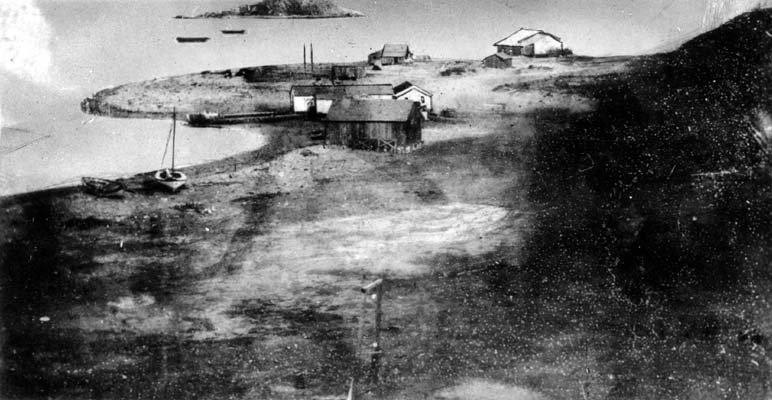 |
|
| (1850)* - View of what is now the San Pedro Harbor in a 1850 daguerreotype (silver copper plate process photo). The old landmark, Deadman's Island is in the background (it was removed in the 1920s to expand the harbor). |
Historical Notes In 1542, Juan Rodriquez Cabrillo discovered the "Bay of Smokes". The south-facing San Pedro Bay was originally a shallow mudflat, too soft to support a wharf. Visiting ships had two choices: stay far out at anchor and have their goods and passengers ferried to shore; or beach themselves. San Pedro was named for St. Peter of Alexandria, a Fourth Century bishop in Alexandria, Egypt. His feast day is November 24 on the local ecclesiastical calendar of Spain, the day on which Juan Rodriguez Cabrillo discovered the bay in 1542 which would be known as San Pedro. Santa Catalina Island, named after Catherine of Alexandria, was claimed for the Spanish Empire the next day, on her feast day, November 25.*^ |
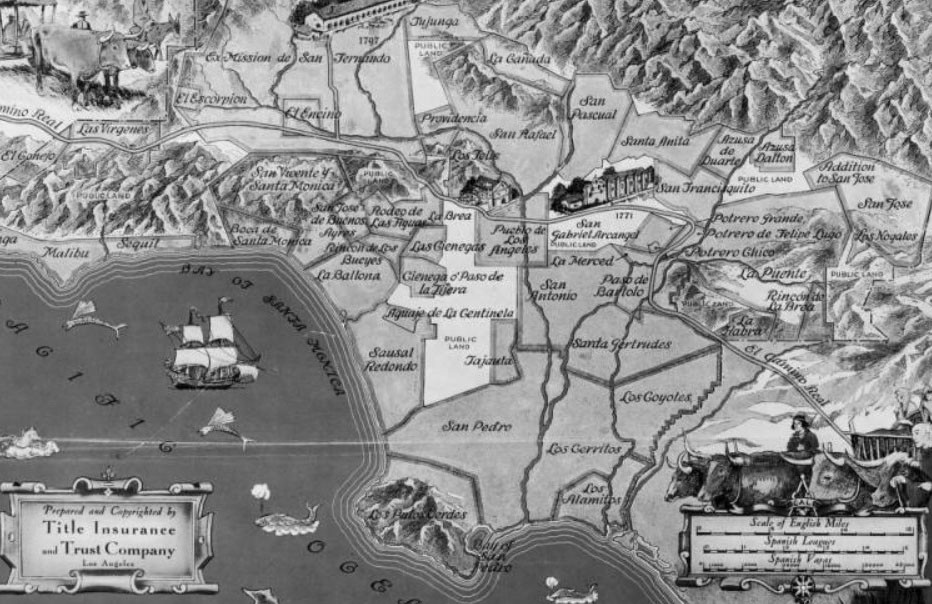 |
|
| (1919)^^ - Map showing the old Spanish and Mexican ranchos of Los Angeles County. In the lower center can be seen Rancho San Pedro sitting between Rancho Los Cerritos and Rancho Palos Verdes. |
Historical Notes Juan Jose Dominguez (1736–1809), a Spanish soldier, arrived in San Diego, California in 1769 with Fernando Rivera y Moncada and served with the Gaspar de Portolà expedition, and along with Junípero Serra, traveled to San Juan Capistrano, San Gabriel and Monterey. In 1784, Dominguez was granted a concession of seventeen Spanish leagues or 75,000 acres from the Spanish Empire. Dominguez's original grazing permission stretched from present-day Compton to the Palos Verdes Peninsula, but did not become a title to land until it was "re-granted" in 1822 in the Mexican era to Juan Jose's nephew and heir, Cristobal Dominguez. Cristobal died soon afterward, but his three sons settled on the ranch, building adobe homes. The following year Manuel Dominguez, eldest son of Cristobal Dominguez, married Engracia Cota and commenced a successful career raising cattle and serving in a variety of elected and appointed offices in Los Angeles. |
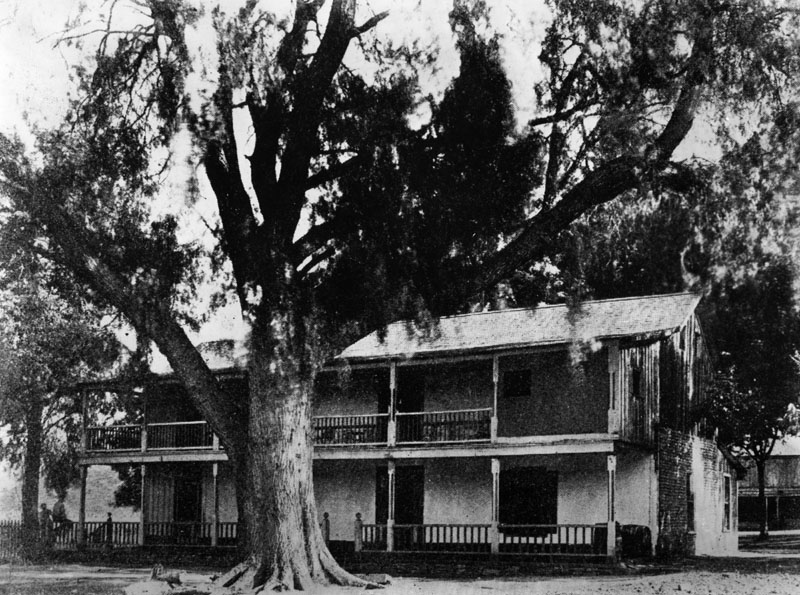 |
|
| (n.d.)* - Exterior view of a two-story adobe home of Don Diego Sepulveda, erected in 1853. Location: 700 block of Channel St, San Pedro. |
Historical Notes In 1851, the 21-yr old Phineas Banning, arrived in the tiny port of San Pedro. At the time the port consisted of just a shack and rickety pier owned by the Sepulveda family, wealthy Californios who also operated a primitive stage coach line to the pueblo, 20 miles away. It wasn’t long before the energetic young Anglo saw visions of fleets of wagons and an international port. He’d make both dreams come true.^**^ This adobe home, built by Diego Sepúlveda in the 1850s, was the first two-story Monterey-type adobe built in Southern California. The site of Diego Sepulveda's home was designated California Historical Landmark No. 380 (Click HERE to see complete listing).*^* |
 |
|
| (1800s)* - George H. Carson standing on the far right, and Mrs. Carson on the far left, at the Dominguez adobe. |
Historical Notes Mrs. Carson’s father was Don Manuel Dominguez, a wealthy sheep raiser, who inherited the Rancho San Pedro of 24,000 acres from his father, Don Christobal Dominguez, a commissioner of Spain, who had inherited it from his uncle, Don Juan Jose Dominguez, to whom the property had been granted by the Spanish throne. In 1839, Don Manuel Dominguez was elected Second Alcalde of Los Angeles; In 1843 he became prefect from the second district of California, and in 1849 he was a delegate to the Constitution Convention of California. George H. Carson was a native of Illinois, who saw service in the Mexican War under Colonel Newberry. At the close of that struggle he went to Los Angeles, establishing himself in the hardware business, in which he remained until his marriage in 1857, when he turned his attention to the direction of his wife’s interest in the San Pedro Ranch.^#^# Upon Manuel’s death in 1882, and the passing of his wife one year later, the Rancho lands were partitioned among his six surviving children, all daughters. Three of the married daughters continued the Dominguez legacy through the Carson, Del Amo and Watson families.^^^# |
 |
|
| (ca. 1800s)* - Another view of the Dominguez home in Wilmington during the 1800s. There are people standing near the fence at left. The residence contains two structures, which appear to be made of adobe. |
Historical Notes Phineas Banning acquired the land that would become Wilmington from Manuel Dominguez, heir of the original concession holder Juan Jose Dominguez, in 1858 to build a harbor for the city of Los Angeles. Wilmington was known as New San Pedro from 1858 to 1863, when it became the city of Wilmington. It was named by “Father of the Harbor” Phineas Banning after his Delaware birthplace.*^ |
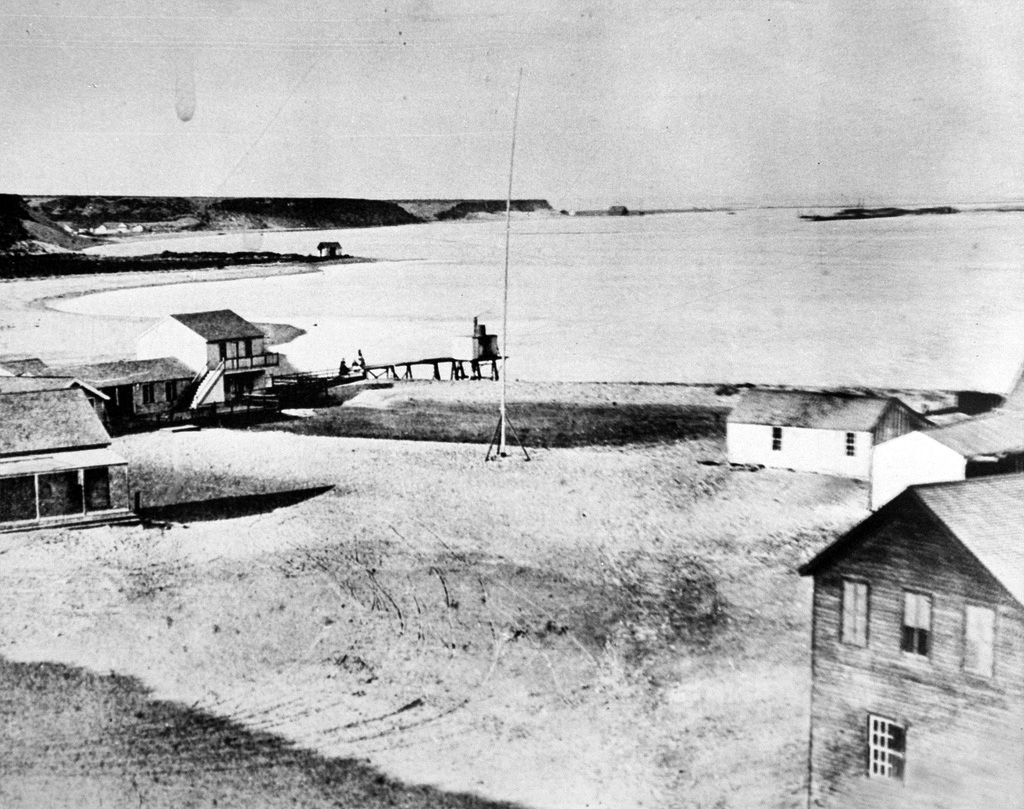 |
|
| (ca. 1865)#^ - At the south end of Los Angeles in the 1800s was a mudflat. By 1868 it would be named Timms' Landing and some historians consider it the first Port of Los Angeles. Timms' Landing was surrounded by vast areas of tidal flats and marshes. |
Historical Notes In 1852, German immigrant Augustus W. Timms obtained Sepulveda's Landing on the mudflats near here. He built a wharf, added a warehouse, corral and other facilities to service shipping and the running of stages to Los Angeles. Timms was a pioneer in the development of the harbor and for over fifty years this area was known as Timms' Point.*^* Timms' Point was designated California Historical Landmark No. 384 (Click HERE to see more Early California Historical Landmarks). |
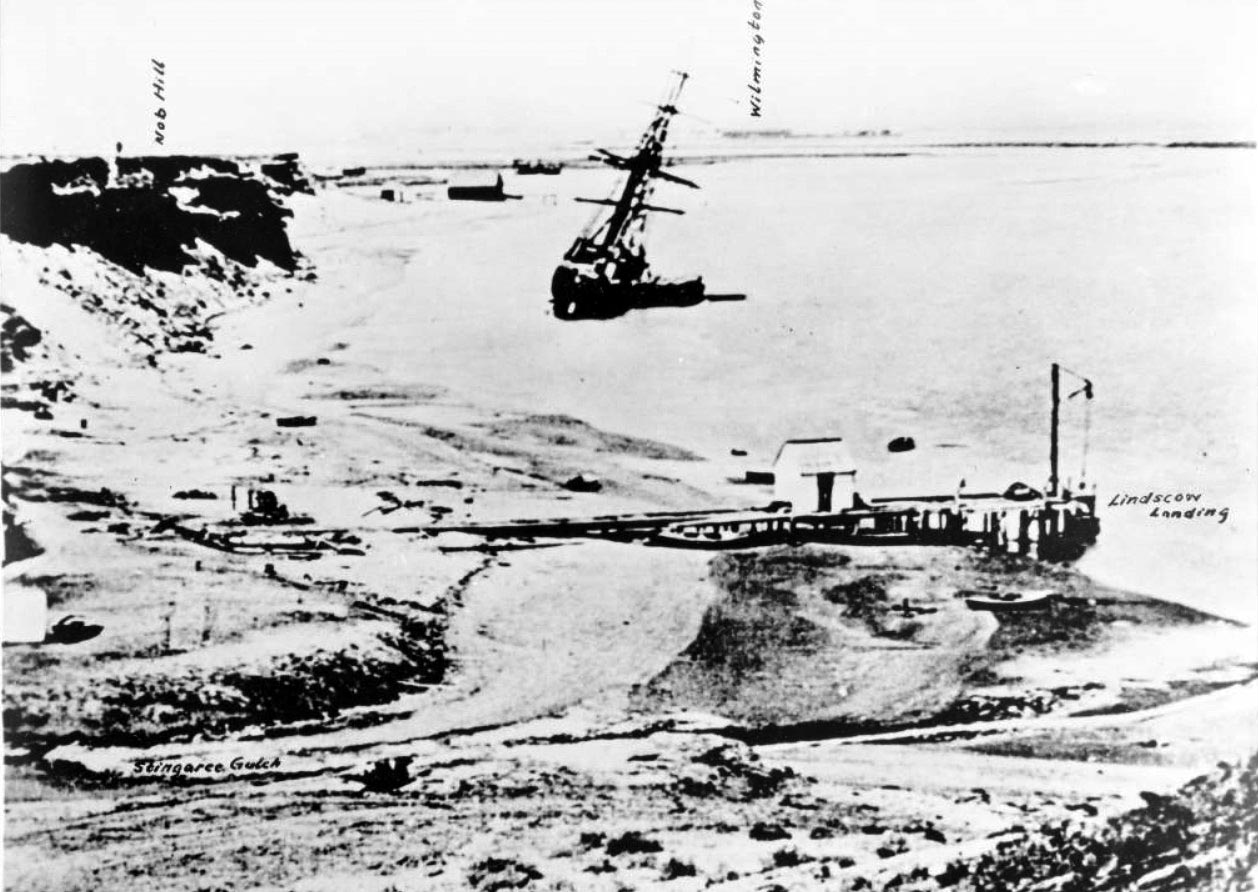 |
|
| (1870s)^^ - View of San Pedro Harbor showing a ship that has run aground in the bay at center, capsizing to the right. Handwriting on the image identifies the wharf and shack in the right foreground as Linscon Landing, the depression in the left foreground as Stingaree Gulch and the elevation in the right background as Nob Hill. It also identifies a faint line on the horizon as the community of Wilmington. |
Historical Notes The ship aground might also be unloading cargo using lighterage, the practice of unloading the cargo from a ship first to a lighter vessel, and then finally to the docks. The harbor at Wilmington did not have a deep-water channel running directly to the docks. The lack of a good deep-water harbor was a great handicap to Los Angeles until the Port of Los Angeles was constructed in the 1900s.^^ |
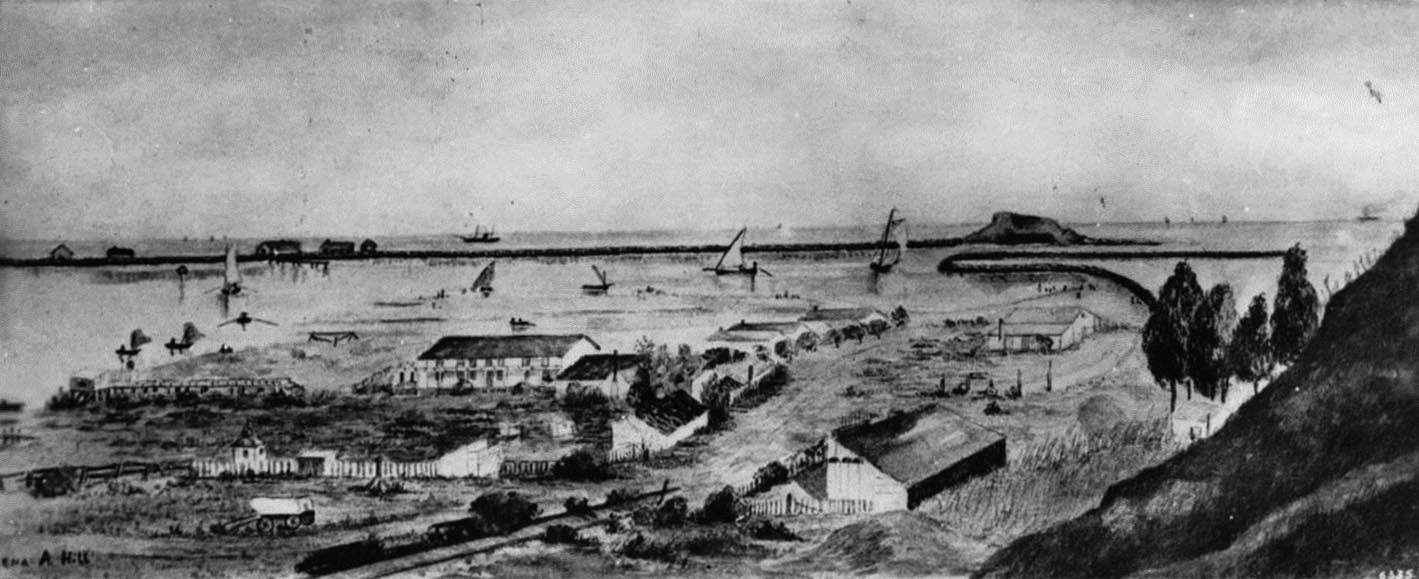 |
|
| (ca. 1875)^^ - Photograph of a painting of San Pedro depicting Timms' Point, Terminal Island and Dead Man's Island. At center the inlet is shown with four sailboats of varying sizes spread from left to right across it with smaller, non-sail boats interspersed among them. In the foreground, three structures are visible: a two-story craftsman-style building at center, as well as both a small booth-sized shack (also to the center) and a larger, roofless shack to the right. Short picket fences line parts of the area of each structure and an unhitched wagon sits in an empty lot in the foreground near the smaller shack. In the background, Dead Man's Island can be seen along with a breakwater peppered by small one-story buildings. |
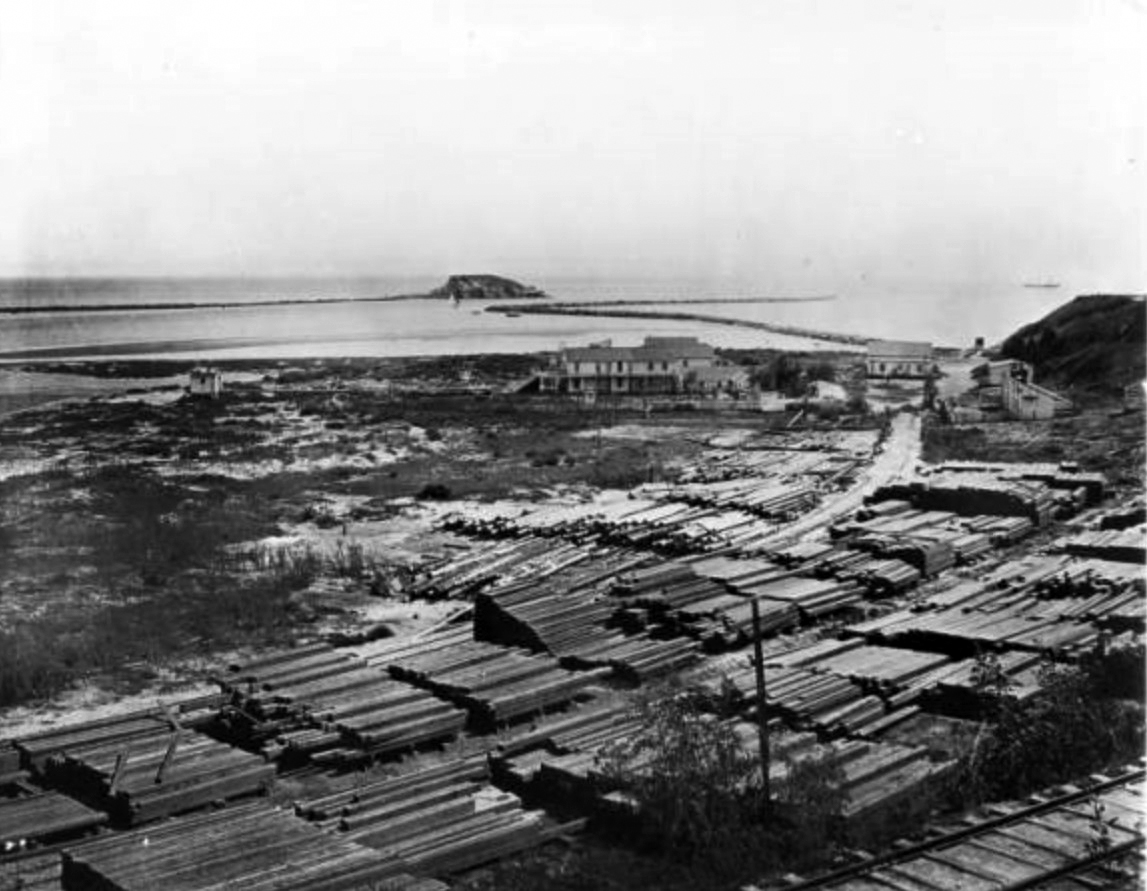 |
|
| (1876)#* - View of San Pedro Harbor from Timms' Landing, looking southeast from what would now correspond with the Southern Pacific Slip (Berth 73). Deadman's Island is in the distance, with dwellings and stacks of lumber near railroad tracks in the foreground on Timms' Landing. |
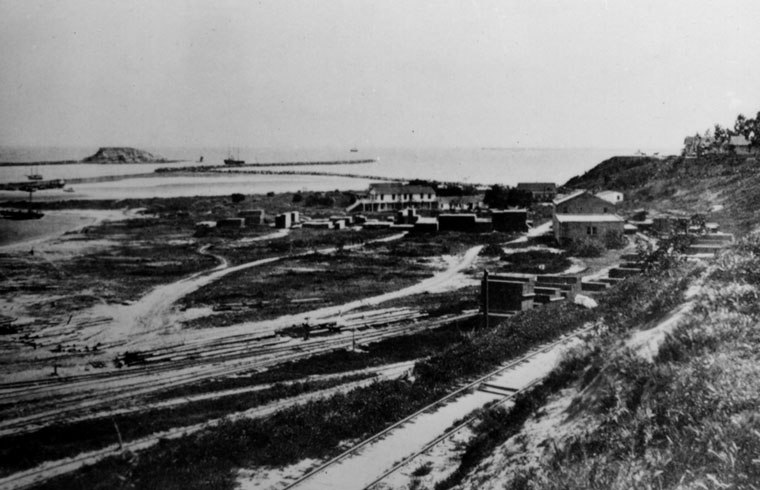 |
|
| (ca. 1870s)* - View of Timms' Point, Los Angeles Harbor. Breakwaters and Deadman's Island can be seen in the background. |
Historical Notes In 1857 the Dominguez family sold Phineas Banning a large parcel of land at the head of the slough northeast of San Pedro. Banning started a settlement called New San Pedro, then in 1859 changed the name to Wilmington after his birthplace. He also built a wharf, warehouses, a lumber yard and built lighters and a steamboat. Wilmington soon eclipsed Timms' Wharf and became the center of the shipping industry in San Pedro Bay. Banning bought stages and wagons to carry passengers and freight from San Pedro to Los Angeles, San Bernardino, and even as far as Yuma and Salt Lake City.*^*^ |
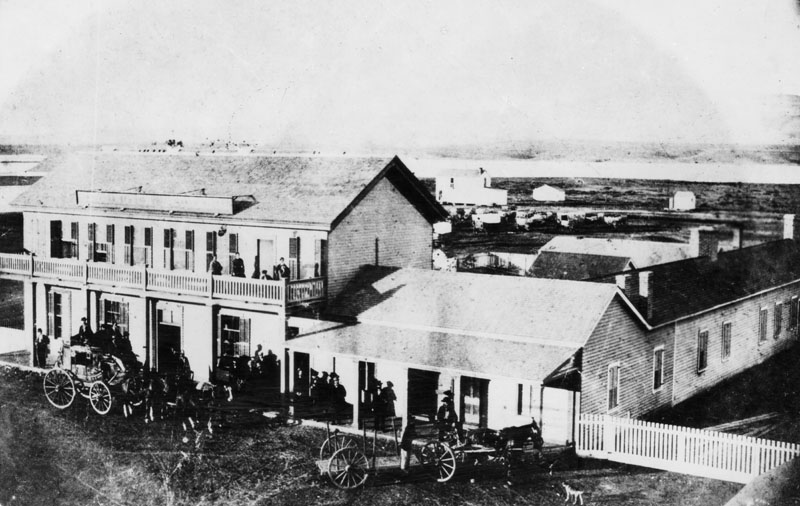 |
|
| (ca. 1865)* - View of the Wilmington Exchange building, hotel and stage station to Los Angeles before the railroad on Canal Street (now Avalon Boulevard). In the front of the hotel is a 4-horse stagecoach with passengers. |
Historical Notes In 1863, the Wilmington Exchange Hotel was built and was the first hotel in Wilmington. Phineas Banning’s first Wilmington home was the single-story building attached to the hotel (as seen above).**^ Besides operating a freighting business, Banning operated a stage coach line between San Pedro and Wilmington, and later between Banning, California, which was named in his honor, and Yuma, Arizona.*^ |
The Los Angeles & San Pedro Railroad (1st in Southern California)
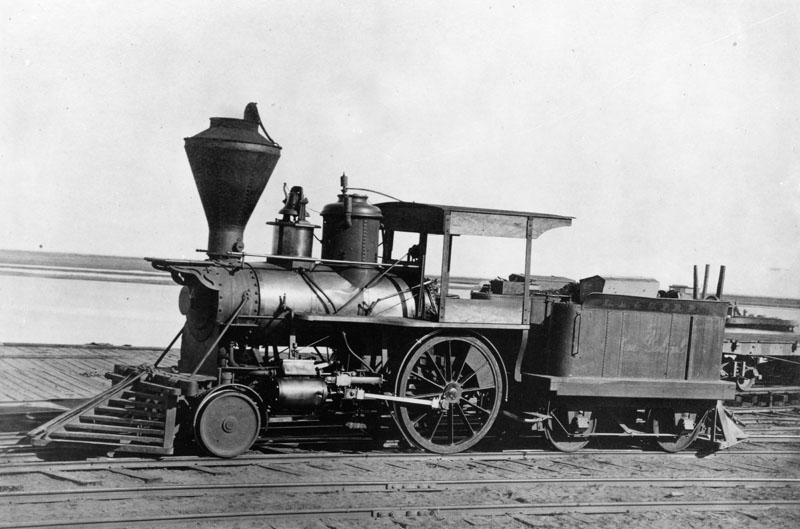 |
|
| (ca. 1868)* - View of locomotive "San Gabriel", the pioneer locomotive of Los Angeles County. It landed at Wilmington Harbor in December of 1868. |
Historical Notes The Los Angeles & San Pedro Railroad was Southern California's first railroad. Its 21-mile line from San Pedro Bay to Los Angeles was built from 1868 to 1869 and began operations on October 26, 1869. The railroad was the brainchild of Phineas Banning and its primary purpose was to transport freight from the port to the city. As a California state senator, Banning sponsored a bill authorizing the City and County of Los Angeles to finance construction of the railroad between Los Angeles and San Pedro. The city and county obliged--and then awarded Banning the contract to construct the line. The new 21-mile line connecting Los Angeles with the new shipping harbor at San Pedro Bay was built between 1868 and 1869. The Los Angeles & San Pedro Railroad was purchased by the Southern Pacific Railroad in 1873.* |
.jpg) |
|
| (ca. 1870)* - View of the L.A. & San Pedro R.R. stopped at a railroad station. |
Historical Notes The new Banning built railroad slashed the cost of transporting goods and passengers to and from the ships at San Pedro. Local merchants and farmers--not to mention port operators like Banning--benefited almost immediately. The railroad charged $6 per ton to transport inbound dry goods to the city. Outbound grain cost $2.50 per ton to ship, and passengers could buy a one-way ticket to the port for $1.50. Total commerce at the harbor more than doubled from 26,000 net tons of freight in 1869 to 55,000 in 1871.*#* |
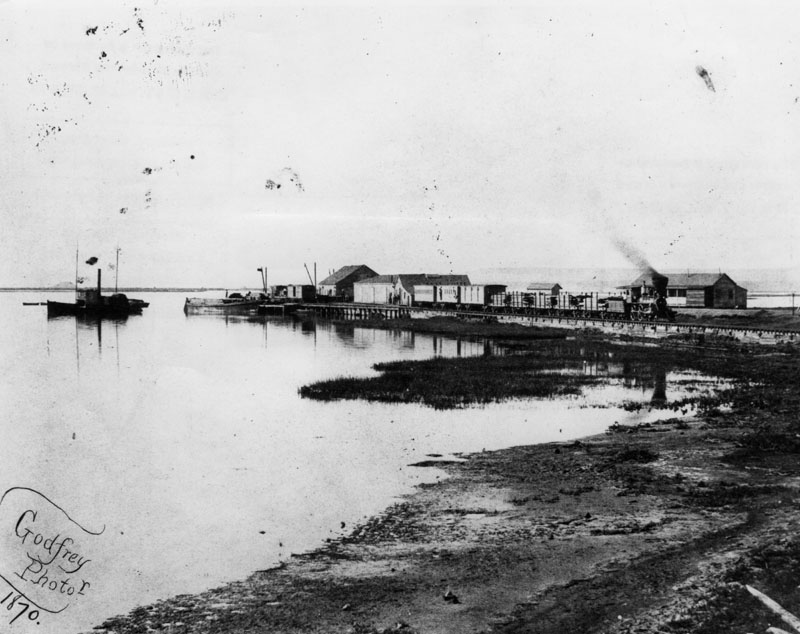 |
|
| (1870)* - View of Wilmington harbor in 1870, showing the Los Angeles and San Pedro Railroad, which had been completed by Phineas Banning in 1869--the first railroad to the harbor. Before that, freight was transported to Los Angeles by ox carts and later by horse-drawn wagons. |
Historical Notes Still relatively undeveloped, the harbor did not offer deep-water access, forcing merchants to send small boats and rafts to meet cargo-carrying ships at anchor in the bay. This method was particularly cumbersome in transporting lumber which, as a result of the growing towns surrounding San Pedro, was in enormous demand.*^^ |
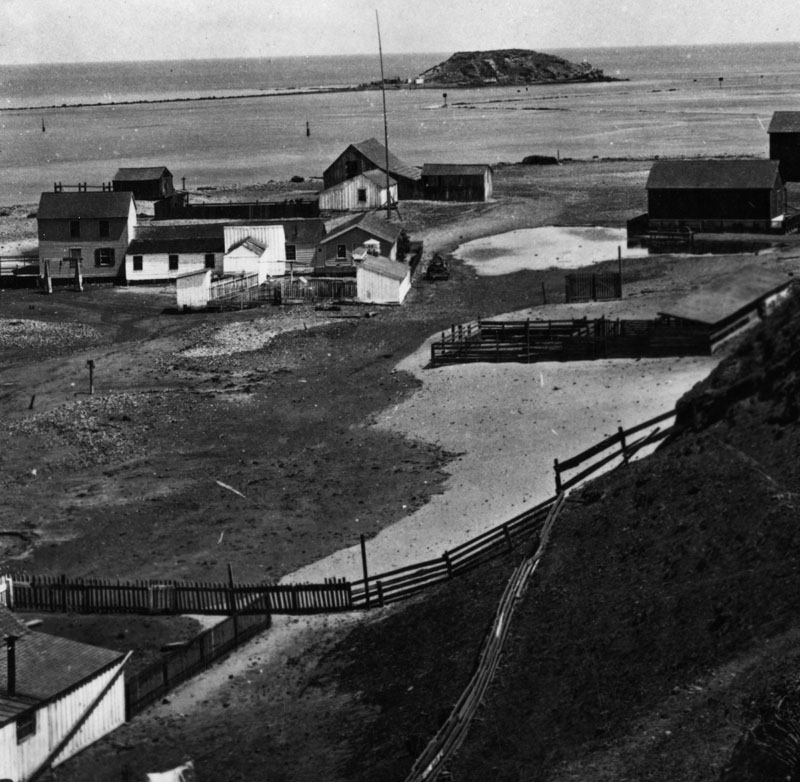 |
|
| (1873)* - Early view of Deadman's Island, shows some of the houses on the island. Breakwaters can be seen in the distance. |
Historical Notes In the late 1860's Banning realized that for San Pedro Harbor to become a center of commerce, that three things needed to be accomplished: Building a railroad, constructing a breakwater, and dredging the harbor to accommodate large ships and to allow them to dock directly at the wharfs. In October 1869, construction was completed on the Los Angeles and San Pedro Railroad, Southern California's first railroad. On March 2, 1871, Congress voted an appropriation for construction of a rock jetty from the lower end of Rattlesnake Island to Deadman's Island.**# In 1871, Phineas Banning greatly improved shipping when he dredged the channel to Wilmington to a depth of 10 feet. The port handled 50,000 tons of shipping that year.*^ |
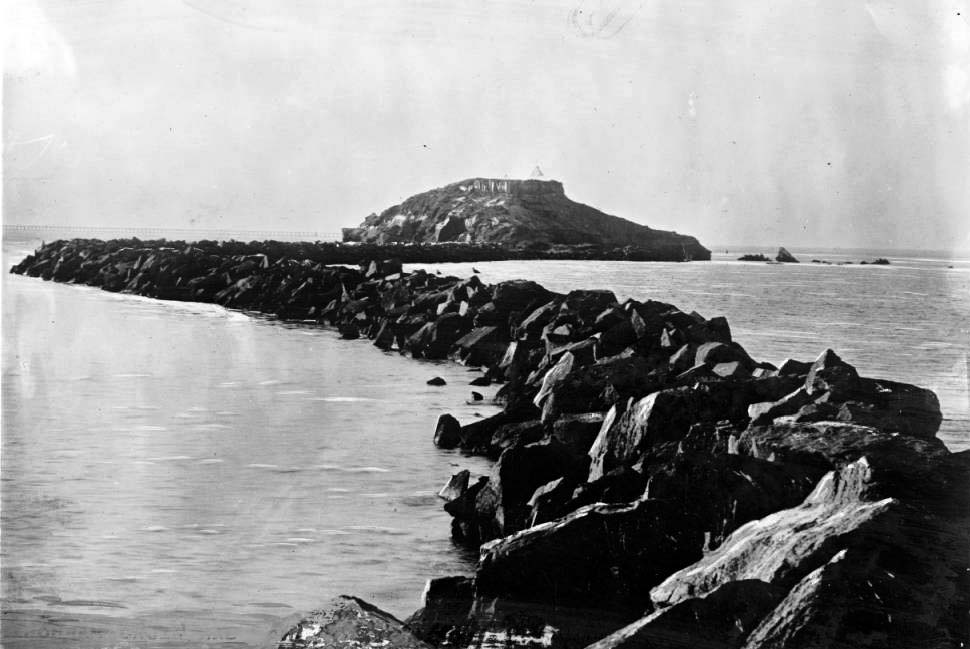 |
|
| (1870s)^^ - Photograph of a view of the San Pedro breakwater extending out of Deadman's Island. The jagged stone pilings of the breakwater can be seen snaking out from the right foreground, bowing out to the left, and returning right to meet up with the island, which is pictured at center. |
Historical Notes Deadman's Island was one of two islands near San Pedro in the 19th century. The land, sometimes referenced as Deadman's Island, Isla Del Muerto, and Reservation Point, was dredged away in 1928 as part of a harbor development effort. Rattlesnake Island, the other islet in the area, became Terminal Island.* |
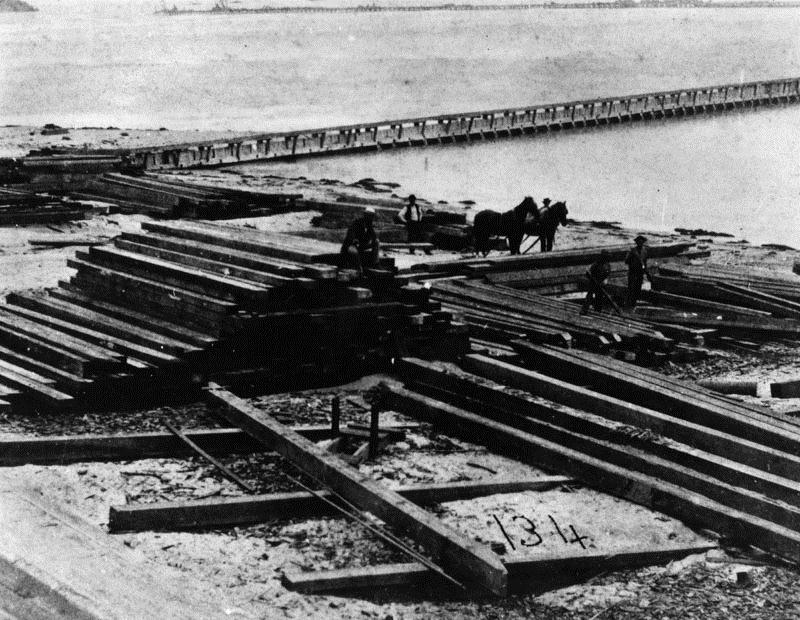 |
|
| (1876)* - Workers are building the breakwater at Wilmington in 1876, with help from a team of horses to move large beams. The structure of the breakwater extends into the sea. |
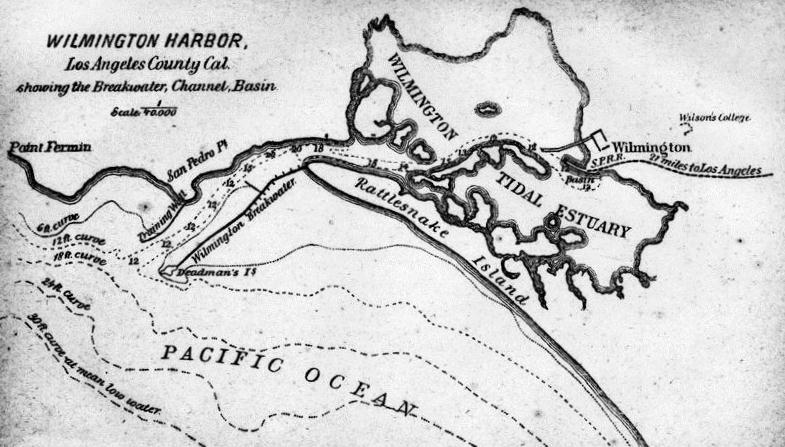 |
|
| (ca. 1880)* - Drawing of Wilmington Harbor, showing the breakwater, channel, basin and railroad tracks. Wilson's College (top right) was established in 1874 and existed in the early 1880's. |
Historical Notes Wilson College was a precursor to the University of Southern California. It opened in Wilmington in 1874 as the first coeducational college west of the Mississippi. Active for several years, it closed after the Methodist Church Conference received a large donation of land closer to Los Angeles and decided to develop on that site. Opened in 1880, that new college would become the University of Southern California. The next college to open in Wilmington was Los Angeles Harbor Junior College in 1949, an institution that became an important link in the state junior college system.**^ |
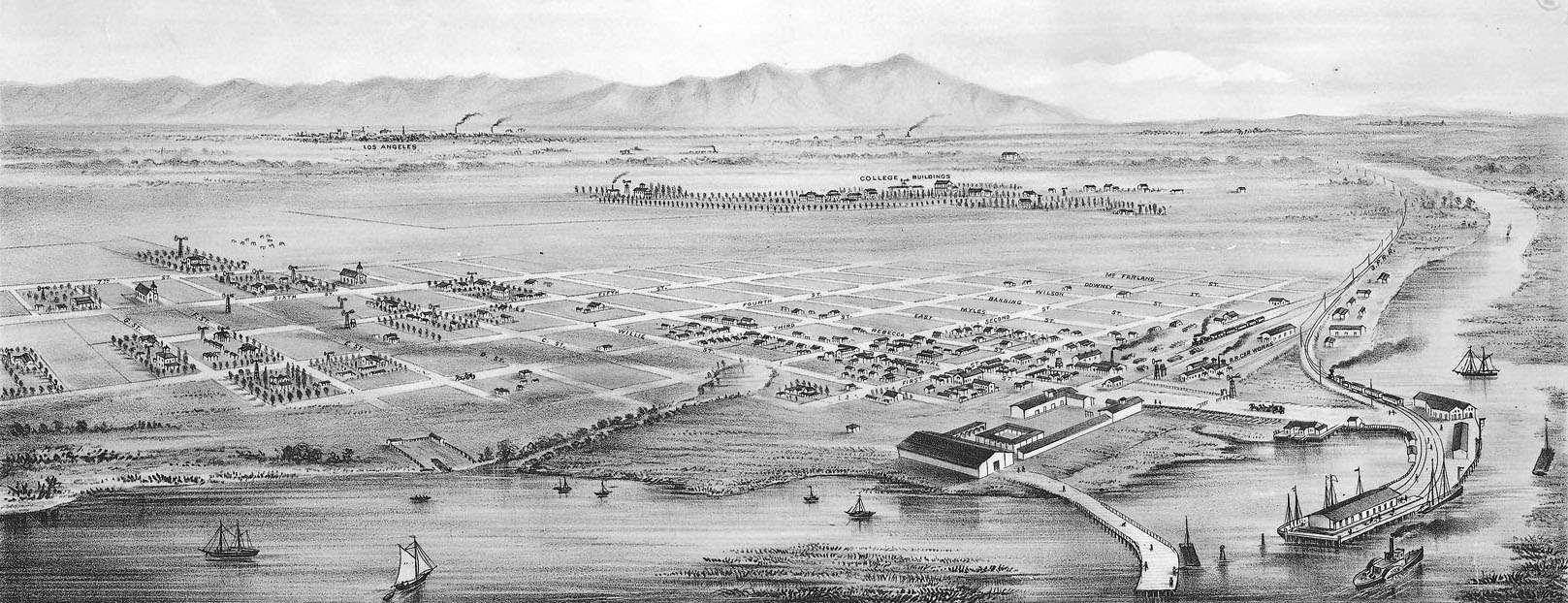 |
|
| (1877)* - Drawing of a bird's eye view of Wilmington looking north from Wilmington Harbor to the Sierra Madre Mountains, 30 miles distant. In the lower right can be seen the ocean terminus of the Southern Pacific Railroad, 23 miles from Los Angeles. |
Historical Notes In 1873 both the City and County of Los Angeles gave their holdings in the Los Angeles & San Pedro Railroad plus $600,000 to the Southern Pacific Railroad (SP) in return for having SP agree to run their railroad through Los Angeles. This move was believed to be necessary for the economic viability and growth of the City. The Los Angeles and San Pedro Railroad would now become the Southern Pacific Railroad. In 1876 the Southern Pacific would terminate their second transcontinental railroad in Los Angeles County.*^^ |
 |
|
| (ca. 1880)* - Drawing of the Dominguez family Rancho San Pedro. A railroad line passed through. |
Historical Notes The Rancho San Pedro is the site of the First Spanish land grant in California. The land was granted in 1784 by King Carlos III to Juan Jose Dominguez, a retired Spanish soldier who came to California with the Portola expedition and later with Father Juniperro Serra. The original land grant encompassed 75,000 acres, including the entire Los Angeles harbor. The land has passed through successive generations and remains in the Dominguez family. Today, the descendants operate the Watson Land Company and the Carson Estates Company on the original Rancho land.^^^# The Dominguez family Rancho San Pedro was designated California Historical Landmark No. 152 (Click HERE to see complete listing). Also, in 1976 it was placed on the National Register of Historic Places by the United States Department of the Interior. |
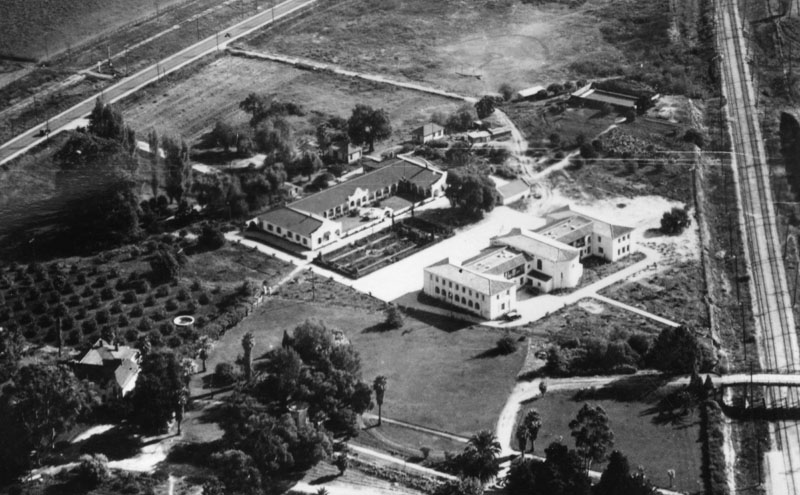 |
|
| (n.d.)* - Aerial view of the restored Dominguez adobe and the Claretian Seminary across the way on Rancho San Pedro. |
Historical Notes Upon Manuel Dominguez's death in 1882, and the passing of his wife one year later, the Rancho lands were partitioned among his six surviving children, all daughters. Three of the married daughters continued the Dominguez legacy through the Carson, Del Amo and Watson families. All of the daughters made major donations to the construction of St. Vibiana’s, the former Cathedral in downtown Los Angeles. In 1922, the two remaining daughters, Susana Del Amo and Reyes Dominguez, deeded seventeen acres adjacent to the family home to the Claretian Missionaries. In 1924, the Claretian Missionaries began using the adobe home as a graduate school for Claretians and later as a seminary. In recognition of this contribution to the Claretians, special arrangements were made to allow Susana and Gregorio Del Amo to be buried in a crypt beneath the altar of the chapel located in the modern day Claretian retirement home.^^^# |
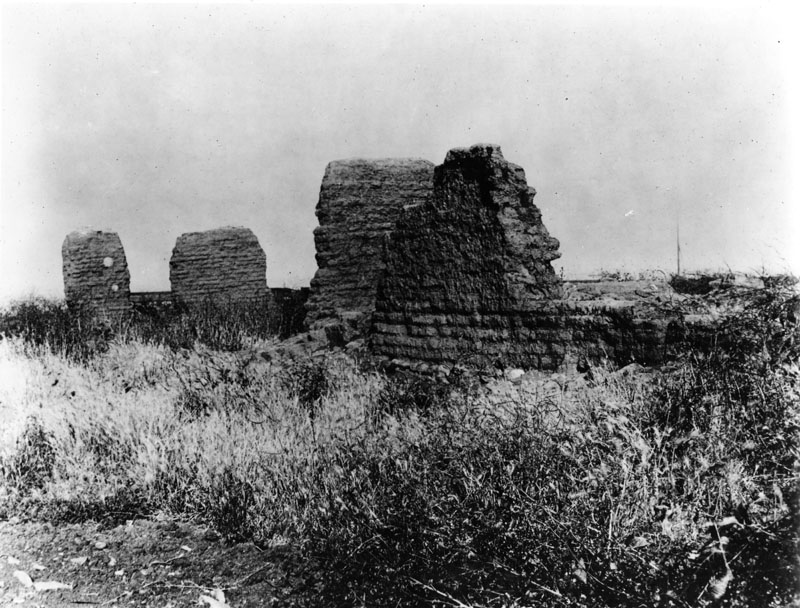 |
|
| (1900)* - In 1829 the Hide House was sold to Mission San Gabriel and five years later it was acquired by Abel Stearns and became known as Casa de San Pedro. Ruins of the Hide House, Casa de San Pedro, stood on the military reserve (Fort MacArthur). Location: Middle Reservation, Fort MacArthur, 2400 block of Pacific Ave, E side of parade field, 300 feet S of intersection of Meyler and Quartermaster Rds, San Pedro. |
Historical Notes The first known commercial structure on the shore of San Pedro Bay was built here in 1823 by the trading firm of McCulloch and Hartnell to store cattle hides from the San Gabriel and San Fernando missions. Richard Henry Dana described this adobe hide house in Two Years Before the Mast. Thus began the development of the Port of Los Angeles.*^* The Casa de San Pedro has been designated California Historical Landmark No. 920 (Click HERE to see complete listing). |
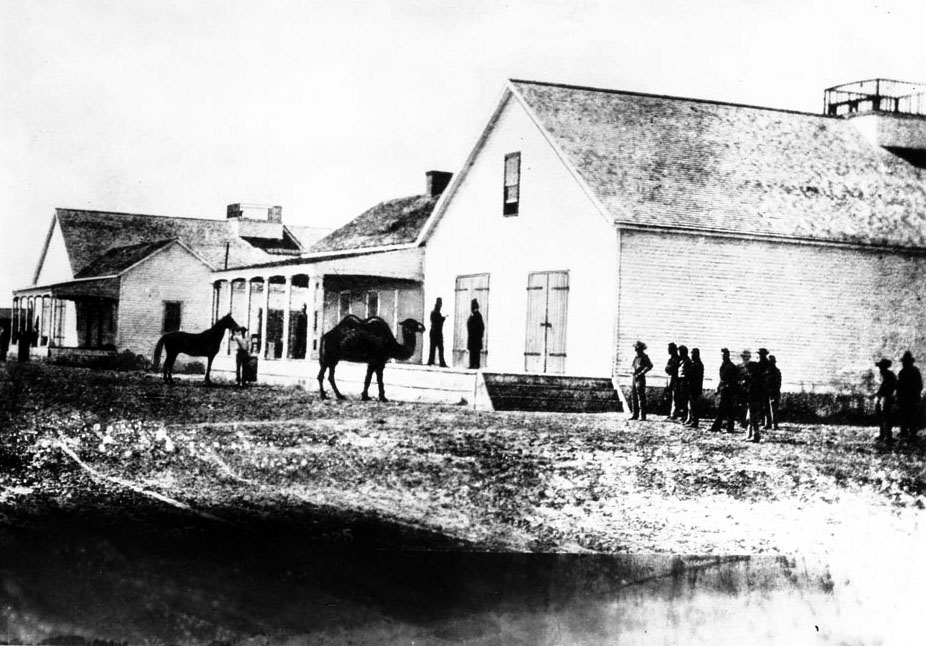 |
|
| (ca. 1865)^^ - Drum Barracks Warehouse with Camel in front ready for loading for trip to Arizona fort. |
Historical Notes During the Civil War, Phineas Banning ceded land to the Union Army to build a fort at Wilmington, the Drum Barracks. He was appointed a Brigadier General of the First Brigade of the militia, and used the title of general for the rest of his life.*^ Established in 1862, Drum Barracks became the United States military headquarters for Southern California, Arizona, and New Mexico. It was a garrison and base for supplies, and a terminus for camel pack trains operated by the Army until 1863. Abandoned in 1866, the site remains a landmark of the Civil War in California.*^* |
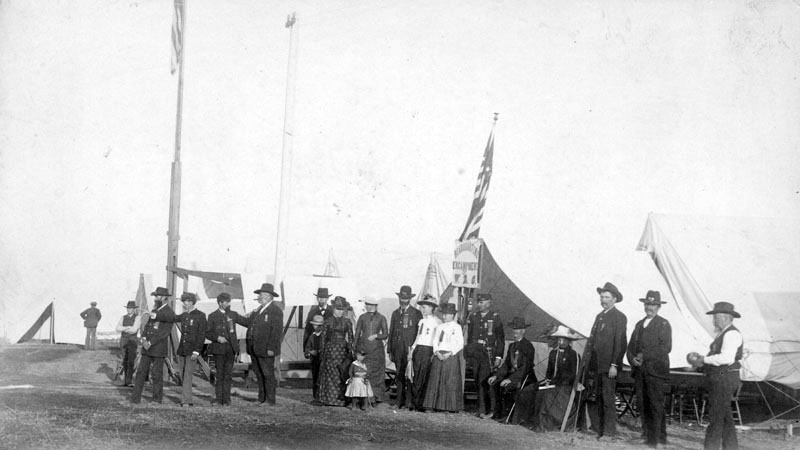 |
|
| (1889)* - Fort Drum Barracks (also possibly called Camp Burnside) encampment lasted from Aug. 10th to 19th, 1889. (Penciled on photograph are dates: 1861-1862) Photograph shows Commander Mudge, Adj't Myron F. Tarbel, comrade W. Savage among other uniformed men and women. Sign with a mounted flag reads: Headquarters encampment of W.R.C. Location: 1053 Cary St (corner Cary and Opp), Wilmington. |
Historical Notes Camp Drum and Drum Barracks get their name from Col. Richard Coulter Drum, then Assistant Adjutant General of the Army's Department of the Pacific, stationed in San Francisco, and not after a percussion instrument. There is no record that Col. Drum ever saw or set foot in the station bearing his name. During the Civil War, Camp Drum was the headquarters of the District of Southern California and the home to the California Column, commanded by Colonel James Henry Carleton. Between 2,000 and 7,000 soldiers were stationed at Camp Drum, and Wilmington became a thriving community with a population greater than Los Angeles during the war.*^ |
 |
|
| (ca. 1920)* - Fort Drum Barracks at Wilmington, which was built during the Civil War, 1051-1055 Cary Avenue. |
Historical Notes The surviving 16-room structure was the officers' quarters, which was once one of 19 similar buildings on the site. Today, the barracks is open as a museum which commemorates California's contribution to the Civil War. The building has been designated as Los Angeles Historic-Cultural Monument No. 21 (Click HERE to see complete listing).*^ The Fort Drum Barracks site, the only Civil War landmark in California, has been designated California Historical Landmark No. 169 (Click HERE to see more in California Historical Landmarks in Los Angeles County). |
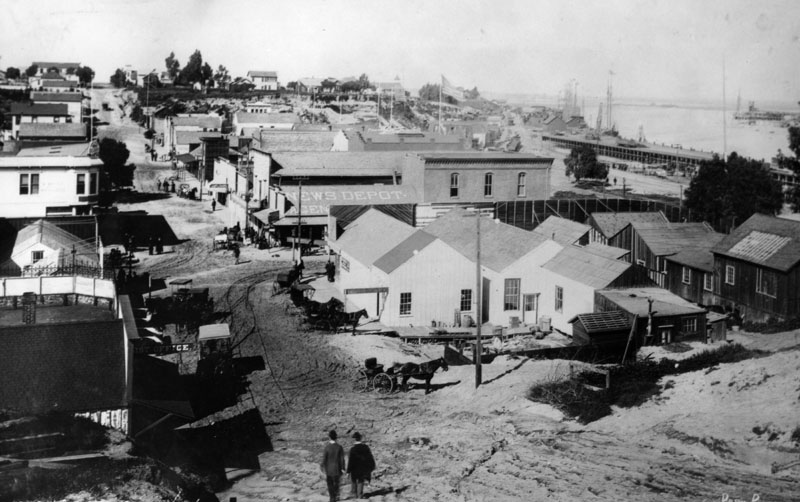 |
|
| (late 1800s)* - View of an unpaved road with horses and carriage in San Pedro. The harbor can be seen in the distance. |
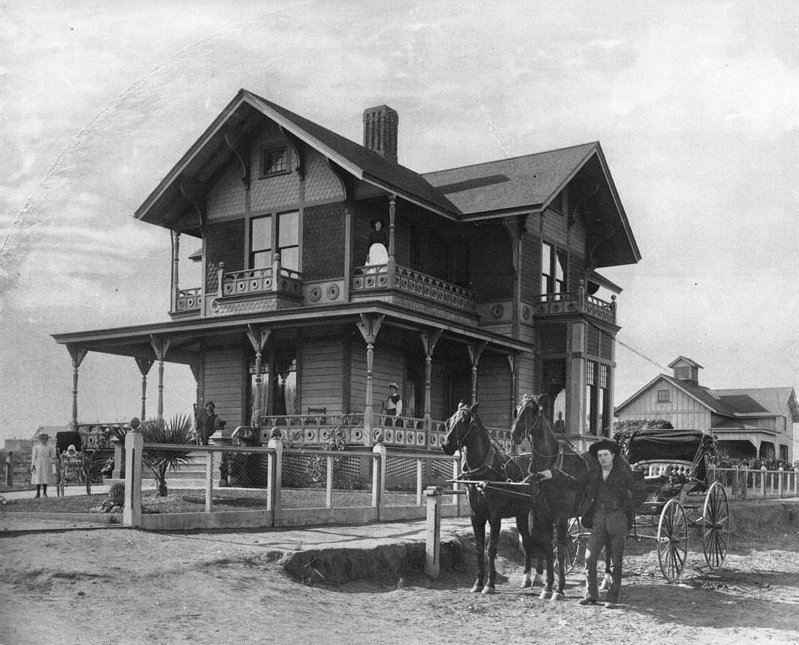 |
|
| (1880s)^^** - Home of merchant/postmaster James H. Dodson and his wife, Rudecinda Sepulveda. She is possibly the woman standing on the second floor balcony. |
Historical Notes The Victorian architecture style house was built in 1881 by the Sepulveda family as a wedding present for their daughter Rudecinda and her husband, James Dodson. It was originally located at the corner of 7th and Beacon Streets, San Pedro.*^ |
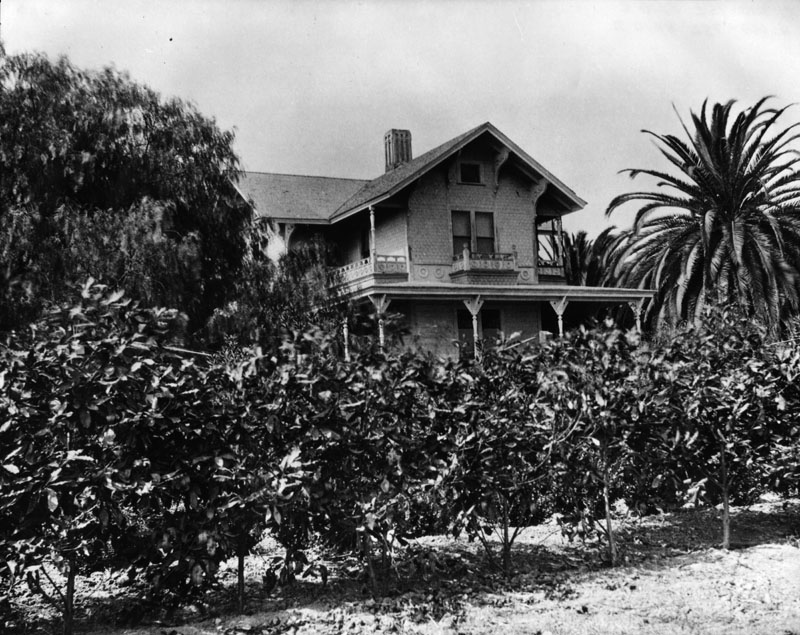 |
|
| (1890)* - A partial view of J. W. Dodson's residence can be seen above the small trees. |
Historical Notes In 1976, the James H. Dodson Residence was dedicated Los Angeles Historic-Cultural Monument No. 147 (Click HERE to see complete listing). The house is now located at 859 W. 13th St., San Pedro. It is a private residence and is not open to the public.*^ |
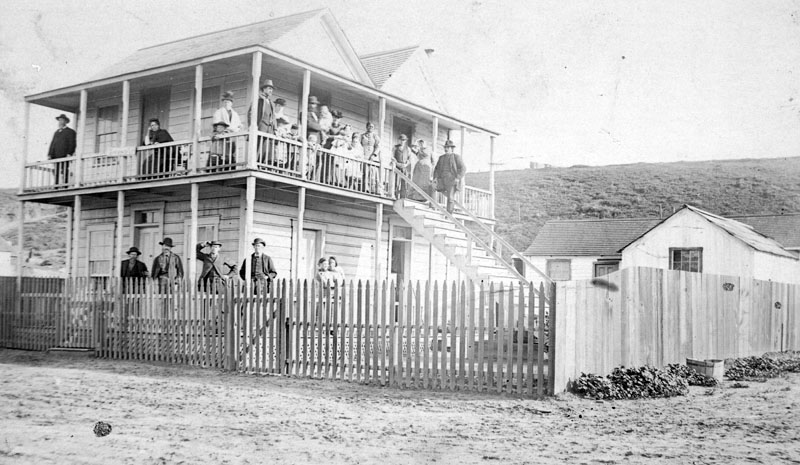 |
|
| (ca. 1890)* - Numerous people are seen outside of an unidentified two-story wooden building, which appears to be a boarding house or hotel, in San Pedro. |
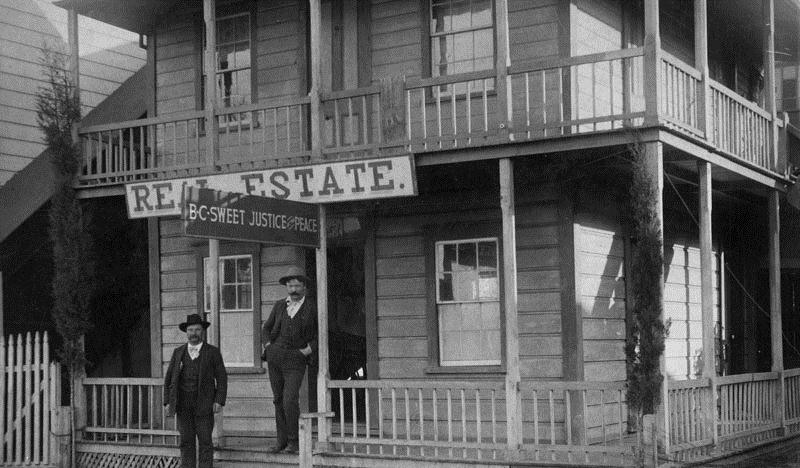 |
|
| (late 1800s)* - Two men are standing at the entrance of a real estate office in San Pedro. Additional sign above entrance reads: B.C. Sweet, justice of the peace. |
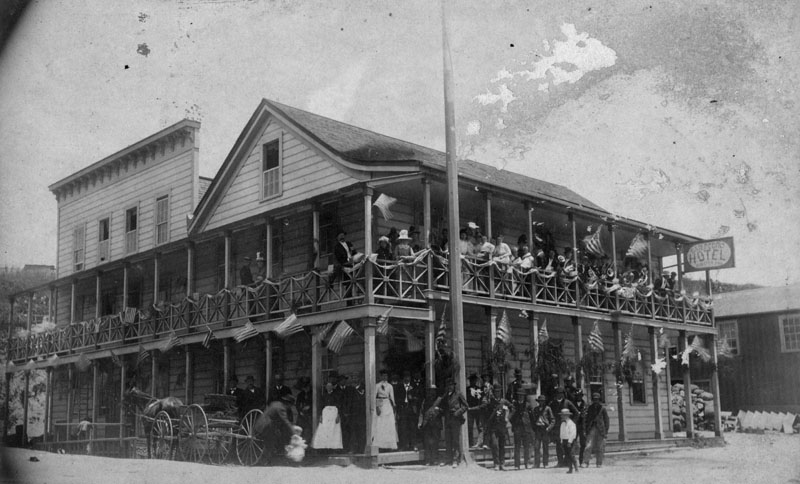 |
|
| (ca. 1898)* - Group portrait of people standing on the ground floor and along the balcony of the second floor of the San Pedro Hotel. Many flags are hanging around the hotel. A horse-drawn carriage is parked alongside the hotel. |
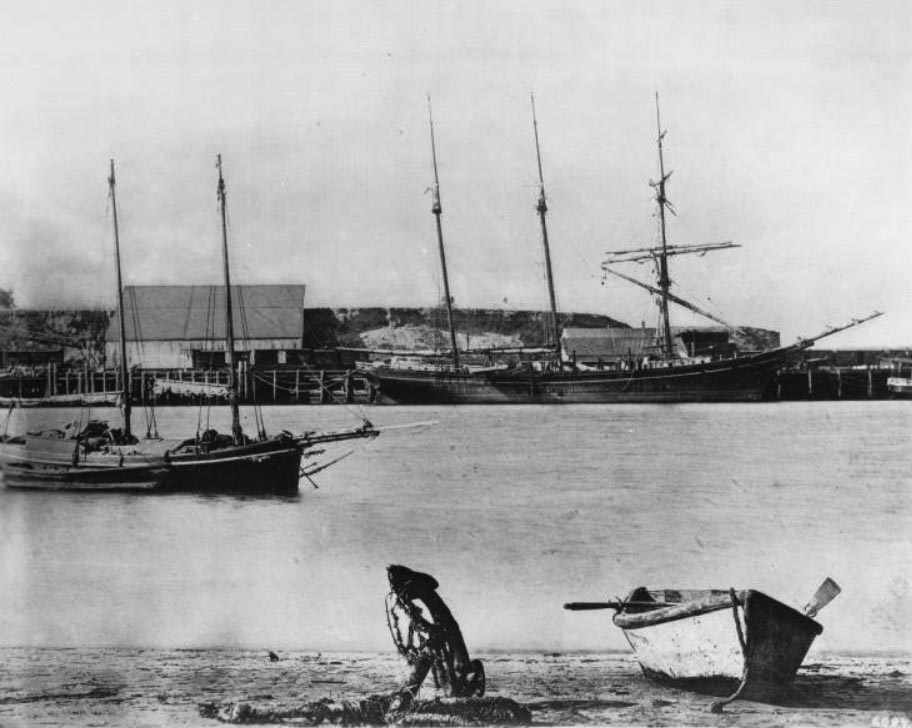 |
|
| (ca. 1885)^^ - View of San Pedro Harbor showing the shipping docks and, in the foreground, an orphaned anchor lying on the beach next to a rowboat. In the background are ships with their sails down, one of which is docked by the pier on the other side of the water. |
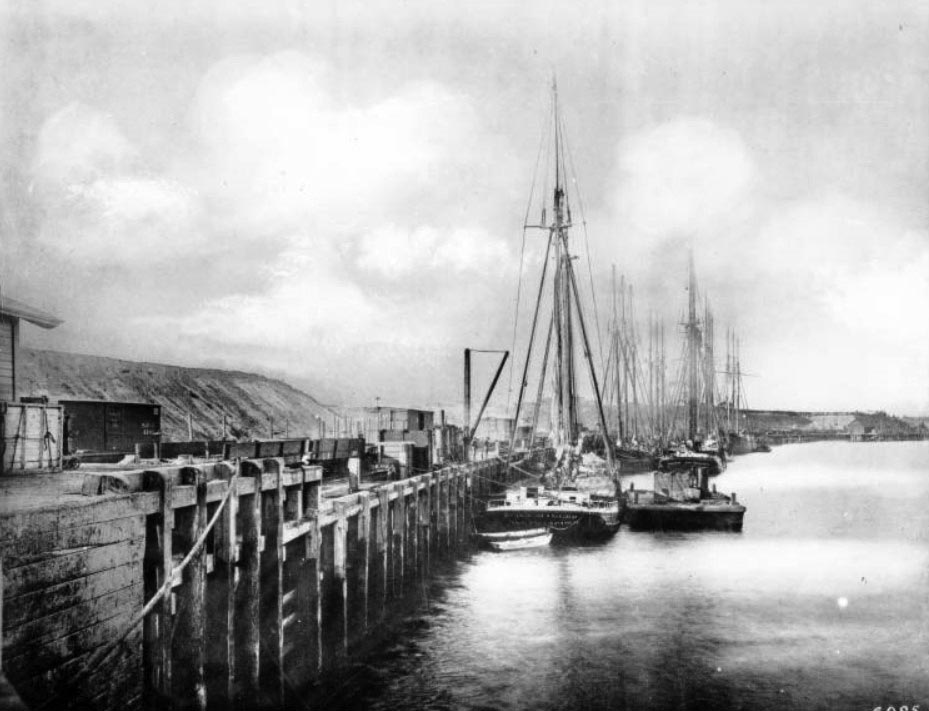 |
|
| (ca. 1885)^^ - Photograph of sailing ships tied up along the pier at San Pedro Harbor. The Eliza Miller from San Francisco is in the center. The ships are docked next to the pier in pairs and all of their sails are down. A Southern Pacific Railroad car is located on the pier to left. |
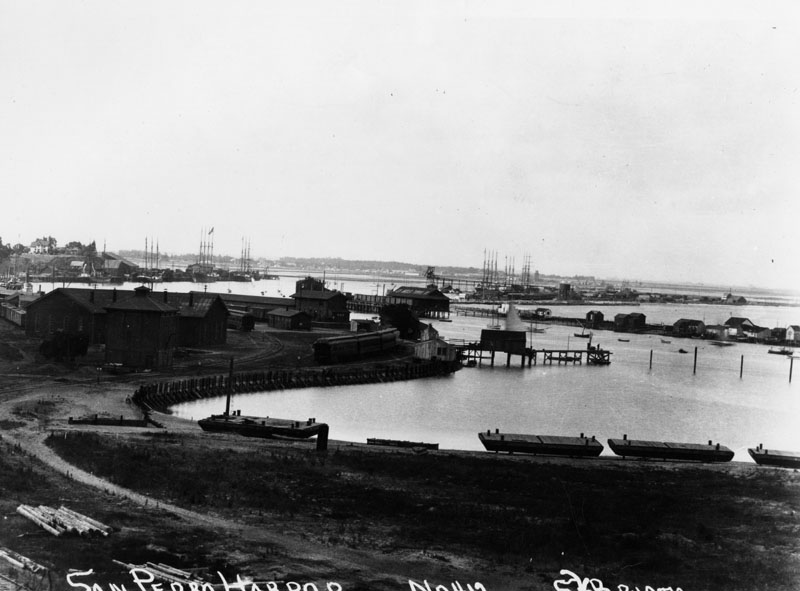 |
|
| (ca. 1890)* - Early view of San Pedro Harbor. Several ships can be seen anchored in the harbor. Train cars sit my a small wharf in the center of the photo. |
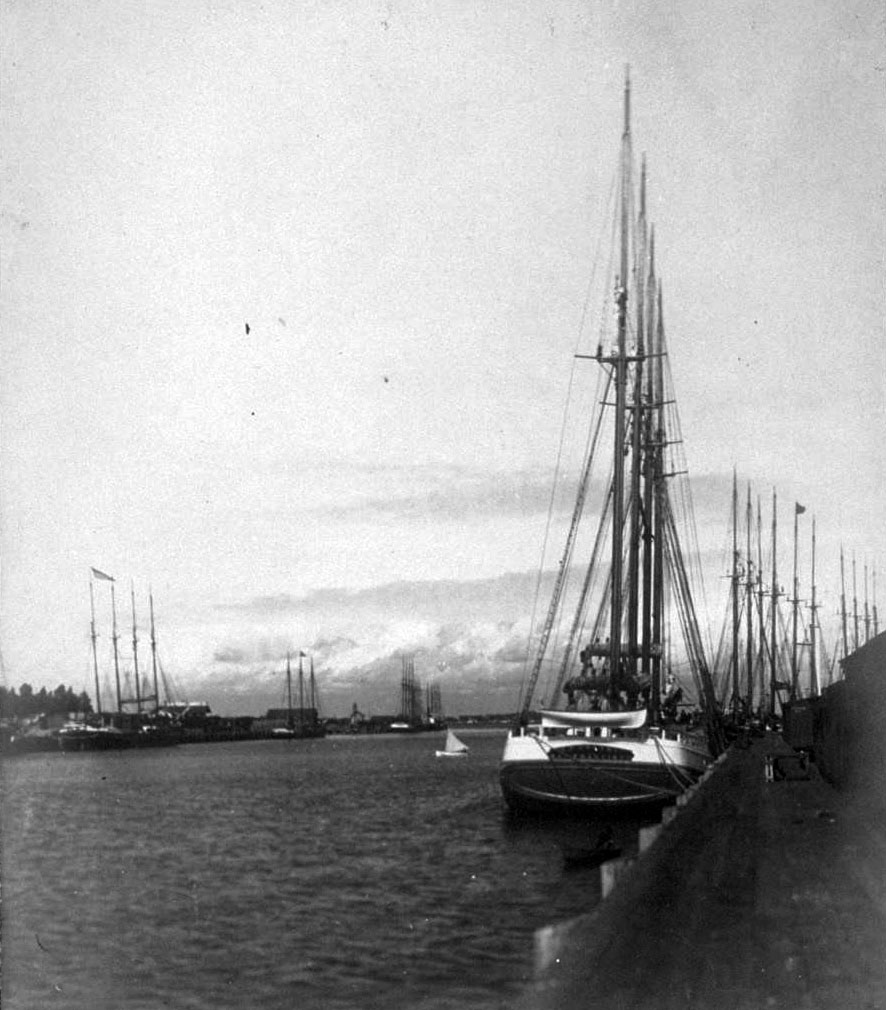 |
|
| (ca. 1890s)^#^^ - Close-up view of a crowded San Pedro Harbor, showing several “Tall Ships” docked along the wharf. |
 |
|
| (1885)^*- View of San Pedro Harbor showing two steam boats and a tall ship in the foreground with Deadman's Island seen in the distance. |
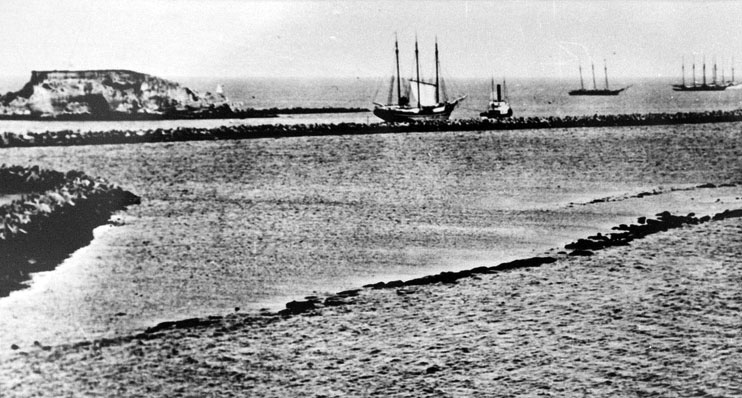 |
|
| (1880s)#^ - Every year freshwater floods would cause the harbor to fill with sediments. |
Historical Notes To solve the sediment problem two breakwaters were built during 1871-93. One connected Rattlesnake Island with Deadman's Island and the other jutted out from Timm's Landing towards Deadman's Island. Those breakwaters caused the tidal flows to scour the ocean floor removing sand and mud. The building of these breakwaters gave birth to the main shipping channel which is still in use today. |
Lumber in the Harbor
 |
|
| (ca. 1876)* - View of Deadman's Island and breakwaters in the background. Stacks of lumber is stored in a lumber yard (foreground). |
Historical Notes Lumber was one of the main imports into the San Pedro Harbor in the late 1800s and early 1900s due to the high demand for construction materials to support the rapid growth of Los Angeles. |
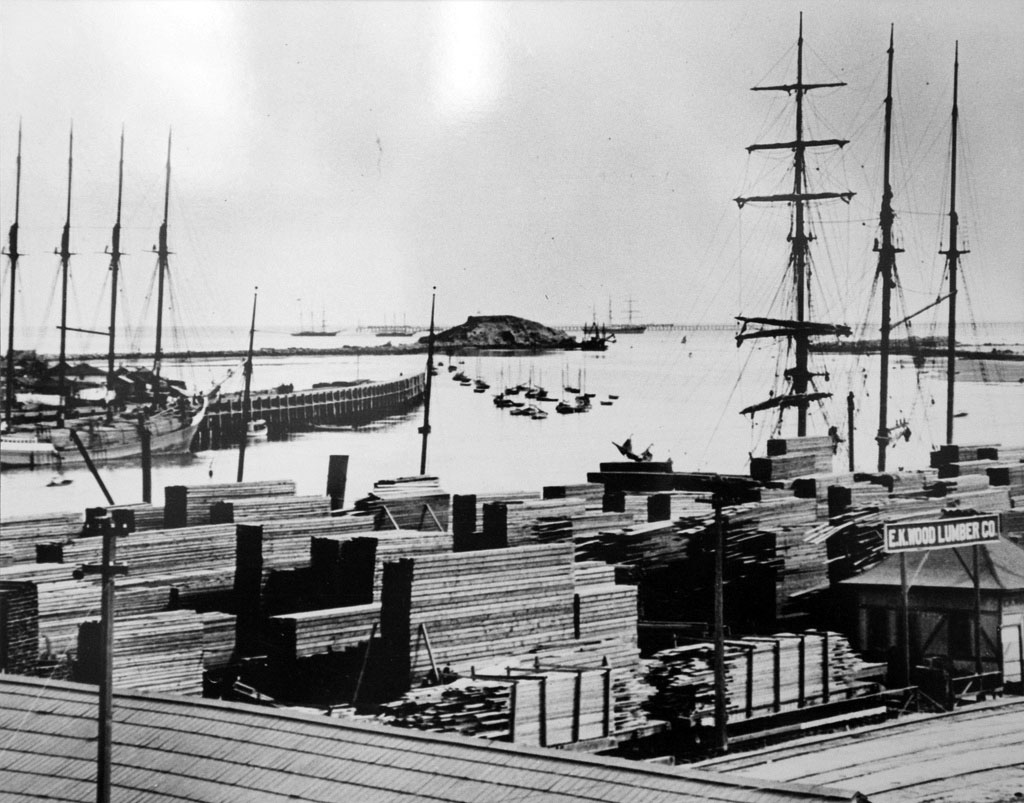 |
|
| (1880s)#^ - View of stacks of lumber sitting on the shore waiting to be transported to Los Angeles. |
Historical Notes Los Angeles grew rapidly and the need for building materials escalated. The harbor grew to meet this demand for handling ships filled with imported lumber. Wood's Lumber Company sits on what is now present day Ports o' Call. |
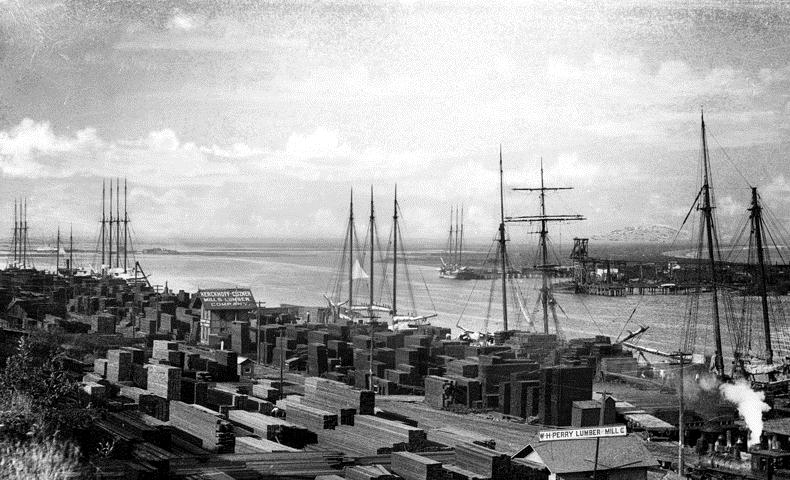 |
|
| (ca. 1888)*#* - Shipping in San Pedro Port of Los Angeles. Stacks of lumber can be seen sitting along the harbor waiting to be transported. |
Historical Notes In June and July of 1887 alone, 25 million board feet of lumber were unloaded at San Pedro Harbor. This influx of lumber imports facilitated the expansion of Los Angeles and surrounding areas, which were experiencing a population boom. |
 |
|
| (ca. 1899)* - Early view of the Inner Harbor and Terminal Island in San Pedro. Storage of lumber can be seen on both sides of the channel. A railroad track runs alongside stacks of lumber in the foreground. |
Historical Notes The harbor served as a key entry point for lumber shipments, particularly from the Pacific Northwest, to meet the building needs of the booming Los Angeles region. Stacks of lumber can be seen in many photographs of the San Pedro waterfront from that era. |
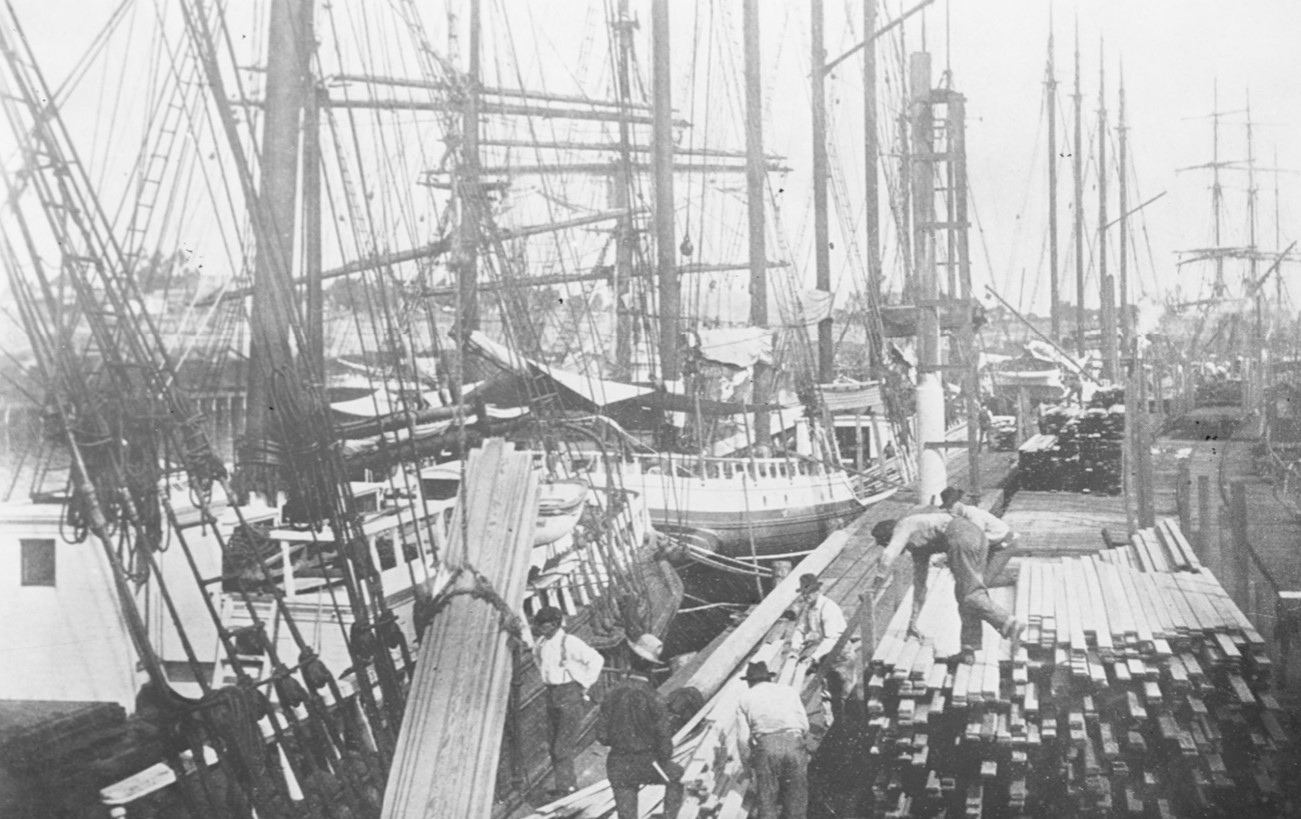 |
|
| (ca. 1896)* - Workers loading lumber on the wharf at San Pedro Harbor (present-day Los Angeles Harbor), with ships moored along the dock. |
Historical Notes The lumber trade through San Pedro continued to thrive until the Great Depression, playing a vital role in supplying construction materials for Los Angeles' rapid urbanization in the late 19th and early 20th centuries. |
Tall Masts
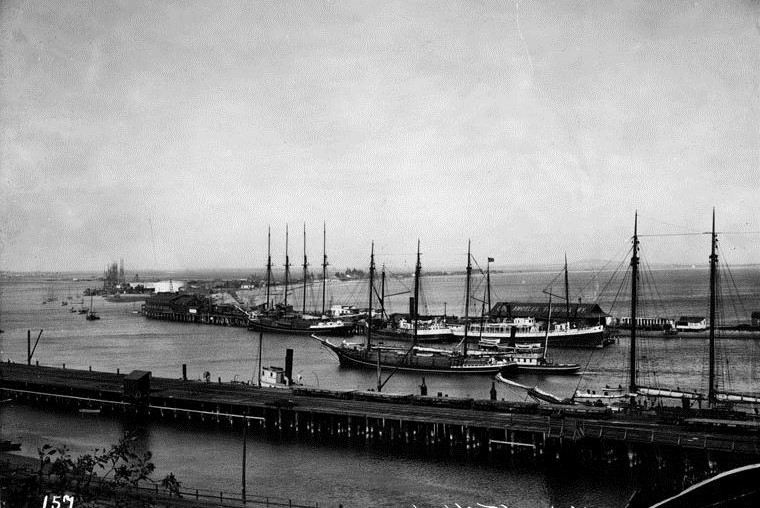 |
|
| (ca. 1890)* - Early view of L.A. Harbor showing a ship loaded with lumber navigating through the harbor. Los Angeles Terminal Ry. building is in the background. Railroad tracks can be seen on the docks in the foreground. |
 |
|
| (ca. 1890)* - A railroad train waits as workers unload lumber from their ship onto a railroad cart. |
Historical Notes After Banning's death in 1885 his sons pursued their interests in promoting the port, which handled 500,000 tons of shipping in that year. The Southern Pacific Railroad and Collis P. Huntington wanted to create Port Los Angeles at Santa Monica, and built the Long Wharf there in 1893. However the Los Angeles Times publisher Harrison Gray Otis and U.S. Senator Stephen White pushed for federal support of the Port of Los Angeles at San Pedro Bay. |
Santa Monica Long Wharf - San Pedro Harbor's Early Competition
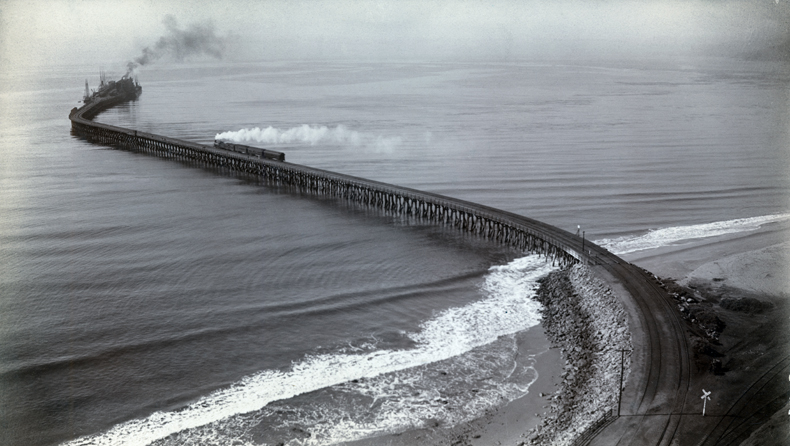 |
|
| (ca. 1893)* - Aerial view of the Southern Pacific Mammoth Wharf, Port Los Angeles, Calif. The wharf was also known as the old Santa Monica Long Wharf, north of Canyon. A white cloud of smoke can be seen from a train travelling on the tracks to the business end, at the end of the wharf. |
Historical Notes In 1893, Southern Pacific built the Long Wharf at the north end of Santa Monica to accommodate large ships and it was dubbed Port Los Angeles. At the time it was constructed, it was the longest pier in the world at 4700 feet, and accommodated a train. A controversy erupted over where to locate the seaport for the City of Los Angeles. The SP preferred Santa Monica, while others advocated for San Pedro Bay. San Pedro Bay was selected by the United States Congress in 1897. Still, the Long Wharf acted as the major port of call for Los Angeles until 1903. |
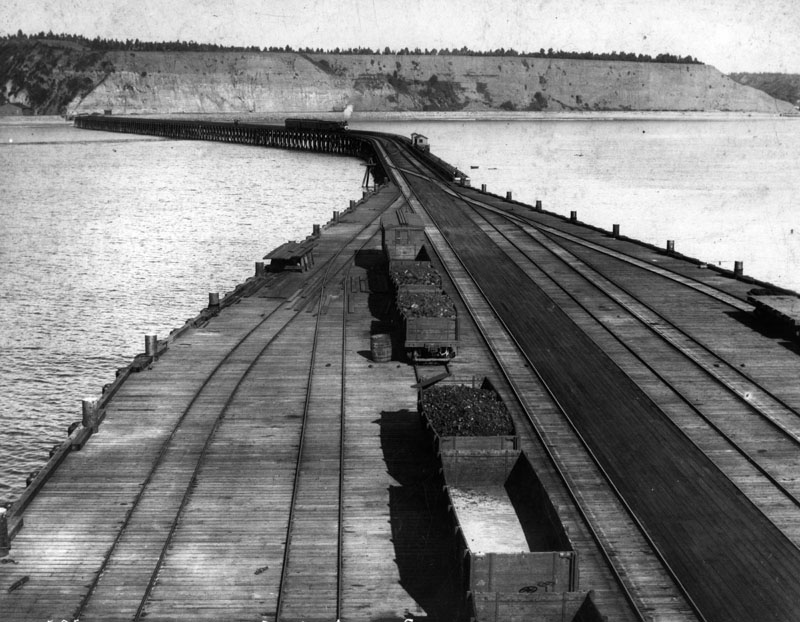 |
|
| (ca. 1893)* - Southern Pacific wharf, 4700 feet long, for the projected Port of Los Angeles, near Santa Monica, built in 1893. View is from the end of the wharf towards the shore. |
Historical Notes The Long Wharf was designated as California HIstorical Landmark No. 881 (Click HERE to see the California Historical Landmark Listing for LA County). |
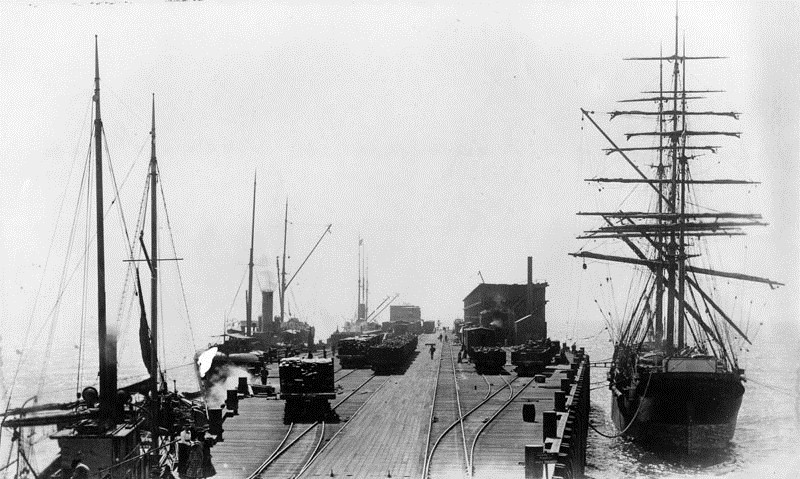 |
|
| (1898)* - Photo shows the business end of the mammoth wharf in Santa Monica. This wharf was the longest in the world at 4,700 feet long. |
Historical Notes Click HERE for more on the Santa Monica Long Wharf |
* * * * * |
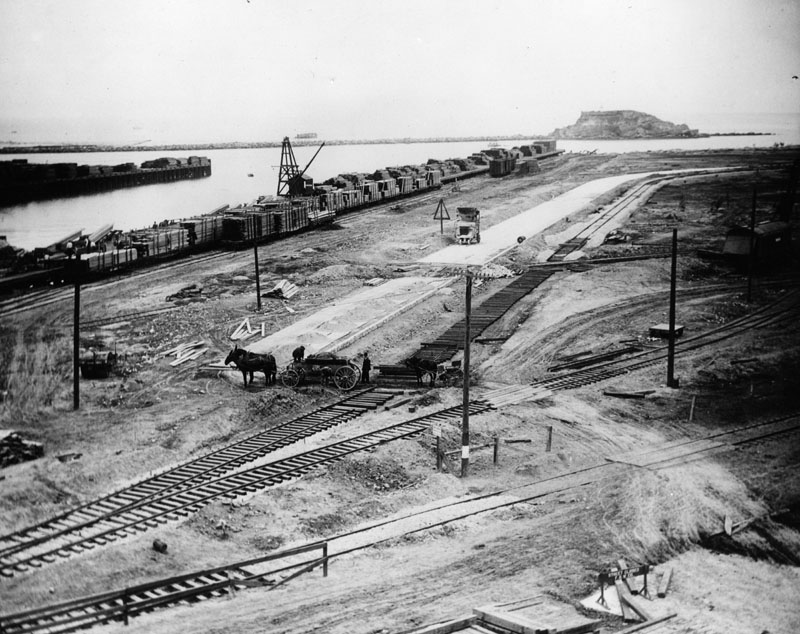 |
|
| (ca. 1880s)* - Early view of L.A. Harbor. Lumber is stacked on railroad cars along side of the channel. It appears that two men our unloading horse-drawn wagon to repair or complete the rail line. Breakwaters and Deadman's Island can be seen in the background. |
Historical Notes The Free Harbor Fight was settled when San Pedro was endorsed in 1897 by a commission headed by Rear Admiral John C. Walker (who later went to become the chair of the Isthmian Canal Commission in 1904). With U.S government support breakwater construction began in 1899 and the area was annexed to Los Angeles in 1909. |
 |
|
| (ca. 1880s)* - Early view of L.A. Harbor. Lumber is stacked on railroad cars along side of the channel. It appears that two men our unloading horse-drawn wagon to repair or complete the rail line. Breakwaters and Deadman's Island can be seen in the background. Image enhanced and colorized by Richard Holoff |
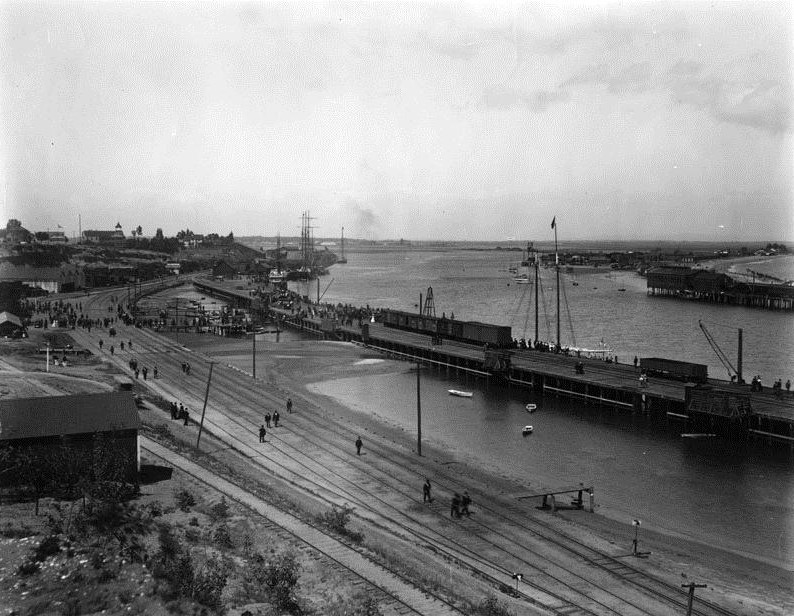 |
|
| (ca. 1890s)* - Panoramic view of L.A. Harbor showing the wharf with railroad box cars and yachts anchored. In the foreground people are walking along the waterfront. |
Point Fermin Lighthouse
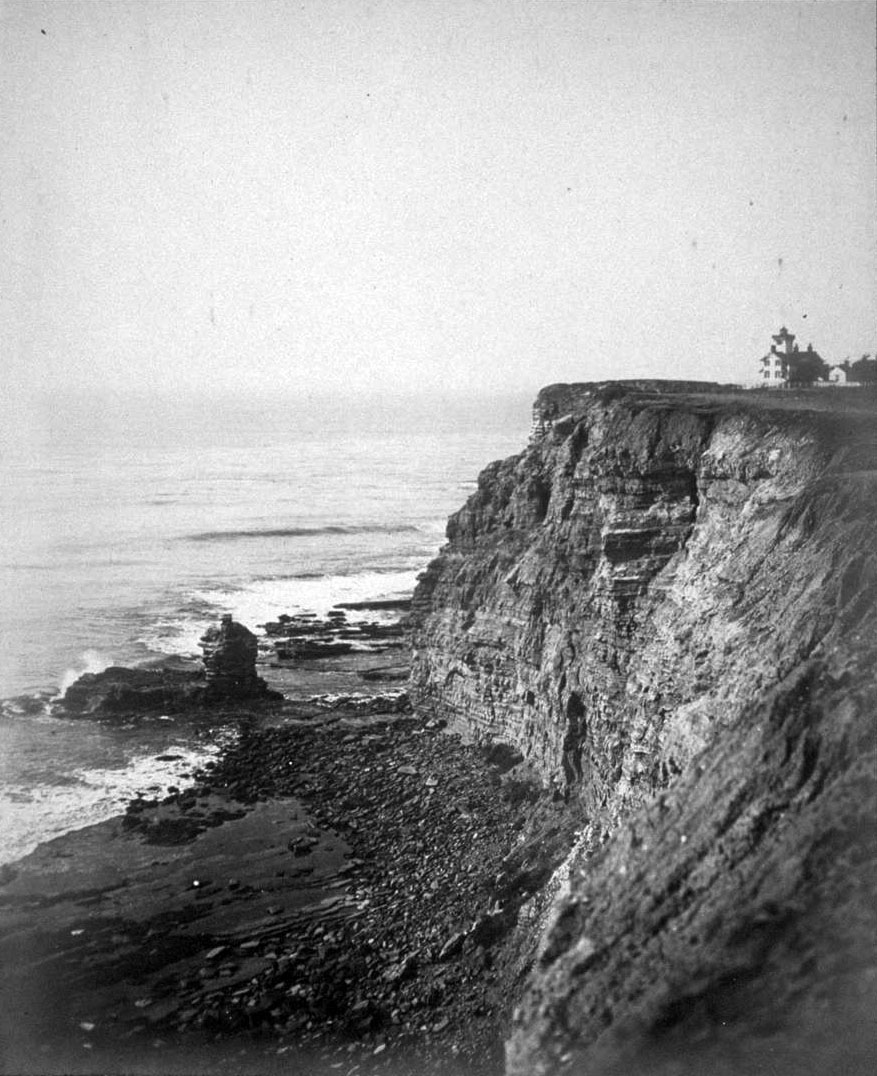 |
|
| (ca. 1870s)^#^^ - View of Point Fermin Lighthouse near the edge of the cliffs at San Pedro. |
Historical Notes Point Fermin Lighthouse was built in 1874. It was the first navigational light into the San Pedro Bay. Phineas Banning, with the support of many local businessmen, petitioned the Federal Government and the US Lighthouse Board to place a lighthouse on the point in 1854. Although the Lighthouse Board agreed funding and land, disputes delayed its construction until 1874. Point Fermin marks the southern-most point of the City of Los Angeles. It was named after Father Fermín de Francisco Lasuén by British explorer George Vancouver. When Vancouver visited in 1793 he wanted to thank the Father for his hospitality at the mission in Carmel. Father Padre Fermín de Francisco Lasuén also founded Mission San Fernando Rey de Españaon (the San Fernando Mission). Sometimes called the "forgotten friar," Padre Fermín Lasuén actually governed the California Mission system three years longer than his more famous predecessor, Padre Junipero Serra. Click HERE to see more in Early Views of the San Fernando Mission. |
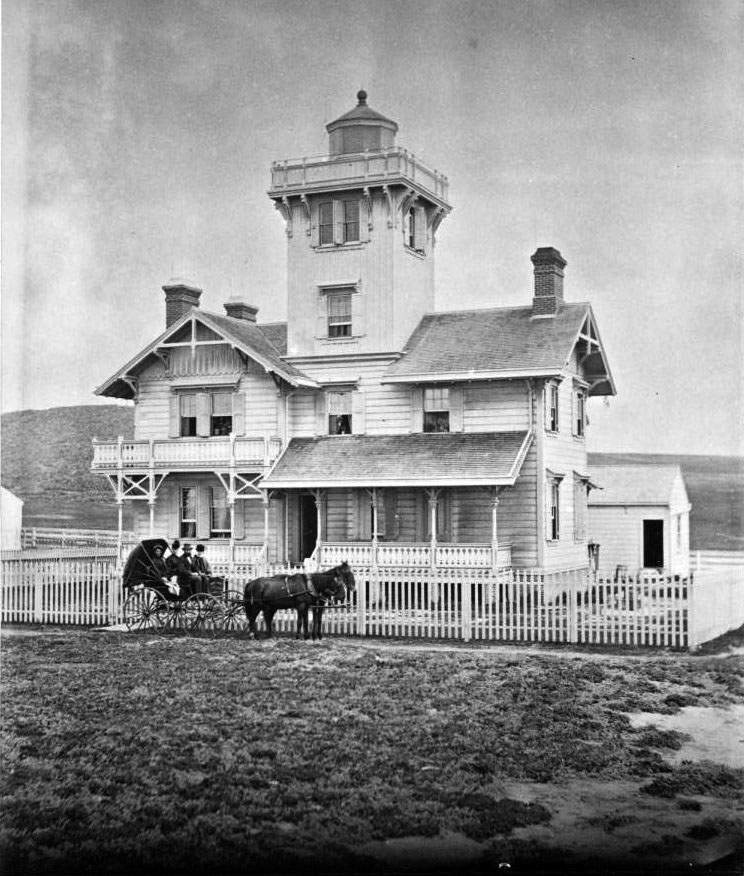 |
|
| (ca. 1875)#* - Exterior view of the lighthouse at Point Fermin, San Pedro. Four people pose for the camera as they sit in a horse-drawn carriage in front of the white picket fence. |
Historical Notes Paul J. Pelz, a draftsman for the US Lighthouse Board, designed the Stick Style Victorian lighthouse. The design was used for six lighthouses built between 1873 and 1874, of which three are still standing, East Brothers in San Francisco Bay, Hereford Light in New Jersey, and Point Fermin. The Stick Style is an early Victorian architectural style and is simpler in design and decoration than the later high Victorian period. It is characterized by its gabled roofs, horizontal siding, decorative cross beams and hand carved porch railings. The structure stands 30 feet tall and was built in 1874 at Point Fermin to guide mariners. The Lighthouse has a brick foundation and a wood frame, which was built with lumber from the California Redwoods. |
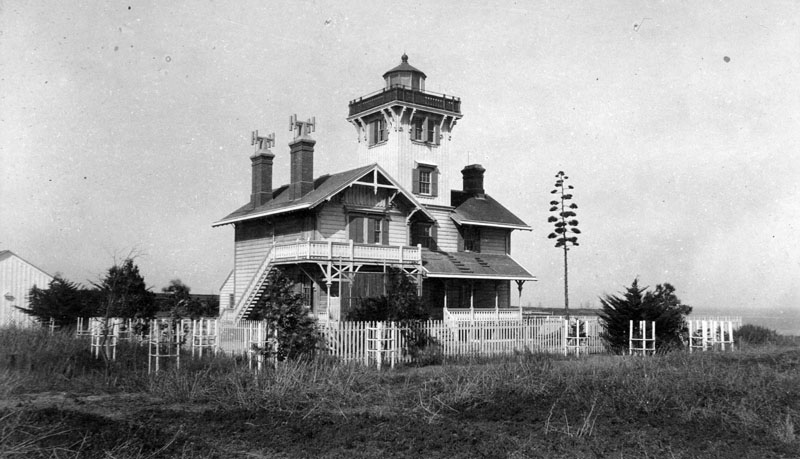 |
|
| (ca. 1890)** - Exterior view of the Victorian-style Point Fermin Lighthouse, located at 807 W. Paseo Del Mar in San Pedro on the Palos Verdes Peninsula. |
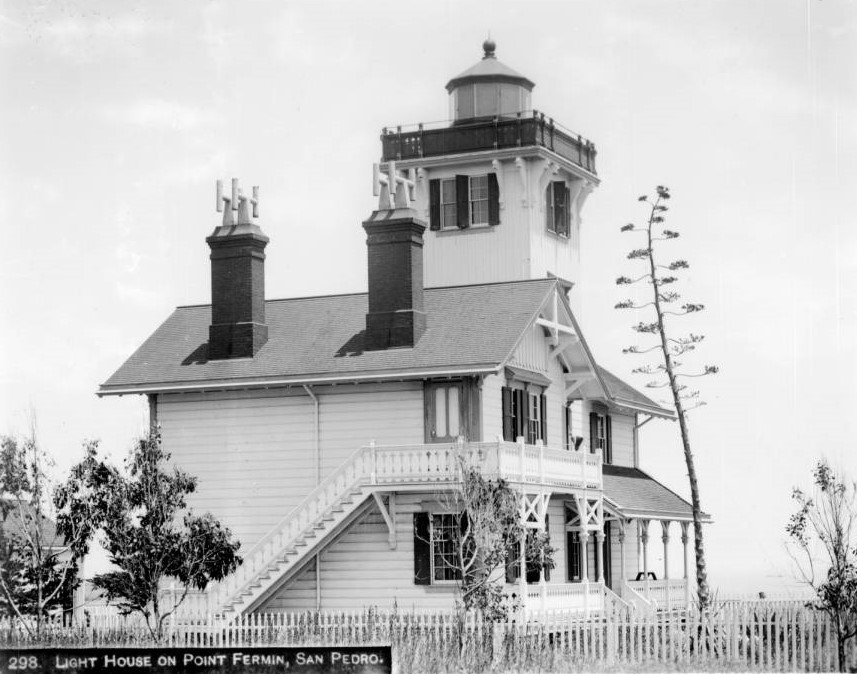 |
|
| (1890)* - Profile view of the lighthouse on Point Fermin, San Pedro. A picket fence surrounds the wooden two-story house with the square tower supporting the light. Several trees are in the yard. |
Historical Notes In 1941 the light was extinguished due to the bombing of Pearl Harbor. There was fear that the light would serve as a beacon for enemy planes and ships. Later, the lantern room and gallery were removed. They were replaced by a lookout shack that remained for the next 30 years, and was referred to as "the chicken coop" by locals. |
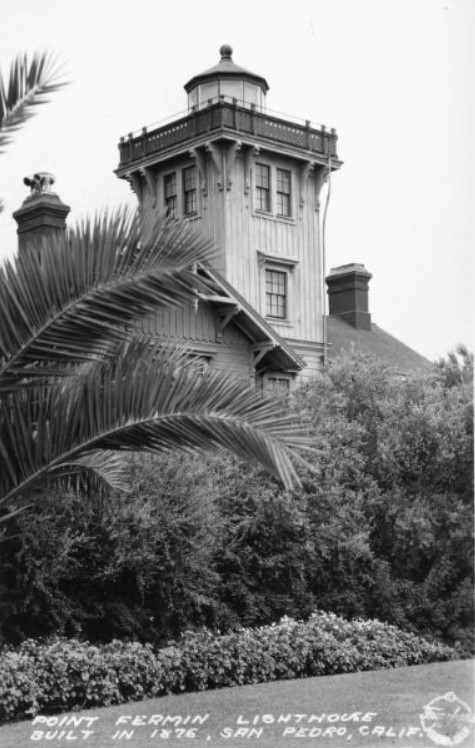 |
|
| (1937)^#^^ - Postcard view of the Point Fermin Lighthouse. Note on postcard reads: "Built in 1876", however, all other records indicate it was built in 1874. |
Historical Notes Point Fermin Lighthouse was saved from demolition in 1972 and the light was added to the National Register of Historic Places. It was refurbished in 1974, and a new lantern room and gallery were added.** In 2002, the lighthouse was restored, retrofitted, and rehabilitated for public access with funds from the City of Los Angeles, the Port of Los Angeles, and the State of California. The lighthouse was opened to the public on November 1, 2003 under the management of the Department of Recreation and Parks for the City of Los Angeles. Volunteers from the Point Fermin Lighthouse Society serve as tour guides and help to keep the lighthouse open to the public. |
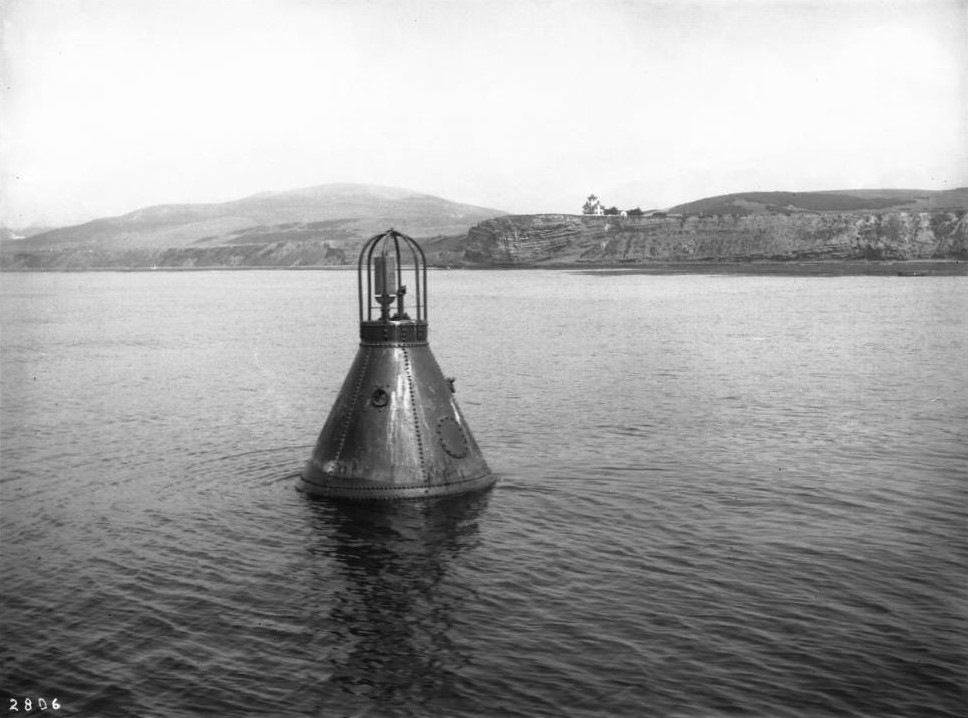 |
|
| (1890)#^ - Close-up view of a whistling buoy in calm water off Point Fermin. The Point Fermin lighthouse can be seen at the top of a cliff in the background. |
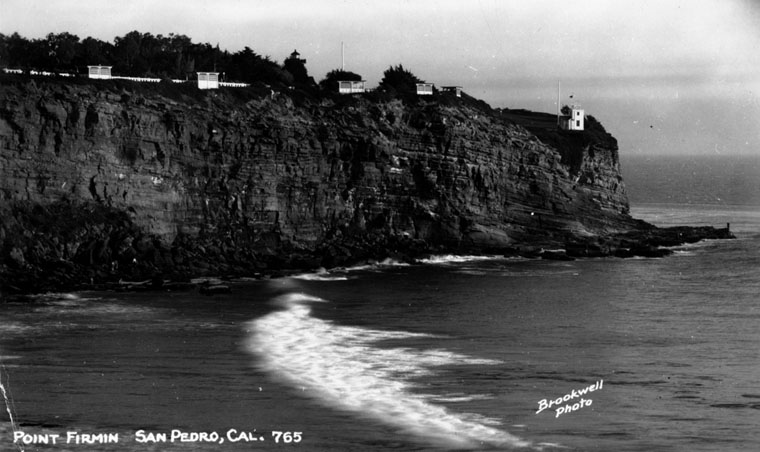 |
|
| (n.d.)* - A postcard view of the scenic Point Fermin, showing the cliffs and ocean. |
* * * * * |
Before the Port: San Pedro & Los Angeles Harbor (1885–1900)
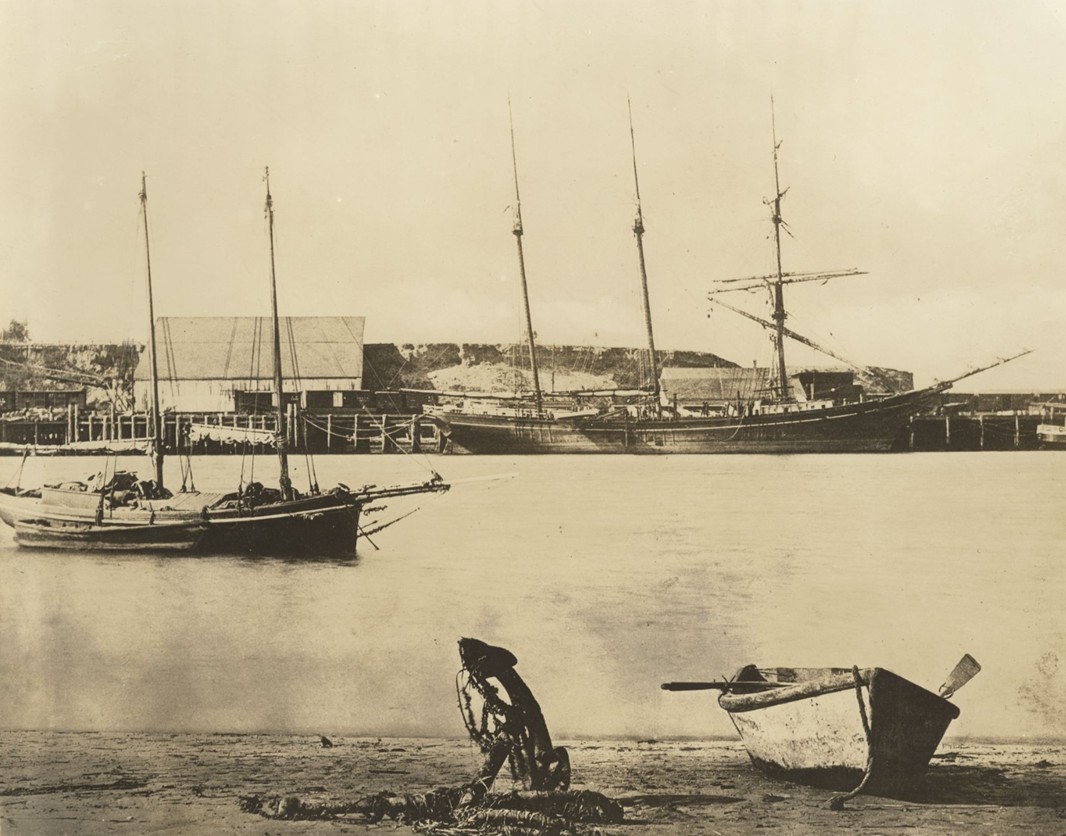 |
|
| (ca. 1885)* - A three-masted sailing ship is moored at the early San Pedro wharf. In the foreground, a small rowboat rests with oars visible, and a ship’s anchor stands upright in the sand. The scene shows the simplicity of harbor operations prior to any major infrastructure. Photo by C. C. Pierce. |
Historical Notes In the 1880s, San Pedro’s harbor remained largely undeveloped, relying on shallow-draft vessels and hand-loaded cargo. Deep water access was limited, which made transferring goods inefficient. This early image captures the modest scale of operations before federal investments began to reshape the harbor. |
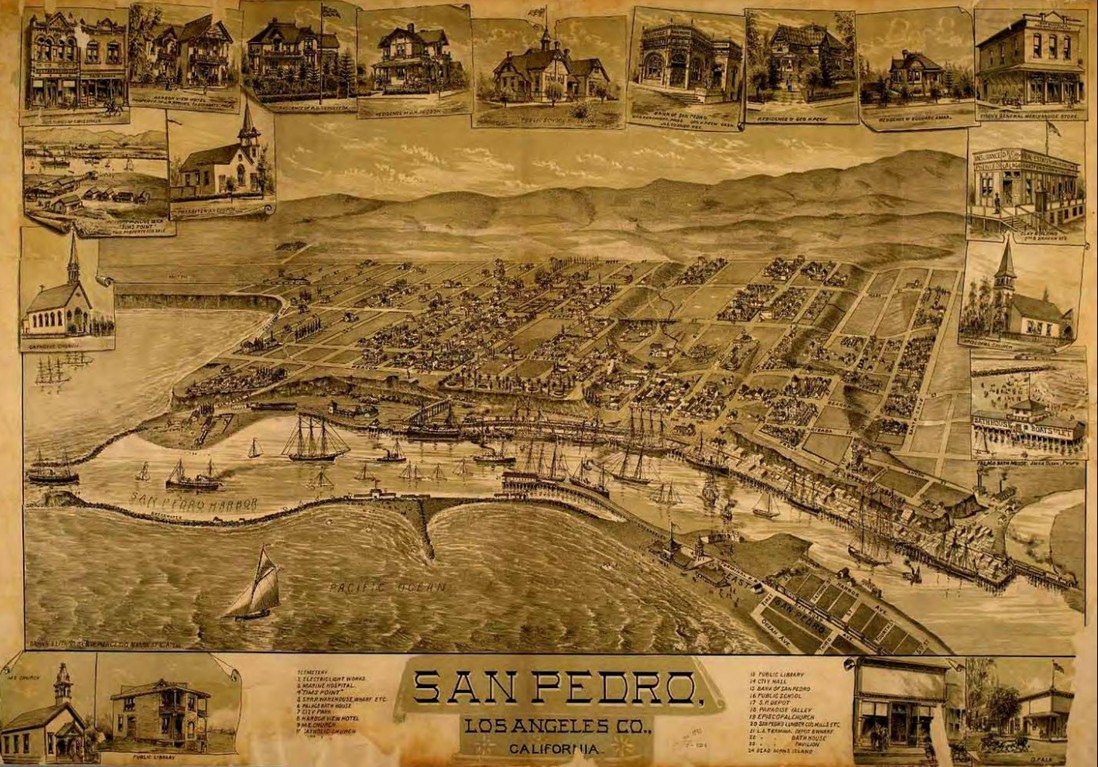 |
|
| (1893)* - This early map of San Pedro, drawn by Bruce W. Pierce, shows the town layout before major dredging and breakwater work began. |
Historical Notes This 1893 map shows San Pedro before its integration into the larger Los Angeles Harbor complex. At the time, shipping interests were vying for federal support to dredge the channel and construct protective breakwaters. The town’s strategic location near the Los Angeles basin made it a natural candidate for port development. |
 |
|
| (ca. 1890)* - Rowboats wait to ferry passengers to a nearby bath house. Signs reading “Boats to Let” reflect a mix of leisure and utility, while the storefronts and bluff behind hint at a town just beginning to grow. Photo from the Ernest Marquez Collection. |
Historical Notes In addition to freight activity, early San Pedro served as a modest seaside destination. Bath houses were popular in the 1880s–90s, and small boats ferried visitors from larger vessels or docks. These casual scenes would soon give way to more industrial waterfront development. |
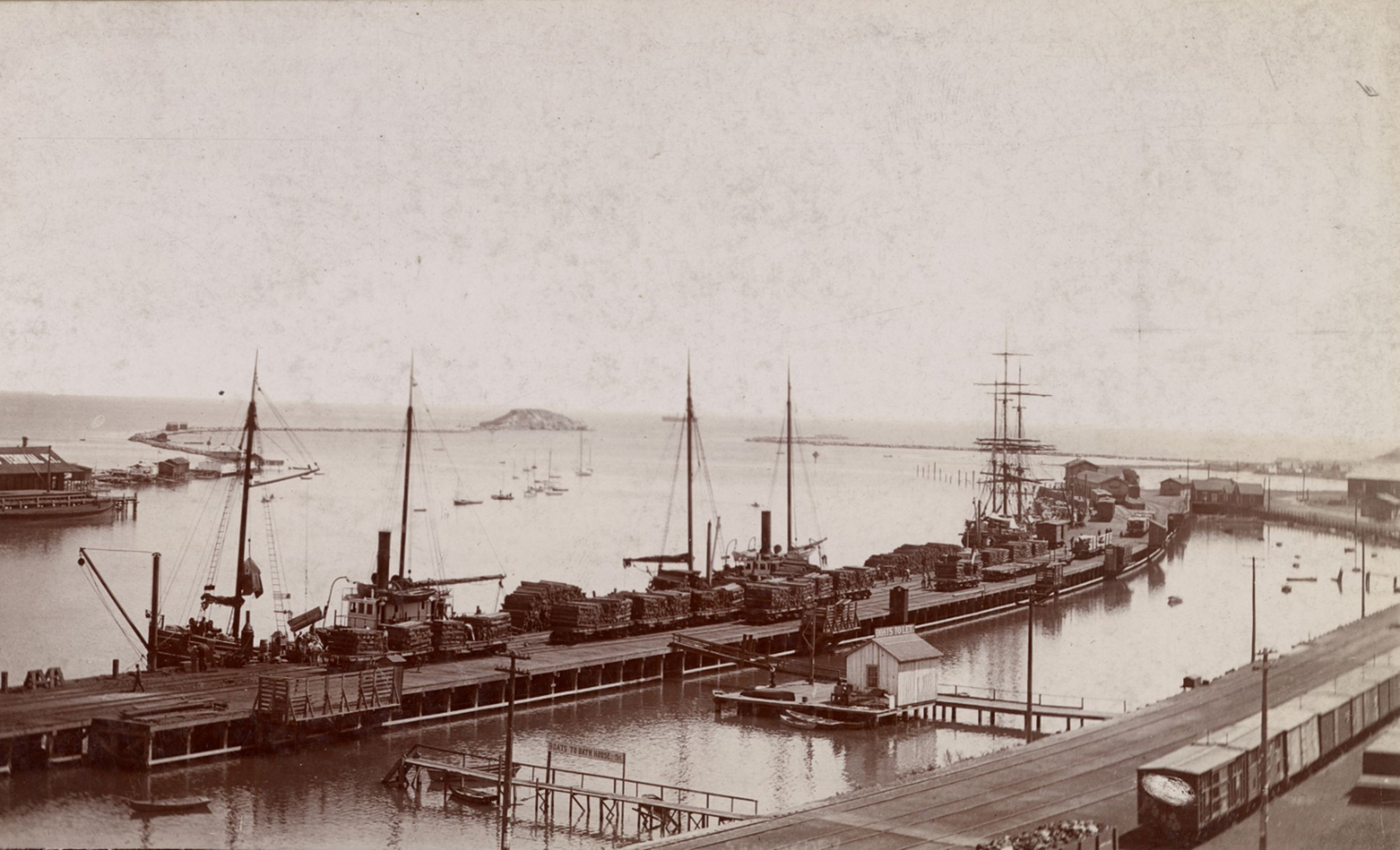 |
|
| (ca. 1890)* - Freight and Rail Activity at the Wharf. Freight operations in full swing along the San Pedro waterfront. Loaded pallets sit beside rail tracks, and small boats are docked along the wooden pier. |
Historical Notes By 1890, informal freight operations had begun integrating with rail systems. Before the Harbor Commission existed, several private companies extended tracks along the waterfront to connect with arriving ships. This marked the beginning of intermodal transport in San Pedro. |
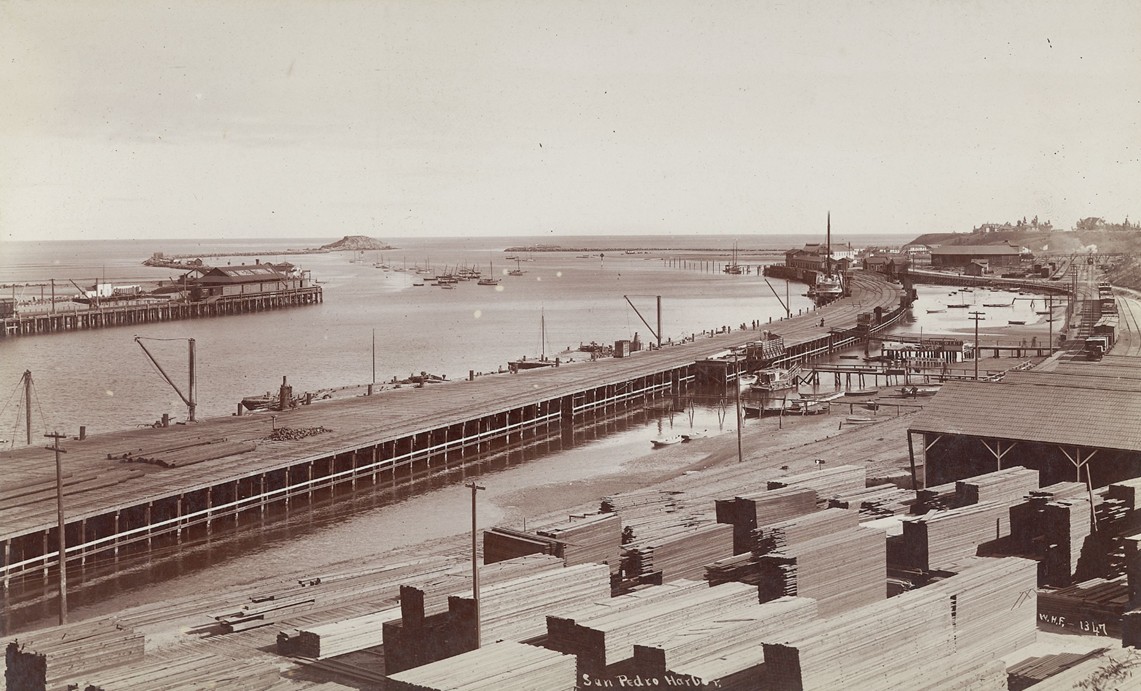 |
|
| (ca. 1895)* – Stacked lumber and rail tracks dominate the San Pedro wharf scene. These materials supported Los Angeles’s construction boom of the 1890s. Photo by William H. Fletcher. |
Historical Notes As Los Angeles expanded rapidly in the 1890s, lumber became the harbor’s most critical import. San Pedro served as a staging area for building materials shipped from the Pacific Northwest and offloaded directly into Southern California’s growing rail network. |
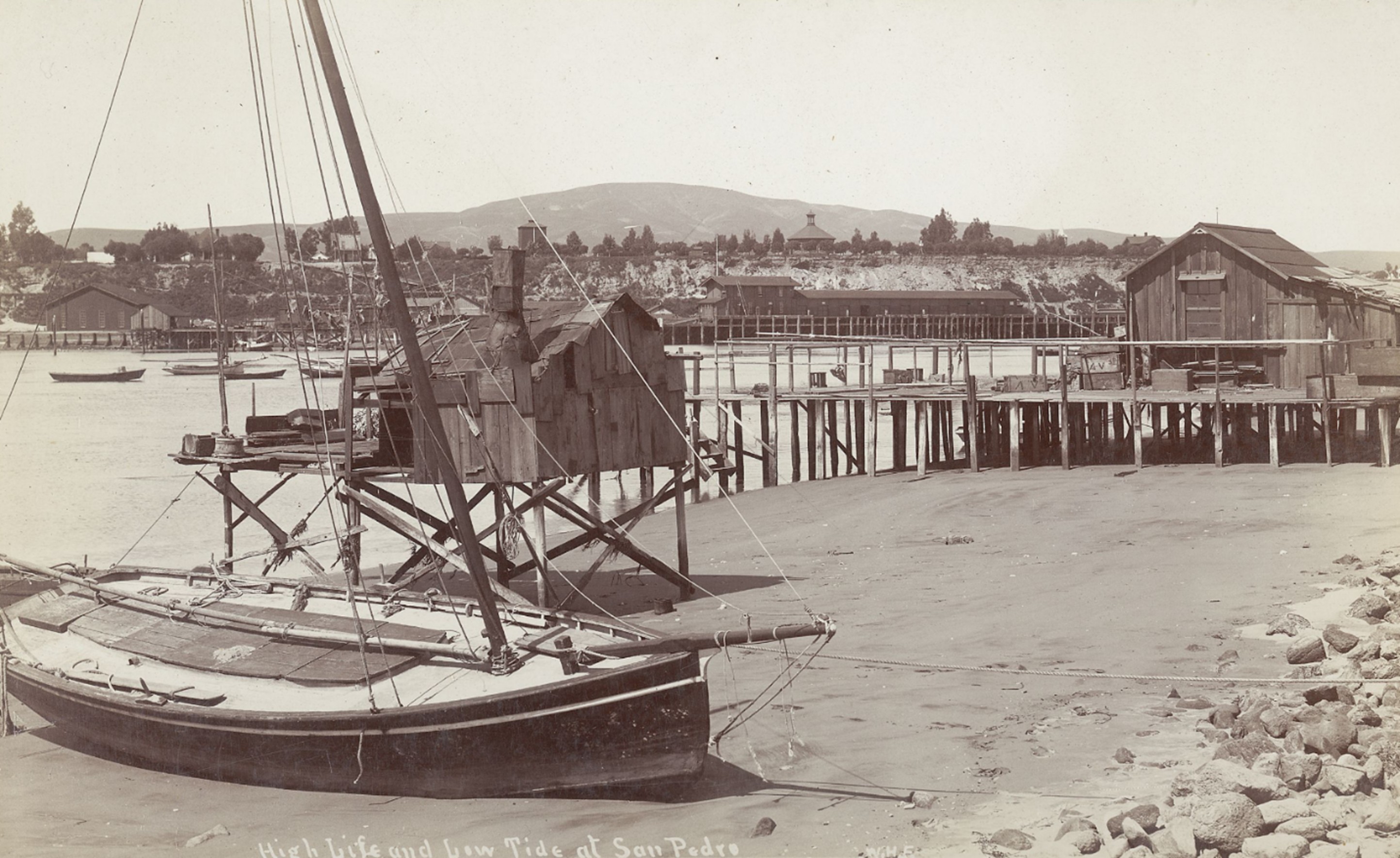 |
|
| (1895)* - A beached sailboat sits on the San Pedro shoreline during low tide. In the background: piers, simple buildings, and the bluffs lining the bay. Photo by William H. Fletcher. |
Historical Notes The unprotected coastline and lack of adequate piers often left smaller vessels stranded at low tide. Before breakwaters were built, tidal shifts and unpredictable surf posed constant threats to early shipping efforts in the harbor. |
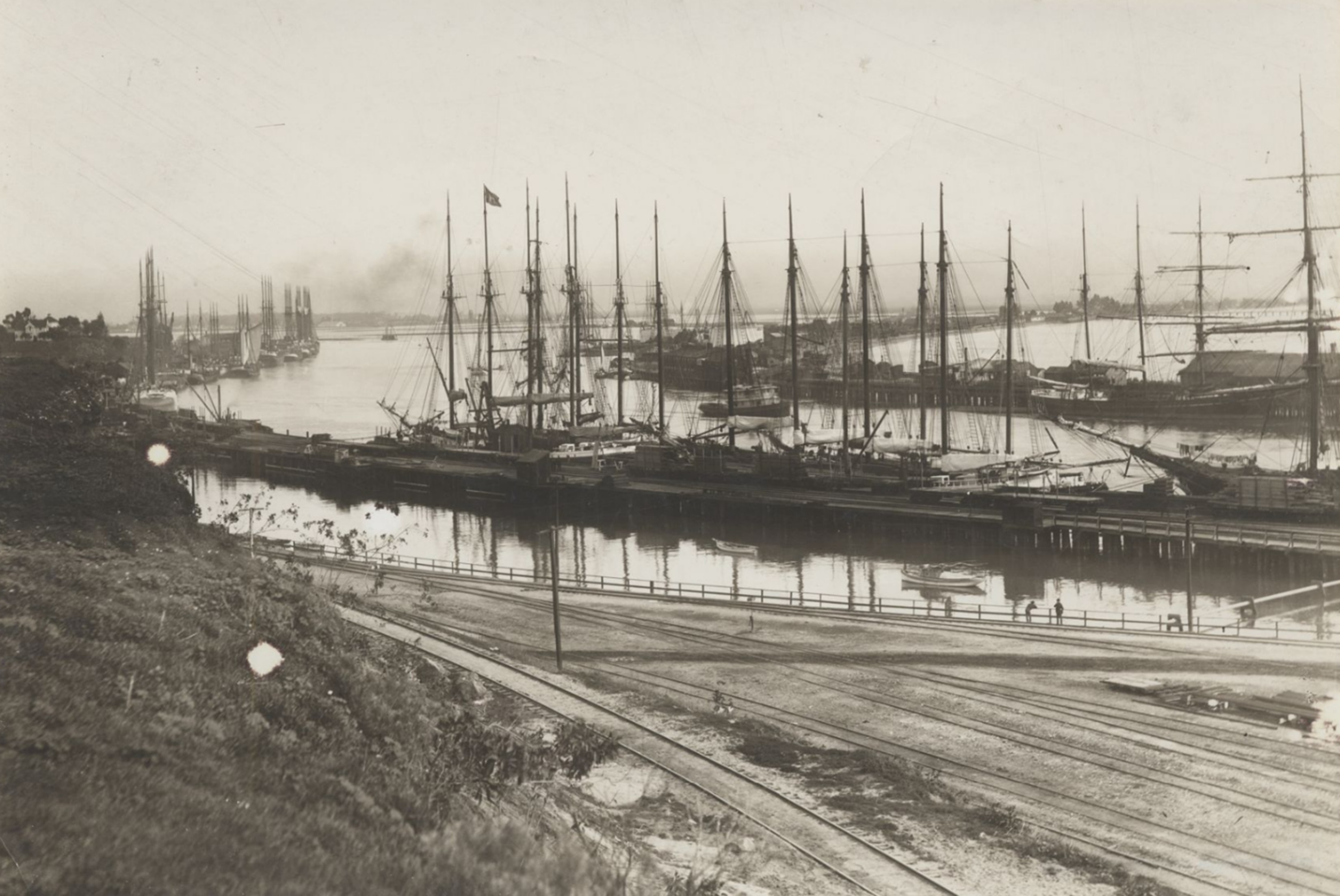 |
|
| (ca. 1895)* - An elevated view of the San Pedro waterfront reveals dozens of tall-masted ships along the docks, with rail tracks in the foreground. |
Historical Notes This view highlights the dense maritime traffic that defined the mid-1890s. Multiple tall ships are visible at anchor, while rail spurs run along the dock—evidence of the harbor’s growing importance in coastal shipping, especially before containerization. |
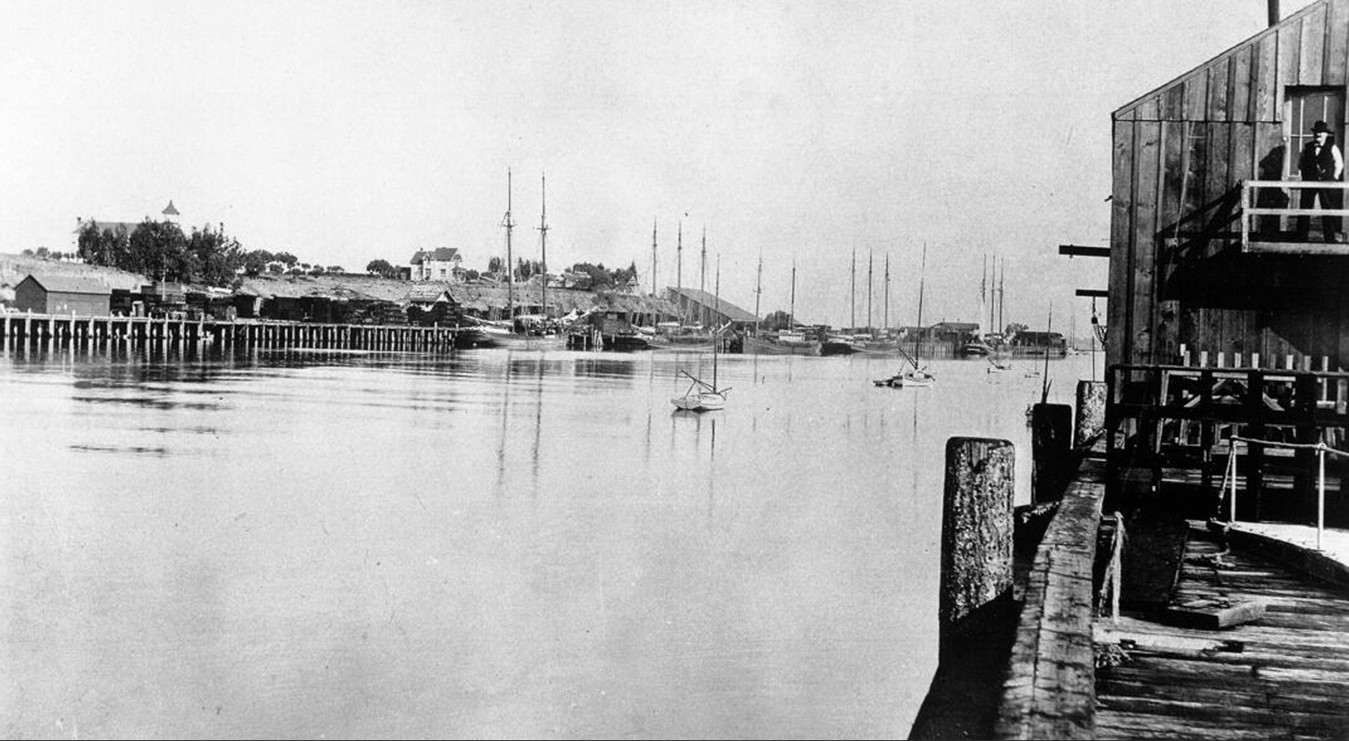 |
|
| (ca. 1896)* - Photograph taken from Terminal Island shows San Pedro Harbor looking inland. The Knob Hill Hospital sits on the bluff to the left, and the cupola of the Clarence Hotel (later the Hotel San Pedro) can be seen in the distance. |
Historical Notes This perspective from Terminal Island shows Knob Hill Hospital and the Clarence Hotel overlooking the harbor. By the early 20th century, Terminal Island would evolve from a small sandbar into a major industrial and naval facility, thanks in part to harbor dredging efforts that began in 1899. |
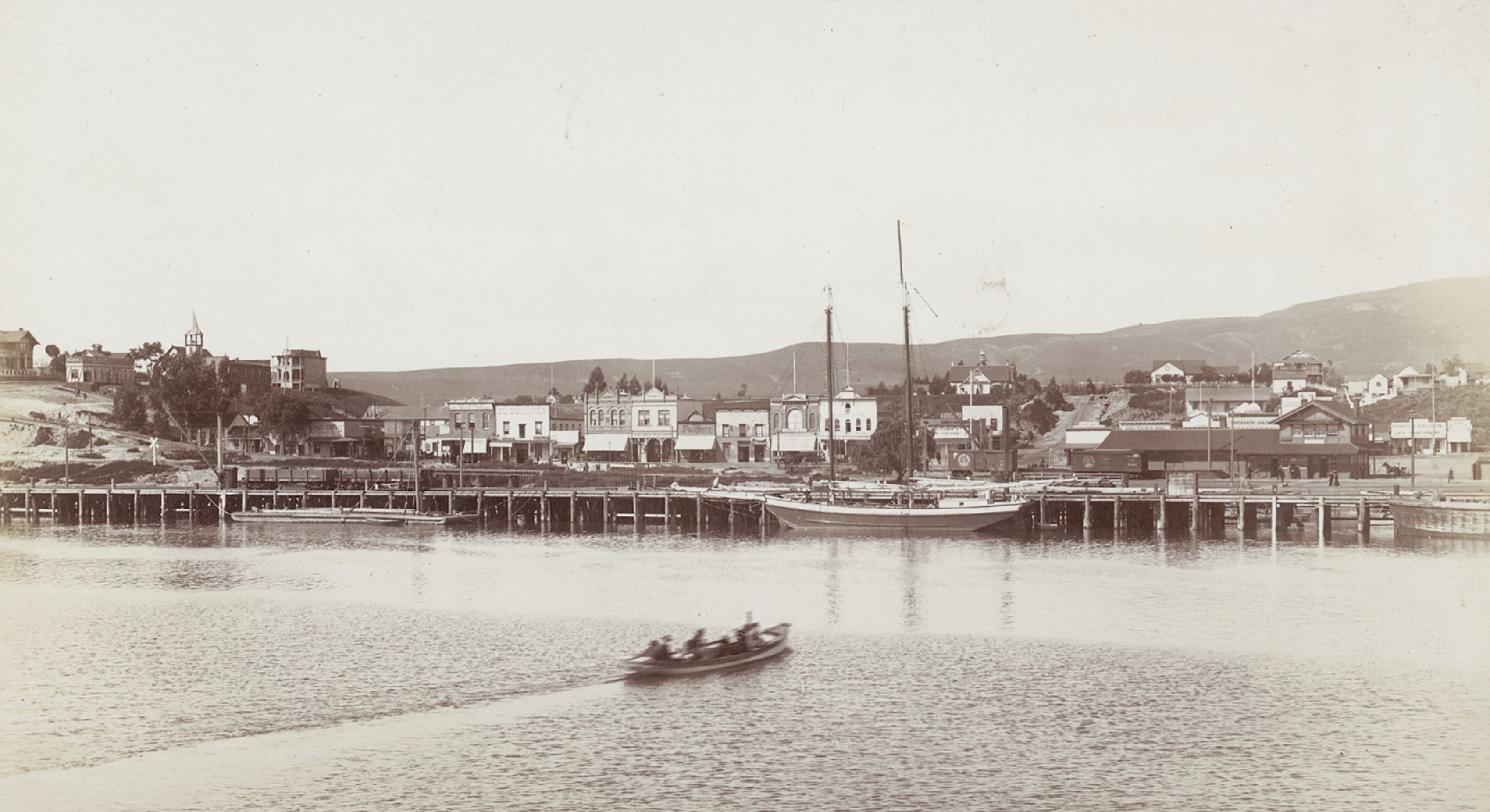 |
|
| (1897)* - View of waterfront. Shows main street and bordering buildings, wharf with railroad tracks. By 1897, San Pedro’s Main Street faced the growing harbor. Rail lines ran alongside the dock, supporting maritime commerce and industry. Photo by W. H. Fletcher. |
Historical Notes As the port town grew, Main Street developed into a modest commercial hub. Rail access directly to the water enabled faster transfer of goods and passengers—a critical step in securing San Pedro’s future as a competitive deep-water port. |
 |
|
| (1898)* - A vast quantity of lumber awaits transport at the San Pedro waterfront, a reflection of Los Angeles’s explosive building boom during the late 1890s. In the distance, a four-masted schooner is docked near Terminal Island. The harbor’s growing infrastructure—piers, rail spurs, and freight sheds—helped set the stage for its designation as the official Port of Los Angeles in 1907. Photo by C. C. Pierce. |
Historical Notes By 1898, the U.S. Army Corps of Engineers had begun initial work on dredging and constructing breakwaters. The scale of lumber shipments visible here reflects booming regional demand for housing and infrastructure—key forces that justified federal investment in a formal port. |
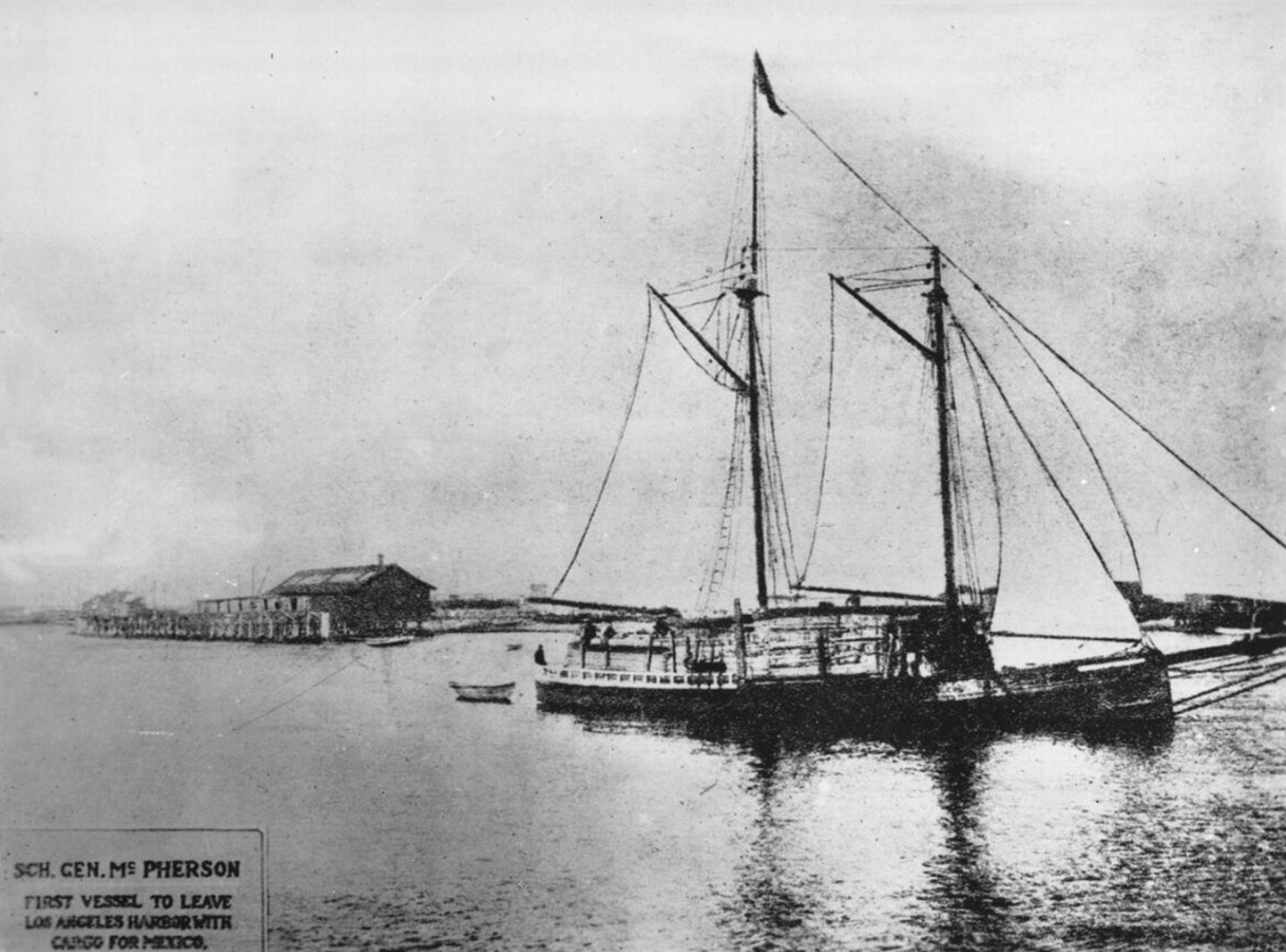 |
|
| (1898)* - The schooner General McPherson in full sail departs Los Angeles Harbor—the first vessel to carry cargo to Mexico from the newly functioning harbor. |
Historical Notes The General McPherson was the first vessel to leave Los Angeles Harbor with cargo bound for Mexico, symbolizing the beginning of international trade through San Pedro. This was a milestone in Los Angeles’s rise as a Pacific commerce hub, just prior to its designation as an official port in 1907. |
* * * * * |
City Hall
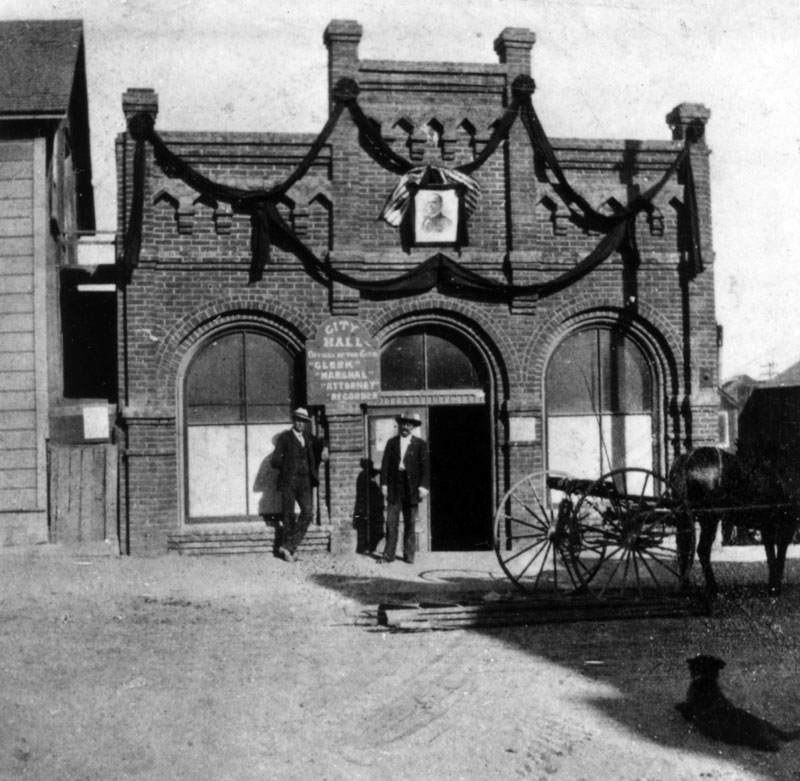 |
|
| (1900)* - Los Angeles city clerk O.C. Abbott (left) and Ben Baker stand outside of the San Pedro City Hall, a rented building on Beacon between 4th and 5th streets. |
Historical Notes In 1906, the City of Los Angeles annexed the Harbor Gateway, a long narrow strip of land connecting the city to the coast, and in 1909, the city annexed San Pedro and the adjacent town of Wilmington. The odd shape is still seen in the map of the city. Click HERE to seeSan Pedro City Hall No. 2 (1905 - 1908). |
* * * * * |
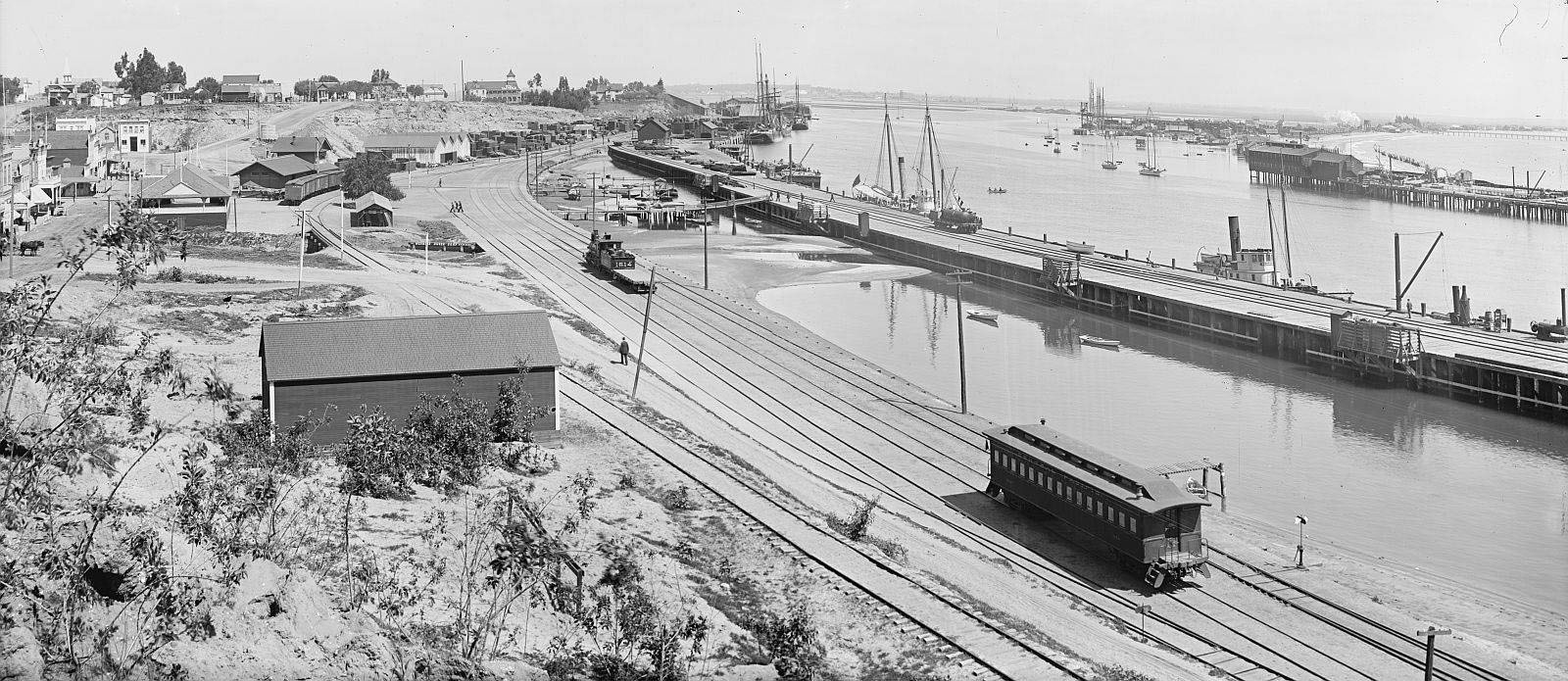 |
|
| (1890s)^* - View of San Pedro Harbor circa 1890s. Two images from the Library of Congress stitched together with the freeware Microsoft Image Composite Editor. |
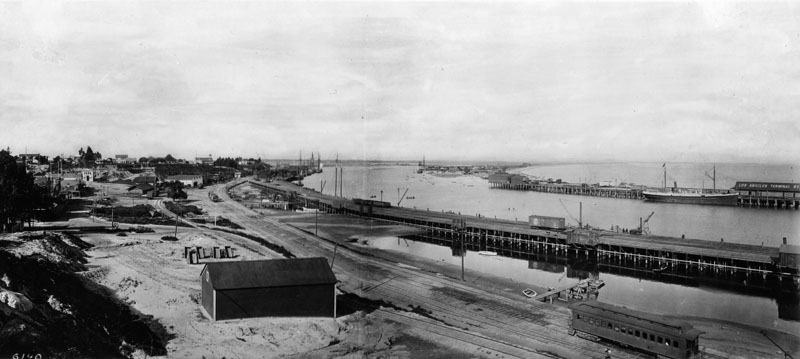 |
|
| (ca. 1900)* - View of L.A. Harbor at San Pedro showing a large ship anchored alongside the Los Angeles Terminal Railway across the channel. A railroad passenger car can be see on the tracks in the foreground. |
Historical Notes In 1890 the Pasadena/Altadena Railway was assumed by a couple of other failing rail lines that connected it to Los Angeles. It became an immediate success. In July 1891 it was joined again with a line that connected it to San Pedro. The line was renamed the Los Angeles Terminal Railway, and subsequently so was its San Pedro terminus at Rattlesnake Island, now Terminal Island. |
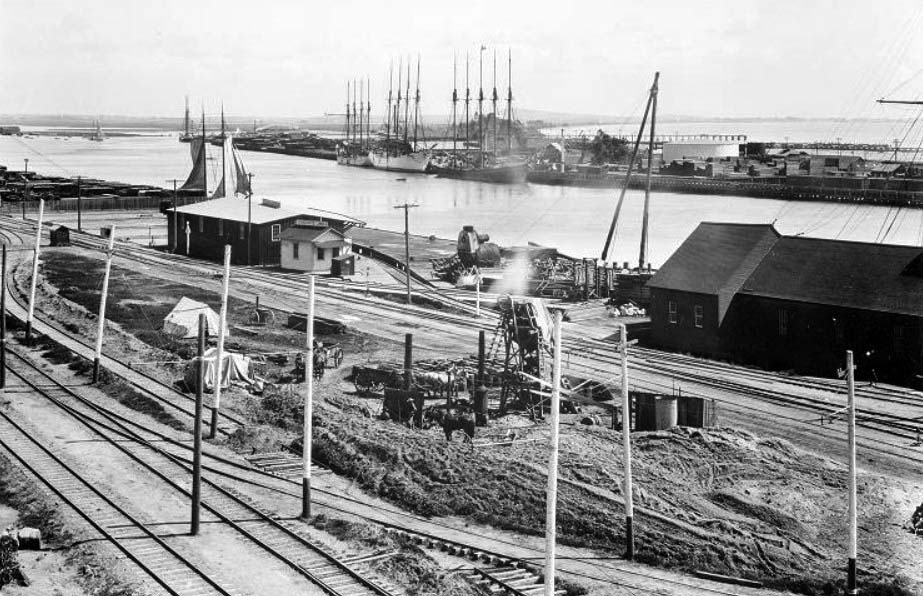 |
|
| (ca. 1900)#* - View of several tall ships at dock in San Pedro Harbor. |
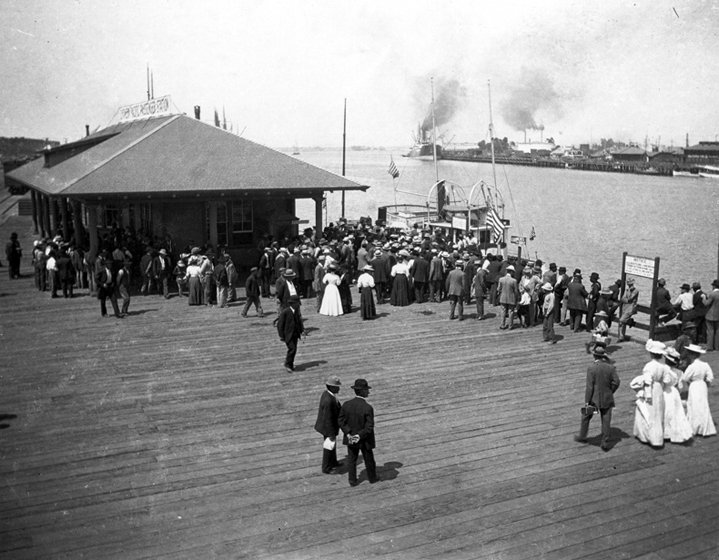 |
|
| (ca. 1899)*#* - View of the Port of Los Angeles circa 1899. Crowds of people are dressed up and appear to be viewing the arrival of a vessel. |
* * * * * |
Front Street (now Avalon Blvd)
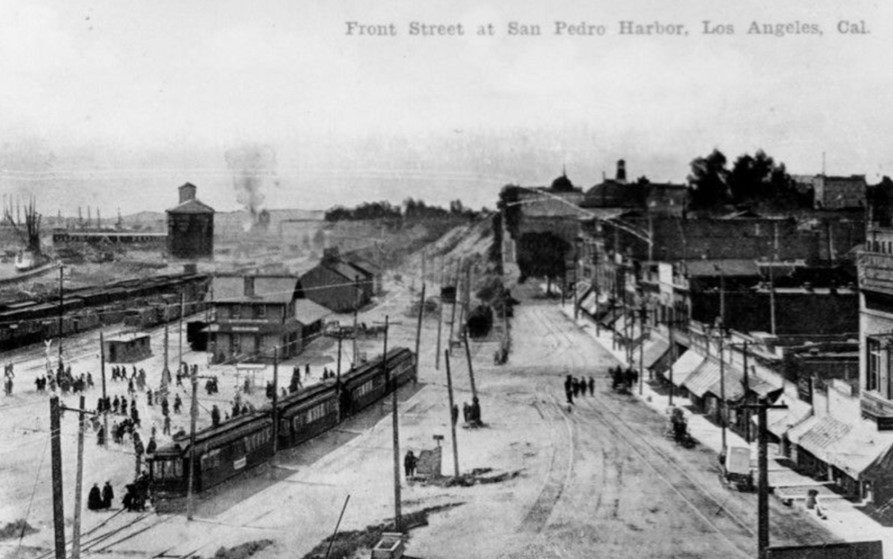 |
|
| (ca. 1900)* - Postcard view of Front Street (now Avalon Boulevard) at San Pedro Harbor showing a multitude of passengers disembarking from streetcars. Commercial storefronts can be seen acroos the unpaved road to the far right of the photo. |
Historical Notes The establishment of the Port of Los Angeles in the early 1900s spurred the development of San Pedro, and electric streetcars provided local transit services for workers and later military personnel. |
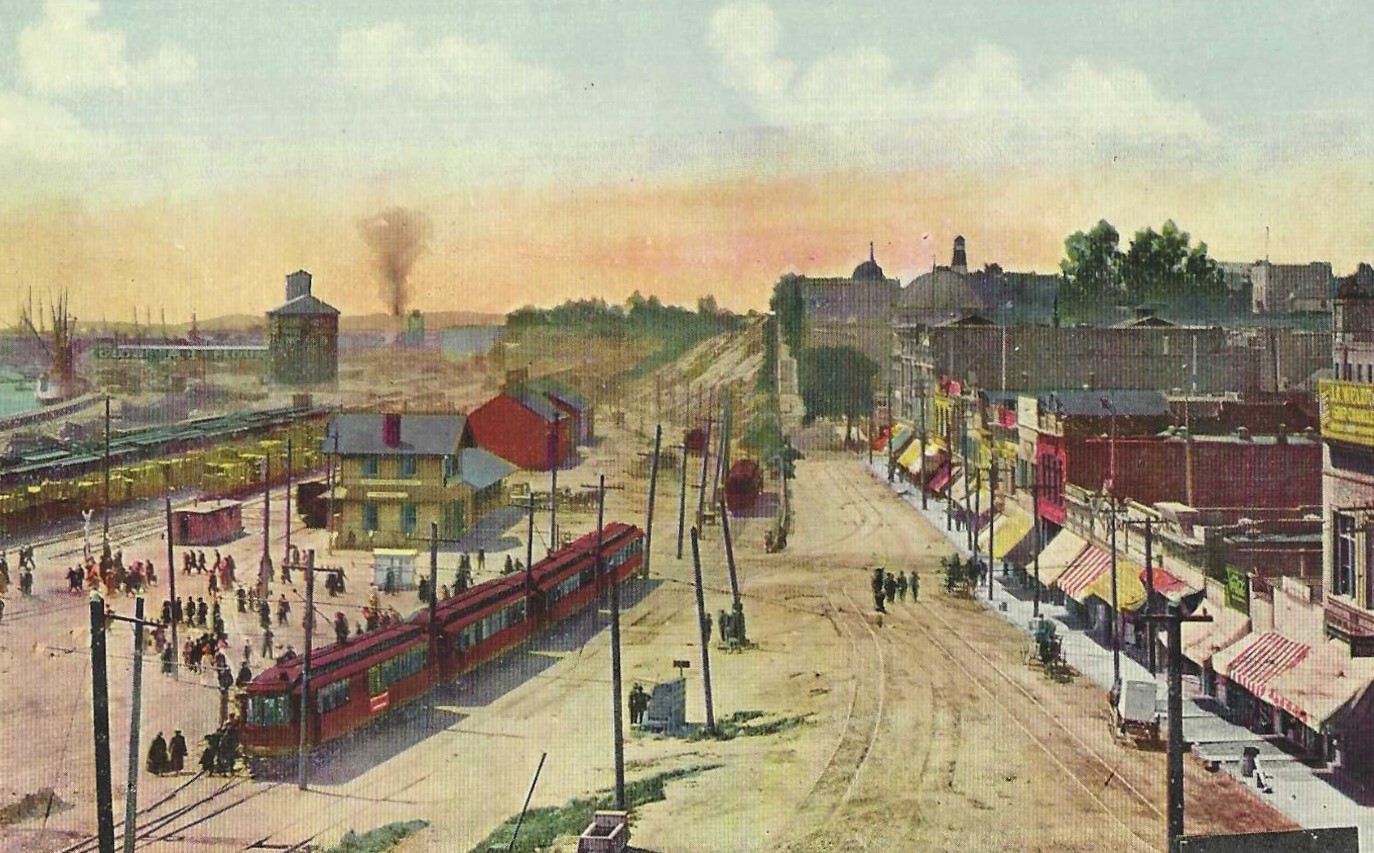 |
|
| (ca. 1900)* - Postcard view of Front Street (now Avalon Boulevard) at San Pedro Harbor showing a multitude of passengers disembarking from streetcars. Commercial storefronts can be seen acroos the unpaved road to the far right of the photo. |
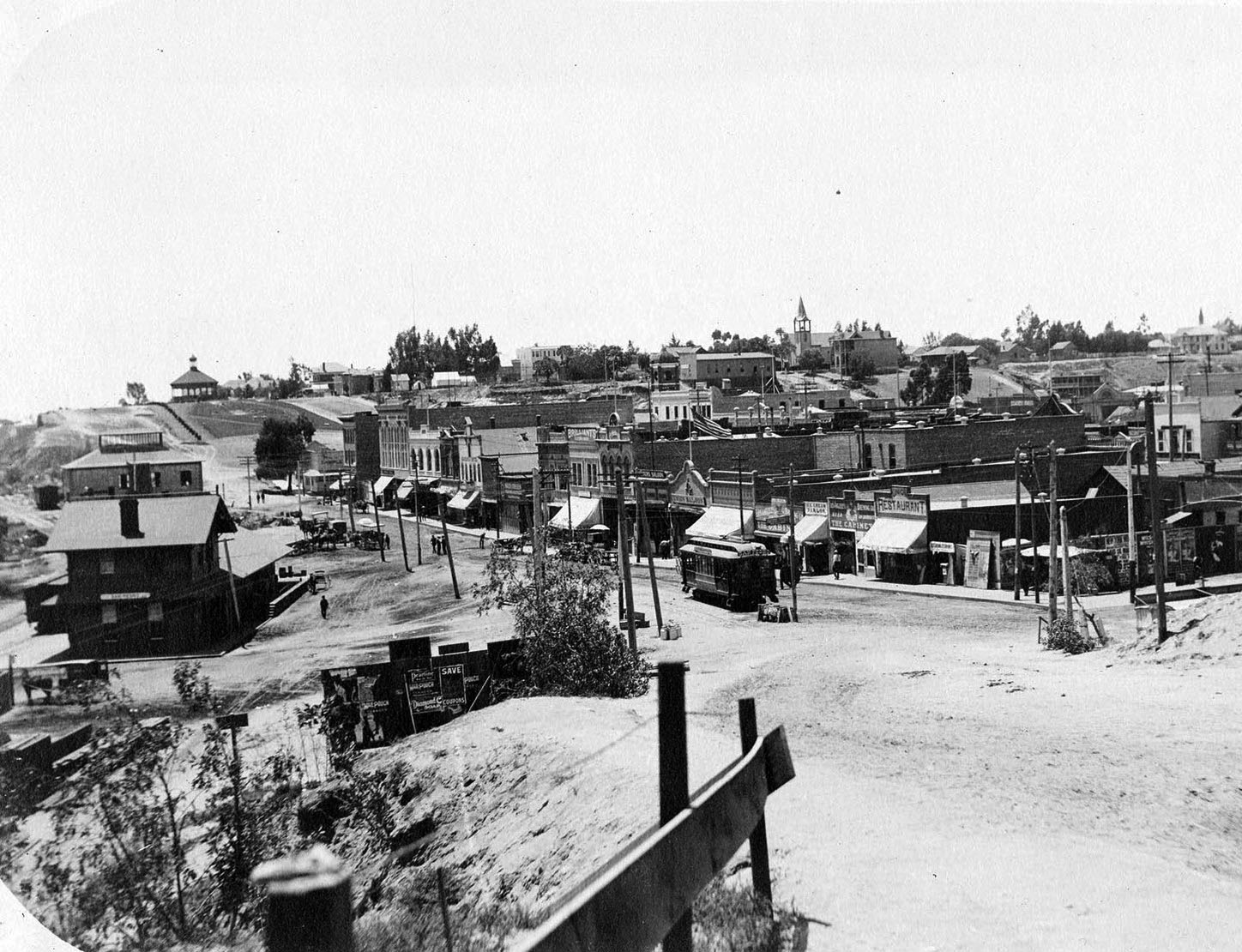 |
|
| (1904)* - View looking south on Front Street, from 4th. The gazebo atop the hill in the distance (center left) is sitting where the Carnegie Library would be built a couple years later, at 820 S. Beacon St. Photo from the California Historical Society |
Historical Notes Streetcar lines in San Pedro included the Front Street line, which ran from the Pacific Electric depot at Sixth and Palos Verdes to Point Firmin via Sixth and Pacific. |
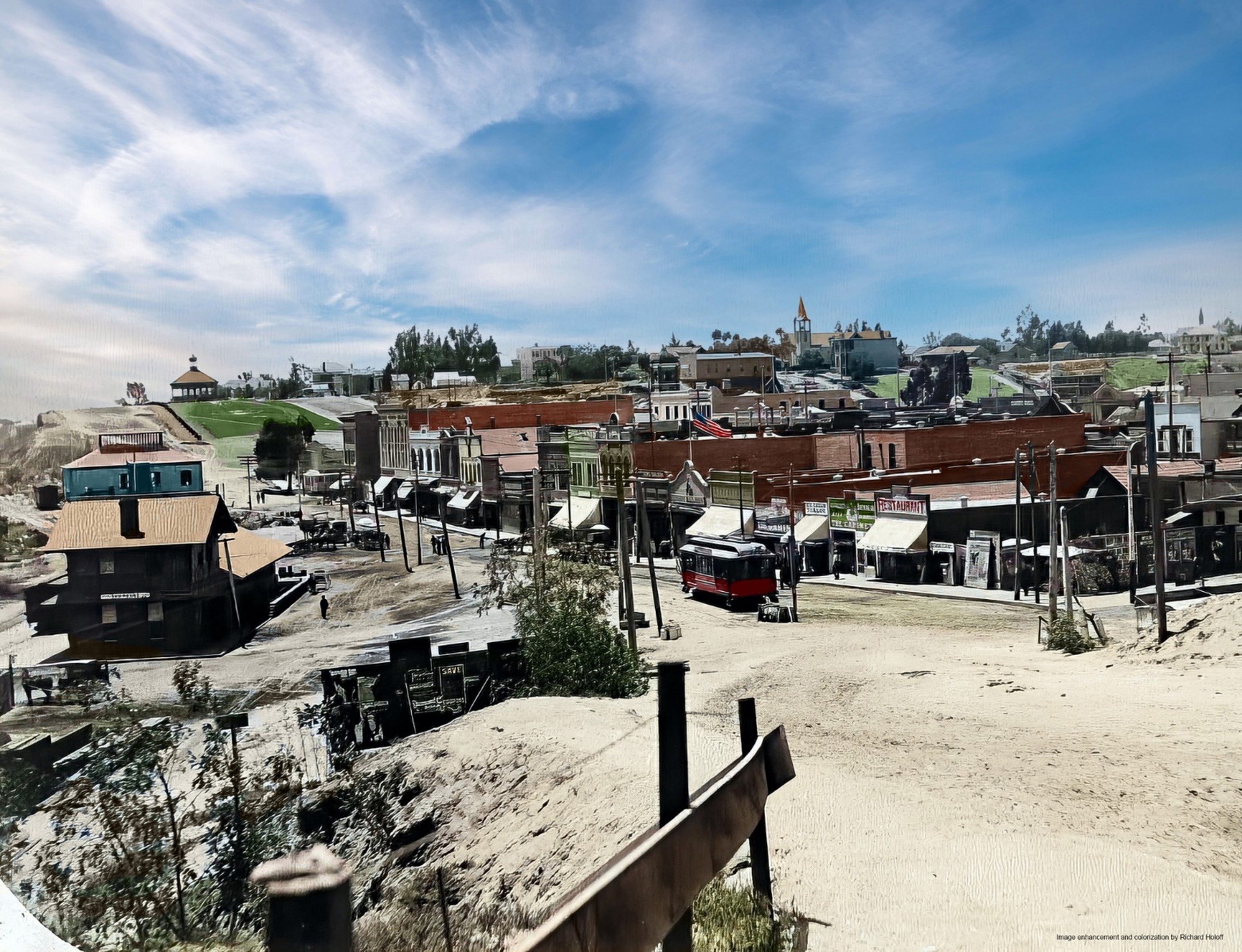 |
|
| (1904)* - View looking south on Front Street, from 4th. The gazebo atop the hill in the distance (center left) is sitting where the Carnegie Library would be built a couple years later, at 820 S. Beacon St. Photo from the California Historical Society. Image enhancement and colorization by Richard Holoff |
 |
|
| (1905)* - Panoramic view of Front Street in the Port of Los Angeles. A horse-drawn carriage moves down the dusty, unpaved street perpendicular to the streetcar behind in front of which the silhouette of a man can be seen crossing. Parked rail cars sit in a yard to the right, while a row of commercial shopfronts of varying size line up end to end along the street to the left. A tall building in the lefthand foreground corner reads "Mission" on the side. Flagpoles line the harbor close to the water in the background at right. Photo by C.C. Pierce |
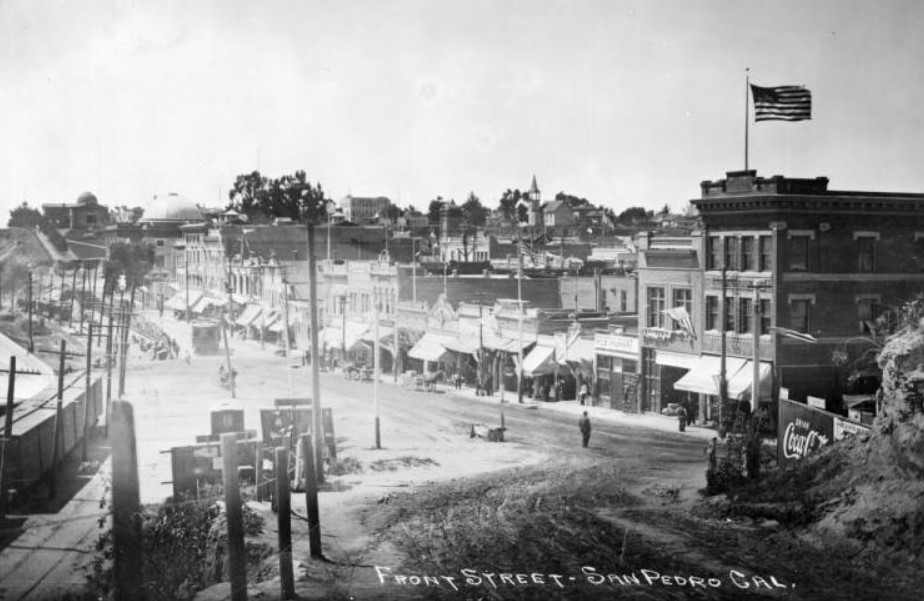 |
|
| (ca. 1906)* - View of Front Street looking south in San Pedro. A section of post-and-wire fence is pictured in the left foreground, guarding the edge of a steep incline that leads down into the unpaved Front Street. To the right of center, a man can be seen walking towards a side of the street lined with commercial buildings, while farther in the foreground at right, a billboard for Coca Cola can be seen. To the left, the tail end of a set of railroad cars can be seen behind a line of utility poles. The domed building of the Carnegie Library building can be seen on the hill in the distance, while farther in the foreground, a second domed building is City Hall.; Legible signs from left to right include: "Cannon's [...]", "Coasters Saloon", "M. Brown San Francisco Store", "Union Saloon", "Restaurant", "Emergency Hospital" and "Hotel Spokane". Photo by C.C. Pierce |
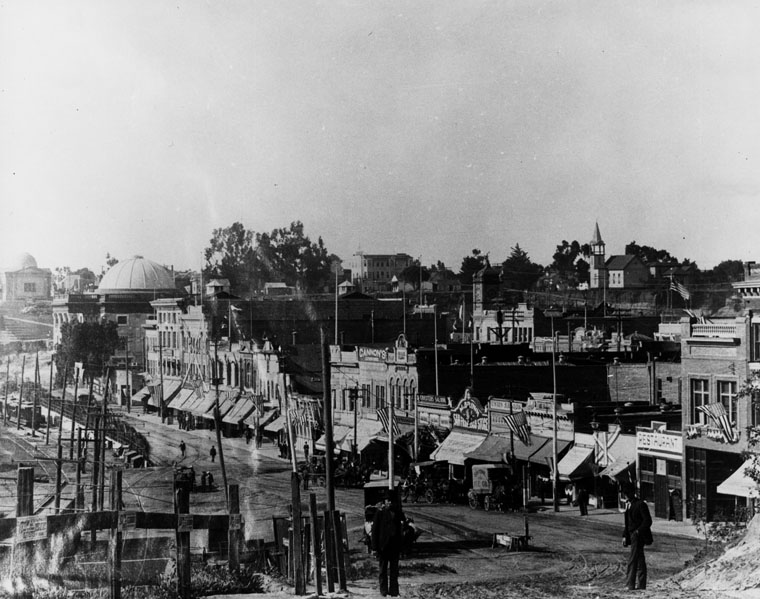 |
|
| (1910)* - San Pedro waterfront looking south along Front Street from 4th Street. City Hall is the building with the large dome; the smaller dome belongs to the Carnegie Library building. |
Historical Notes The San Pedro Carnegie library seen above opened on June 5, 1906 and was located on the Public Plaza in San Pedro, with an entrance on what is now Harbor Boulevard, across from the San Pedro Main Post Office. The library building featured a distinctive gilded dome and temple-front design, and was known as "The Lady of Beacon Street". |
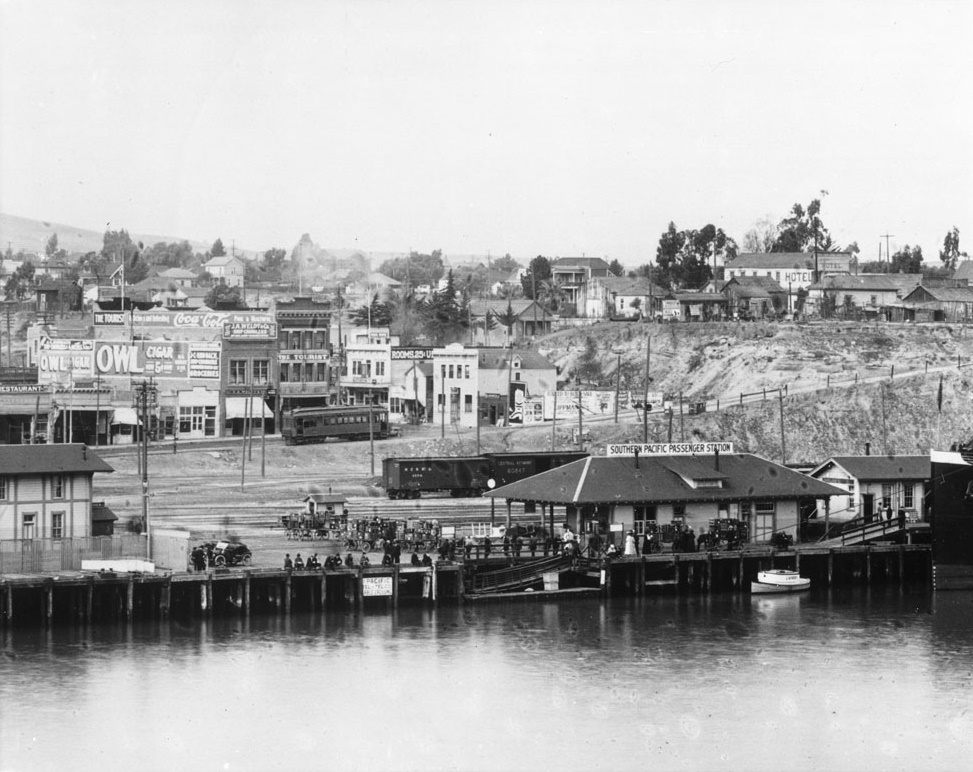 |
|
| (ca. 1913)* - View showing the Southern Pacific Passenger Station on the San Pedro waterfront. A Streetcar is seen at center-left on Front Street. |
Historical Notes Tracks on Front Street were abandoned around 1915 and the line was likely routed through to the Outer Harbor Line. |
* * * * * |
Free Harbor Jubilee
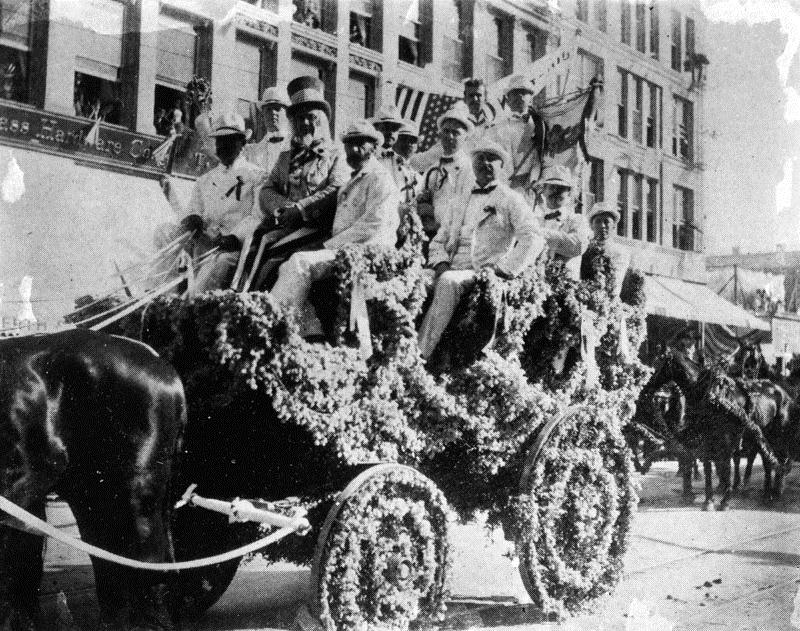 |
|
| (ca. 1899)* - Group of men ride in a decorated carriage celebrating Harbor Day in San Pedro. |
Historical Notes The Free Harbor Jubilee officially began on April 26, 1899, when President McKinley pushed a button in Washington, D.C. that signaled a barge 3,000 miles away in San Pedro to dump a load of large boulders into the sea, marking the beginning of the construction of the new port’s breakwater. |
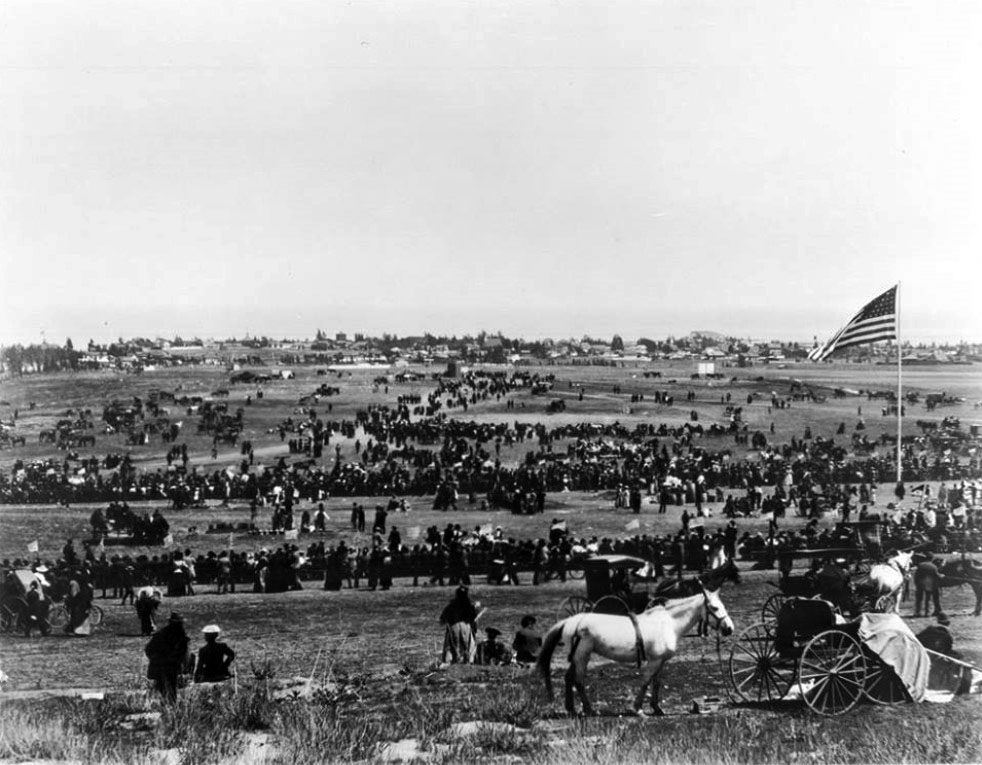 |
|
| (1899)* - The whole town came out to celebrate the Free Harbor Jubilee on April 26, 1899. |
Historical Notes The ceremony was the culmination of a 7-year battle that pitted two Southern California business titans against each other. At stake: the location of the official deep-water harbor for Los Angeles. San Pedro came out on top.* |
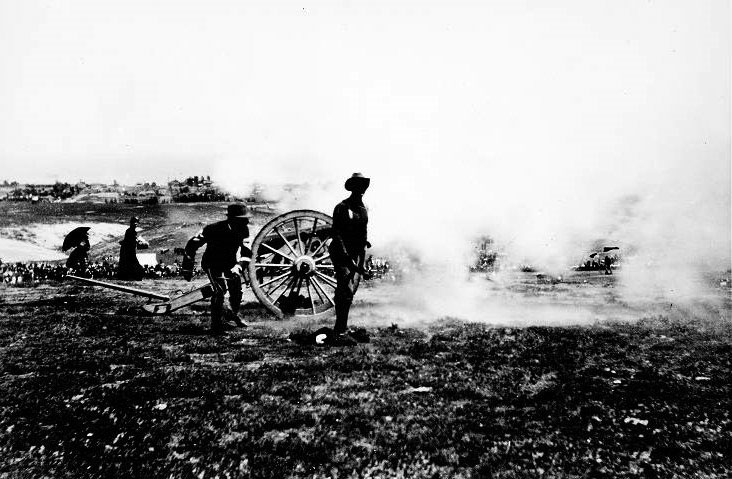 |
|
| (1899)#* - View of the firing of a cannon at the San Pedro Free Harbor celebration. |
* * * * * |
Banning Residence
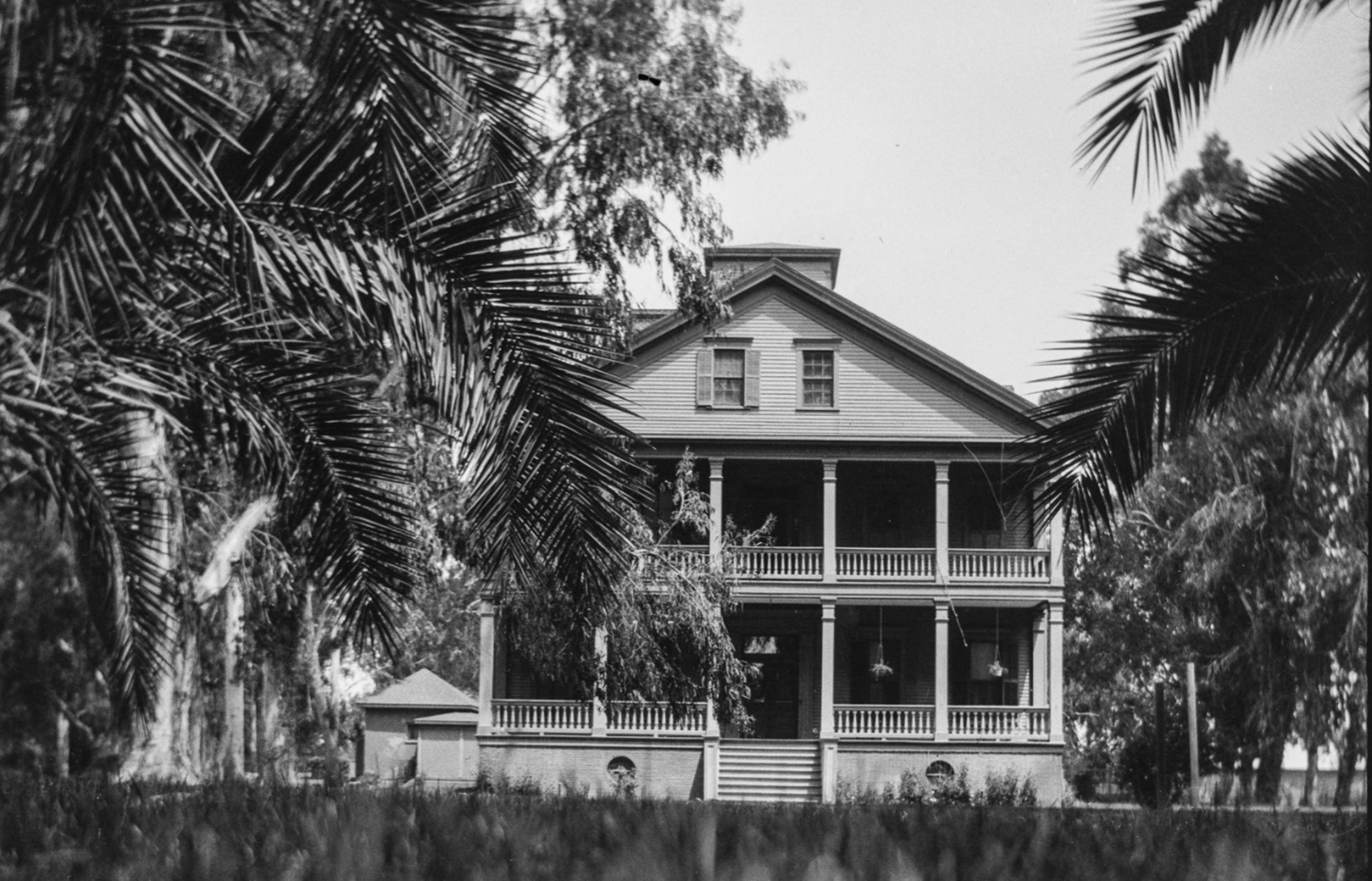 |
|
| (1890s)* – The home of Phineas Banning at 401 East M Street in Banning Park, Wilmington. Best as the founder of Wilmington, which he named after his birthplace in Delaware, Banning was also a successful entrepreneur who significantly contributed to the development of the Port of Los Angeles, earning him the title of "The Father of the Port of Los Angeles." Today, the Banning House operates as a museum. Photo by George Washington Hazard from the Ernest Marquez Collection. |
Historical Notes In 1864, Phineas Banning built this elegant Greek Revival home within sight of the harbor. It was one of the most impressive in the region – and still is. Here he enjoyed hosting visiting dignitaries and socializing with family and friends. Today the 23-room Banning Mansion and a surrounding 20 acre park are open to visitors. Phineas Banning (1830 – 1885) is known as "The Father of the Port of Los Angeles," he was one of the founders of the town of Wilmington, which was named for his birthplace. His drive and ambition laid the foundations for what would become one of the busiest ports in the world. Besides operating a freighting business, Banning operated a stage coach line between San Pedro and Wilmington, and later between Banning, California, which was named in his honor, and Yuma, Arizona. |
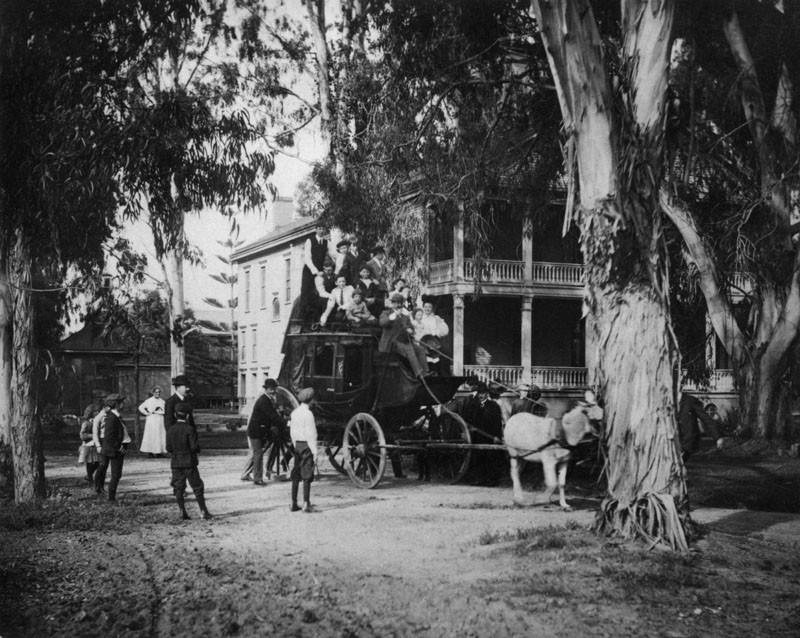 |
|
| (ca. 1900)* - Tree-shaded residence of Phineas Banning in Wilmington. In front is a mule-drawn coach piled high with people. |
Historical Notes Click HERE to see more early views of the Banning Residence. |
* * * * * |
 |
|
| (ca. 1900)* - View of a man sitting on the hillside of Dead Man’s Island looking north toward Pt. Fermin. Visible on the left is a ship approaching the breakwater. |
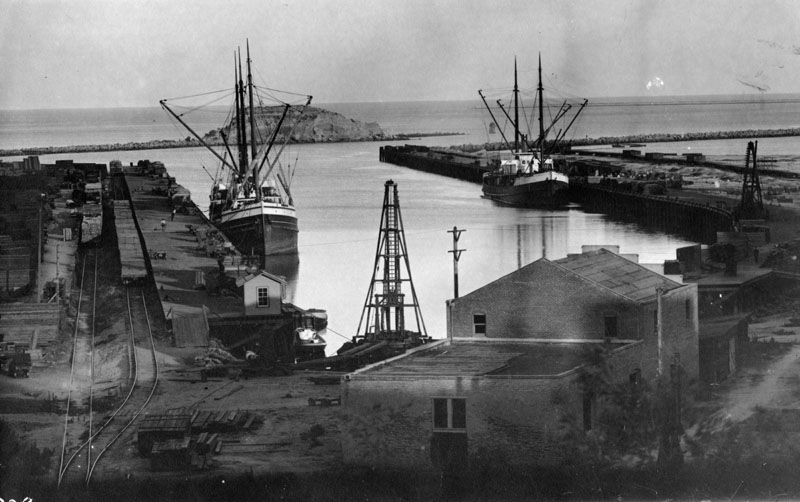 |
|
| (Early 1900s)* - View of L.A. Harbor showing fishing boats anchored in the harbor at San Pedro. Deadman's Island is behind. Railroad cars are on tracks at left, between stacks of lumber and the wharf. There are buildings in the foreground and a wharf circling around at right. In the near center is a dredge. |
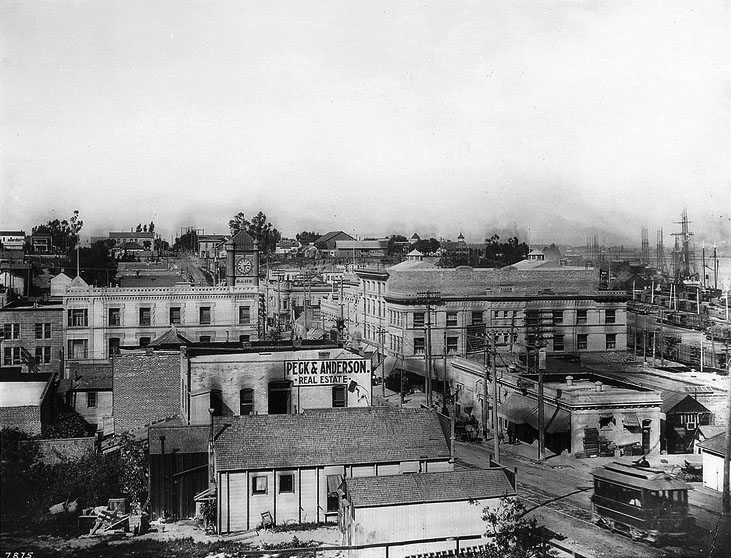 |
|
| (ca. 1903)^^ - Birdseye view of San Pedro looking north towards Wilmington from Beacon Street. A streetcar is in the lower right. The clock tower of the San Pedro Bank can be seen center-left. |
| (ca. 1903)^^ - Looking south on Beacon from Fifth Street circa 1903. Streetcar can be seen down the road. |
 |
|
| 1903)#* - San Pedro waterfront and Terminal Island panorama. In the foreground are the lumber docks and a sailing ship. |
 |
|
| (ca. 1903)#* - San Pedro Harbor docks are filled with tall ships. Lumber is stacked in the lumber yard near the tracks. Dead Man’s Island is seen in the distance. |
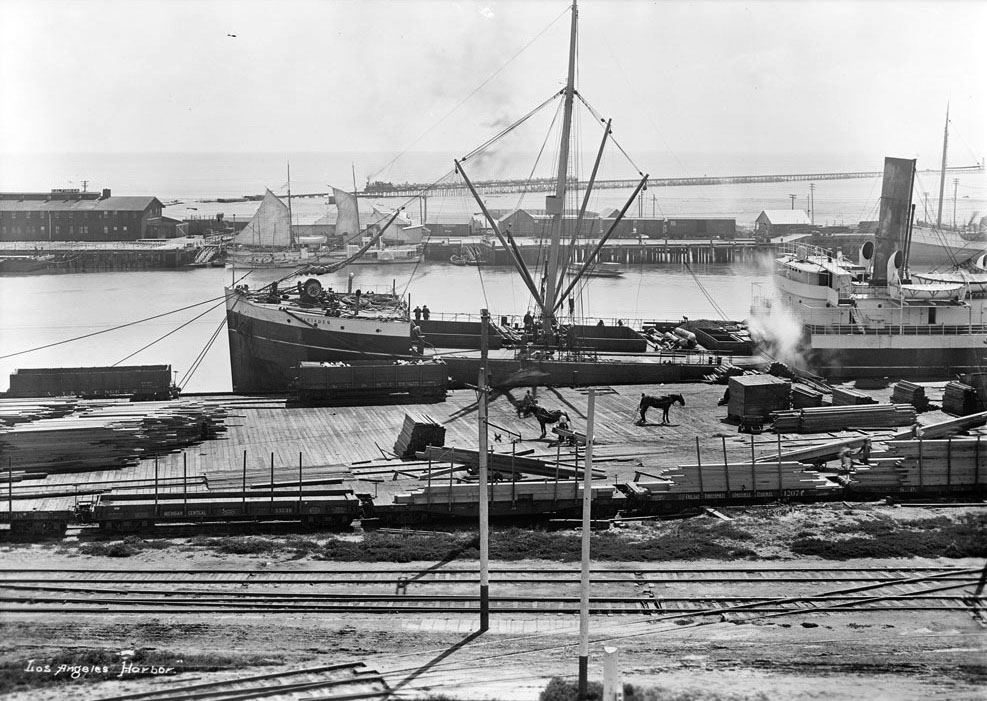 |
|
| (ca. 1903)^^ - Looking easterly up the main channel and showing the East San Pedro ferry landings. Two horses can be seen in the foreground by the lumber yard. Note the train on trestle in the background is holding rock for the new jetty construction. |
Harbor Breakwater (Constructed 1899-1911)
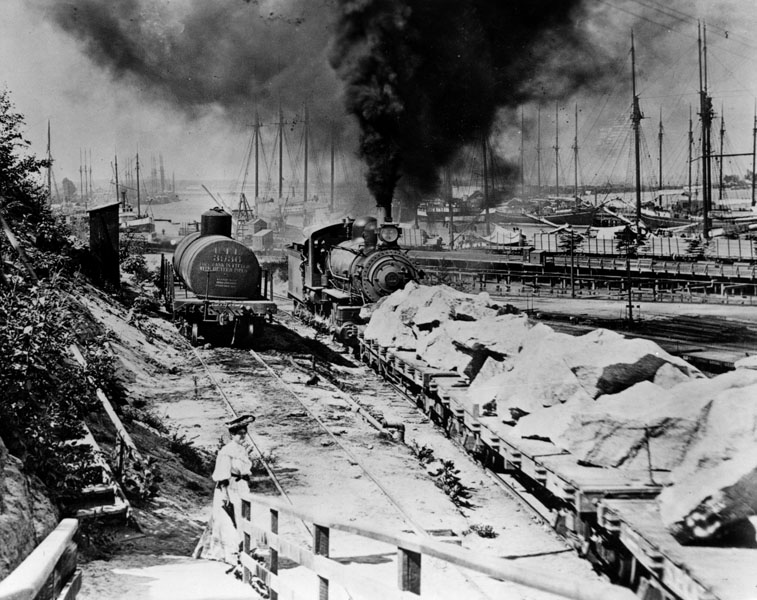 |
|
| (ca. 1904)* - A finely dressed lady stands in front of the railyard watching a train push a load of boulders to be used for construction of the harbor's new breakwater. |
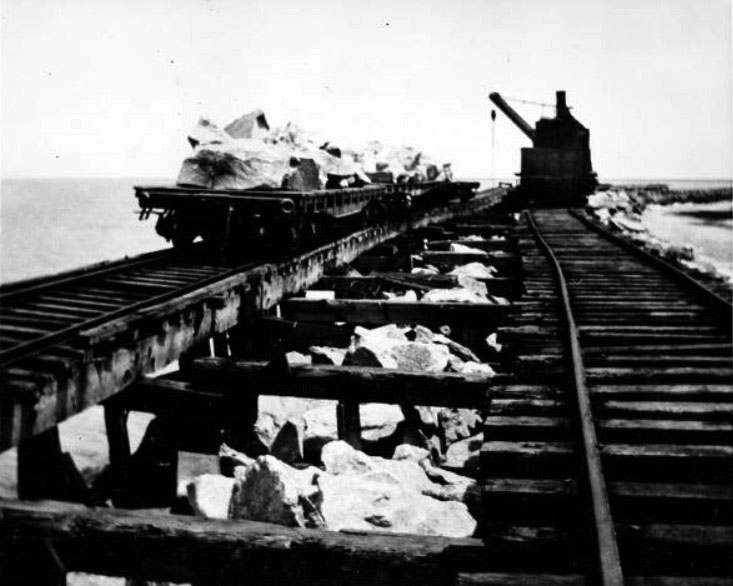 |
|
| (ca.1904)#*- Flat cars topped with rocks and railroad crane on trestles above the breakwater. |
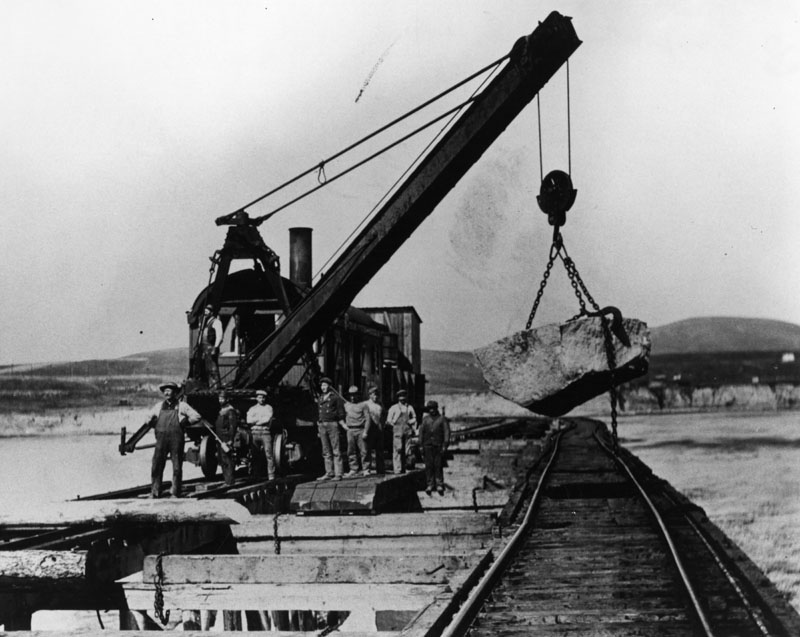 |
|
| (1904)* - Photo of workers building the breakwater in the San Pedro Harbor. Work was started in 1899. |
Historical Notes Most of the boulders used to construct the breakwater in San Pedro Harbor came from the mountains of west San Fernando Valley. Between 1898 and 1904, Southern Pacific was grading, cutting, and tunneling through the Santa Susana Mountains near Chatsworth Park as they establshed their new Coast Line connection from Ventura to Burbank. This provided San Pedro with an ample supply of boulders for their new breakwater. Click HERE to see more in Early Views of the San Fernando Valley. |
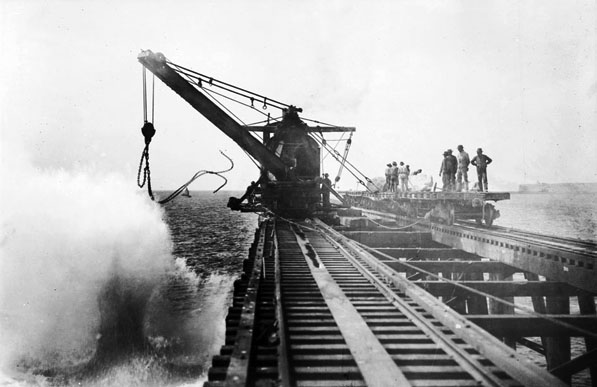 |
|
| (ca. 1900)^^ - Construction of the breakwater in San Pedro. |
Historical Notes Today, an 8.5 miles long breakwater stretches across most of the bay, with two openings to allow ships to enter the port areas behind it. The initial western section of the breakwater, called the San Pedro Breakwater, was constructed between 1899 and 1911 at San Pedro; the Middle breakwater was completed over the next twenty-five years, and the Long Beach breakwater was finished after World War II.*^ |
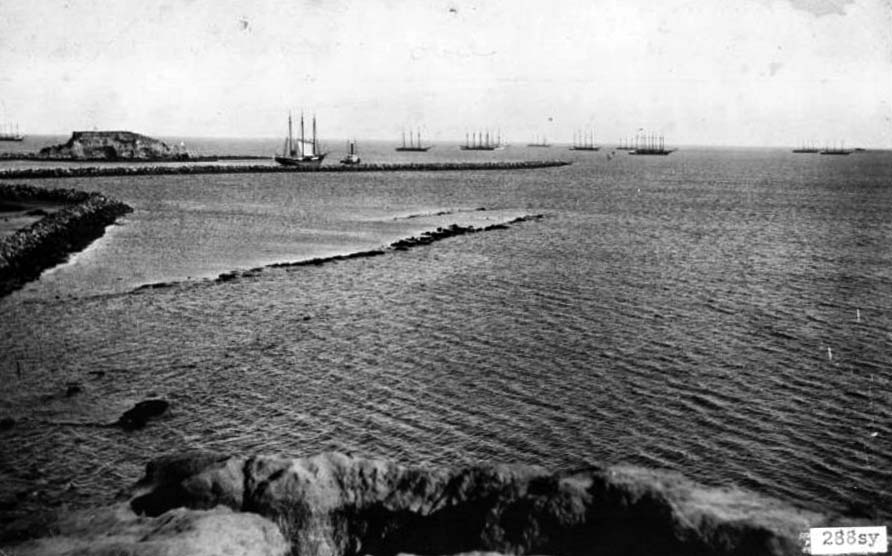 |
|
| (ca. 1905)^^ - View of the outer harbor at San Pedro, showing several sailing ships and Deadman's Island. Eleven tall wooden ships are visible in the distance. All have several masts, but none has any sails up. There is a small steam tug pulling one of the ships at left. At left, the small rocky top of Deadman's Island is visible, connected to the shore by a narrow rocky strip of land. A large breakwater cuts into the ocean from left, and the rocky shoreline is visible in the foreground. |
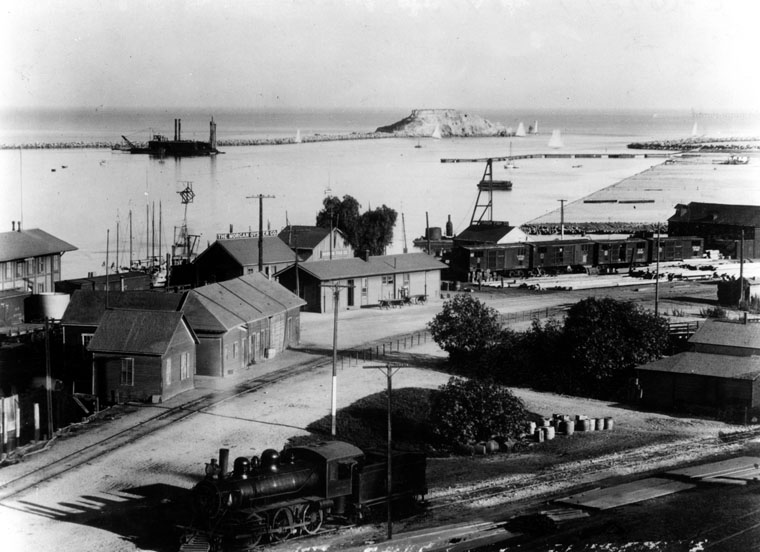 |
|
| (1905)* - View looking over a portion of San Pedro, toward Deadman's Island, and the beginning harbor. Building at extreme left is the Southern Pacific depot. In the distance is a dredge at work along the breakwater. |
Historical Notes Deadman's Island was one of two islands near San Pedro in the 19th century. The land, sometimes referenced as Deadman's Island, Isla Del Muerto, and Reservation Point, was dredged away in 1928 as part of a harbor development effort. Rattlesnake Island, the other islet in the area, became Terminal Island.*^ |
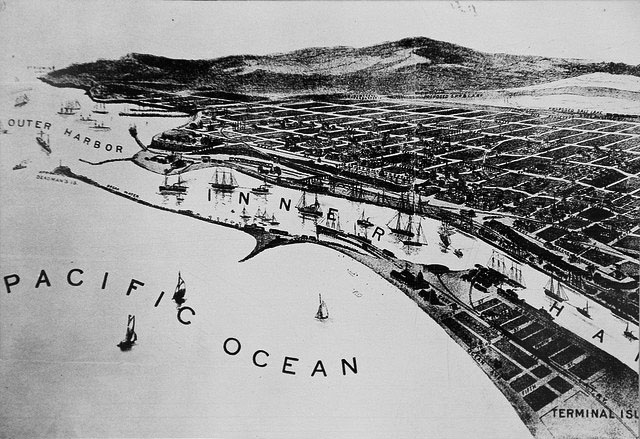 |
|
| (1905)#* - Photo of a lithograph of plan of San Pedro and its inner and outer harbors. |
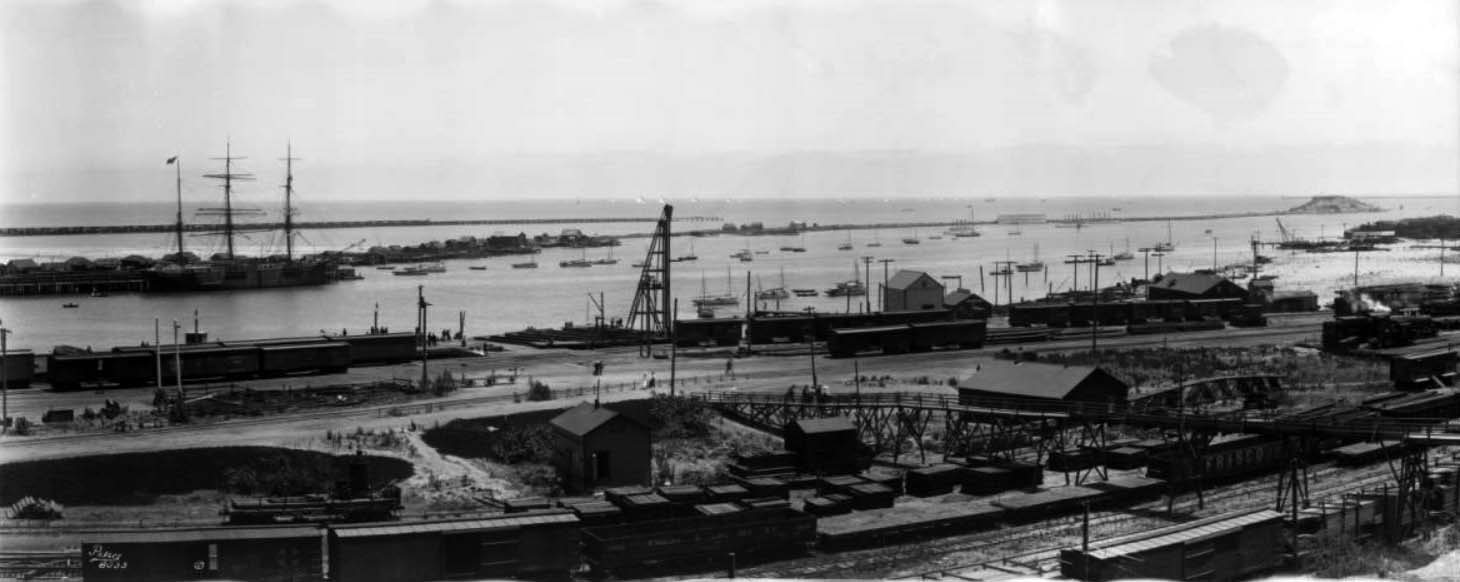 |
|
| (1905)* - A panoramic view of a part of the docks of Los Angeles Harbor in San Pedro. Railroad tracks run across the immediate foreground, as well as alongside the docks, and there are cargo and flatbed train cars on many of the tracks. There are two long breakwaters, one in the distance that is low and simple, and another closer to the shore that is lined with buildings. A three mast tall ship is docked at a pier along the inner breakwater. There are a couple dozen small sailboats anchored inside the breakwaters. |
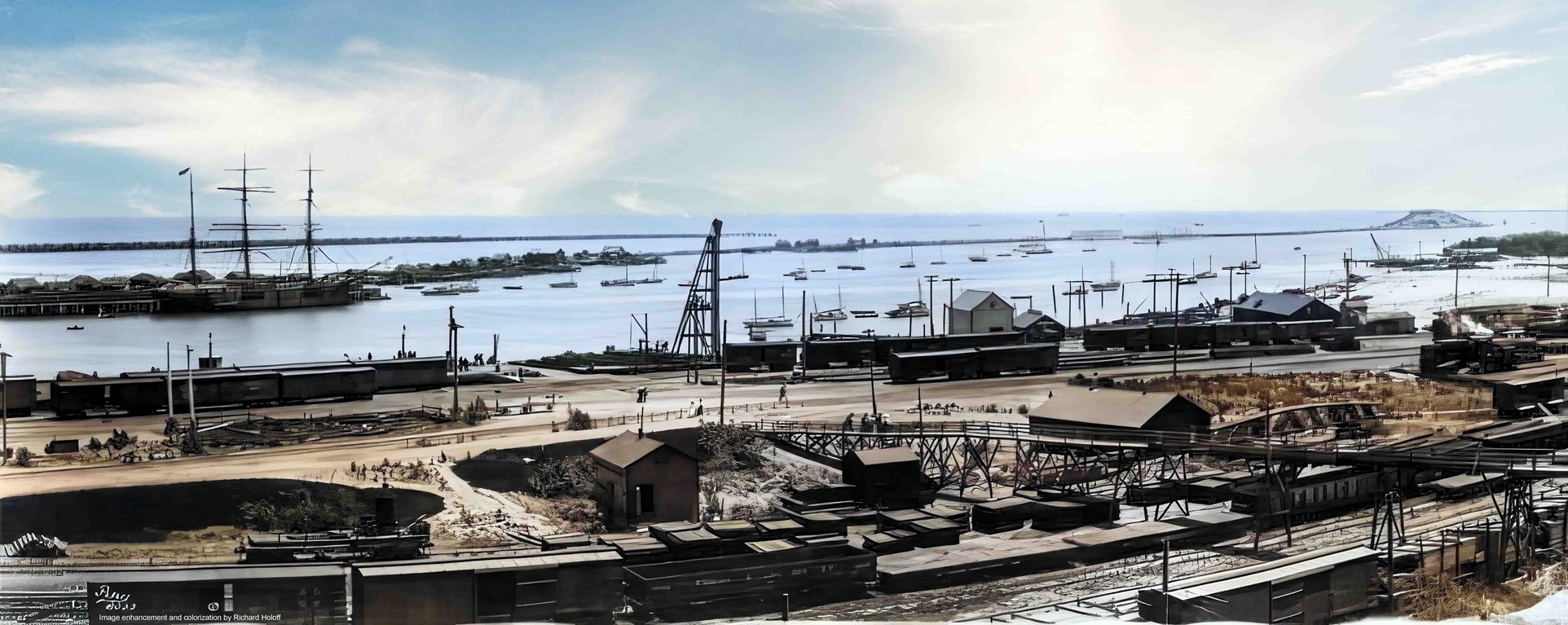 |
|
| (1905)** - A panoramic view of the Los Angeles Harbor in San Pedro. Photo by C.C. Pierce; Image enhancement and colorization by Richard Holoff. |
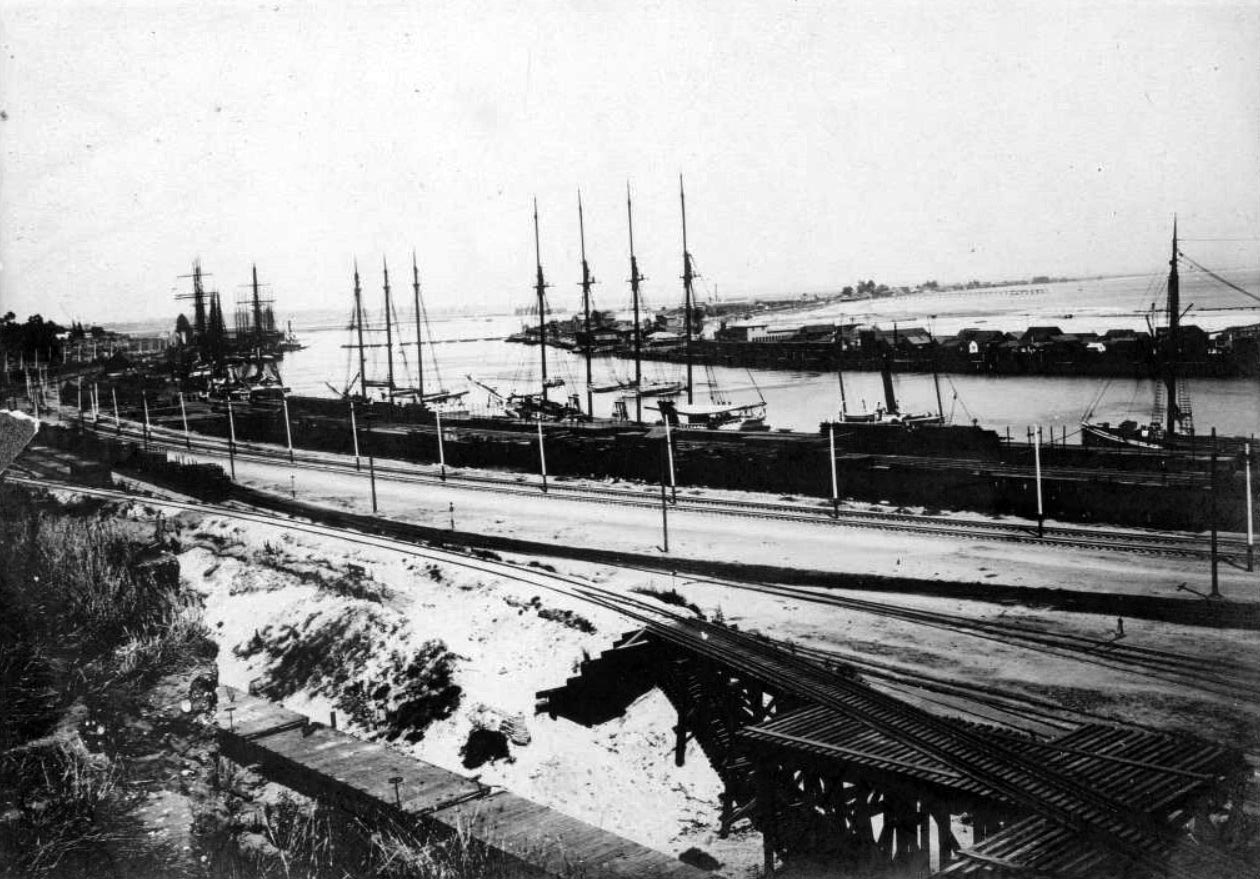 |
|
| (1906)^^ – View showing the entrance to San Pedro Harbor with Terminal Island in the distance. Railroad tracks can be seen running along a wharf from the foreground at right into the distance at left. Note the rail bridge in the lower right. Several tall ships and a steamship are docked along the wharf at left. A section of the harbor curves around in a semicircular path in the background at left. |
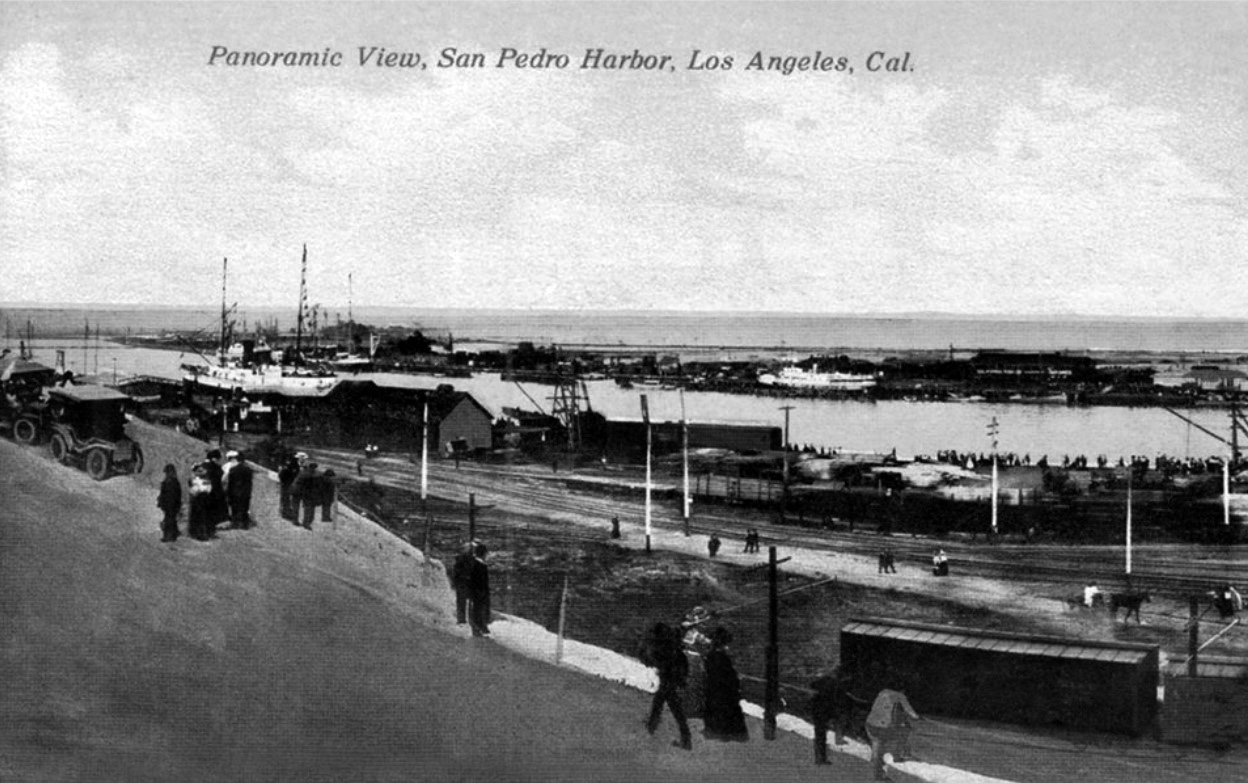 |
|
| (ca. 1907)^ - Panoramic postcard view showing people looking down toward the San Pedro Harbor. |
Wilmington Transportation Company
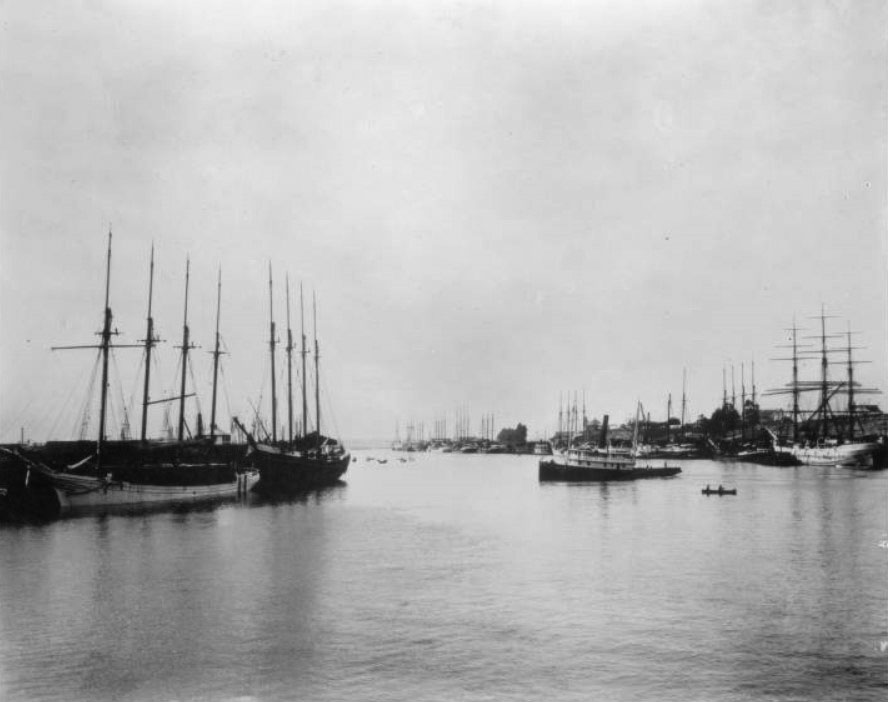 |
|
| (Early 1900s)^ – View showing the main channel of the Los Angeles Harbor. Both sides of the channel are lined with large, docked sailing vessels. Most of these have at least three masts, and both ships in the foreground on the left have four. There is a steam tugboat in the middle of the channel, traveling from the right side to the left. To the right of the tugboat is a small skiff occupied by two people. The Wilmington Transportation Company owned many of the steamboats that would transport passengers from San Pedro to Catalina. |
Historical Notes Wilmington Transportation Company (WTC) was founded in 1877 by the Bannings, and incorporated by Phineas Banning in 1884. In 1887, Santa Catalina Island owner George Shatto asked Captain William Banning to schedule one of his coastal steamers to make three weekly trips between Avalon and San Pedro to accommodate his vision of turning the island into a tourist destination. Banning’s Wilmington Transportation Company’s earliest vessels included the Cricket, Ferndale, Amelia, and Nellie. Each of these carried passengers between San Pedro and Avalon. In 1892 the Banning brothers, William, Hancock, and Joseph Brent, purchased the island for $128,740. WTC was deeded to the newly incorporated Santa Catalina Island Company, allowing the Bannings to enforce a monopoly of only WTC boats landing tourists on the island. With the success of WTC came the development of outside competitors.* |
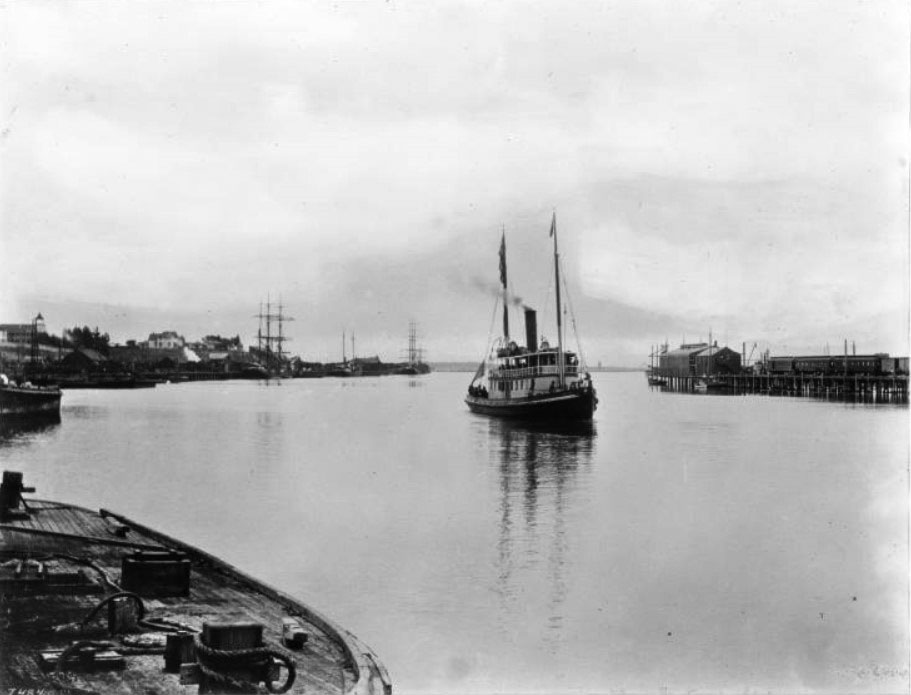 |
|
| (ca. 1905)^ – View of the Wilmington Transportation Company's steamboat "Falcon" in San Pedro Harbor. The boat, engaged in service to Catalina Island, is visible at center in the middle of the harbor. Harbor buildings are visible to the right, and town buildings are visible to the left. What is either a small dock, or the deck of a flat boat is visible in the lower left foreground. The boat itself sports a two-leveled cabin and two masts. People lean along the edges of the deck. |
Historical Notes The S.S. Falcon along with the S.S. Warrior played a significant role in Catalina Island’s early transportation history. They were an important part of the Wilmington Transportation Company fleet for many years. They carried hundreds of passengers across the channel to Catalina Island as well as freight and fresh water for the Island residents. |
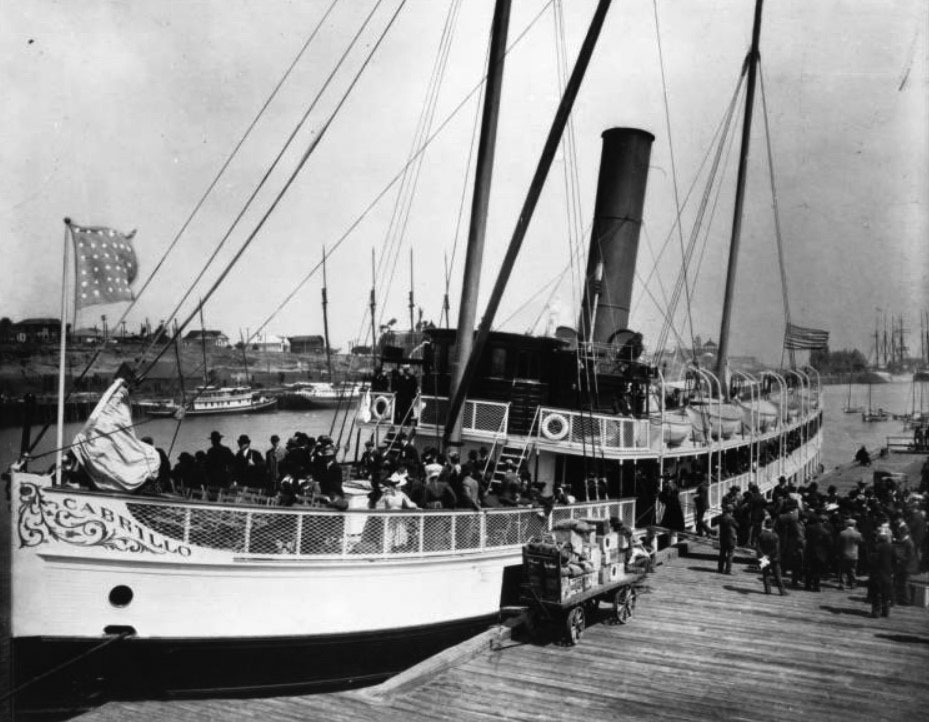 |
|
| (ca. 1904)^^ – View showing the Catalina passenger steamer S.S. Cabrillo loading passengers and freight alongside a Wilmington wharf in San Pedro. In addition to the prominent smoke stack rising from behind the pilothouse, the ship has two tall masts. A dark flag with light stars flies from the bow, and an American flag is on the stern. In the background there is one other unidentified steamer, along with numerous unidentified sailing vessels and several small sail fishing vessels. |
Historical Notes The S.S. Cabrillo, built at the Banning Company's shipyards at Port Los Angeles, was launched in 1904. Other vessels operated by the Banning Company were the gasoline screw Cricket, the gasoline screw Catalina, and the steam yacht Companero. |
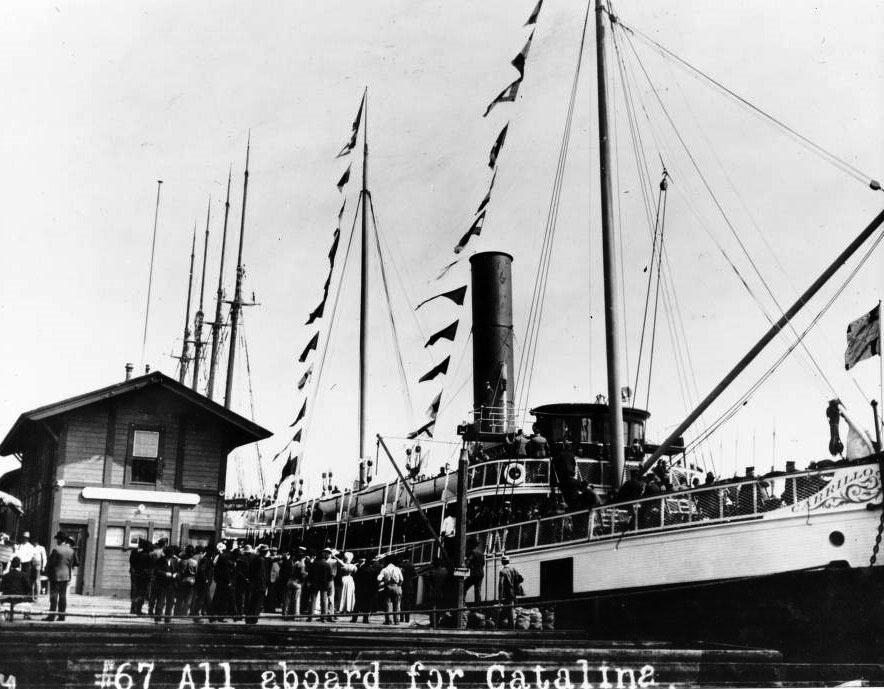 |
|
| (1907)^^ - View of Shriners boarding the S.S. Cabrillo steamboat ferry to Santa Catalina Island at the LA Harbor. |
Historical Notes After Phineas Banning passed away in 1885, the business was carried on by his three sons, William, Joseph Brent, and Hancock. The company purchased Santa Catalina Island, developed it as a resort and provided the ships for transportation. Wilmington Transportation Company, Santa Catalina Island Company, and Wilmington Development Company were subsidiary firms of the Banning Company. The company's real estate interests also grew and included land in Los Angeles, Pasadena, Newport Beach, as well as petroleum leases near Wilmington and Newport. The final dissolution of the company came in 1920 at the time of the death of Joseph Brent Banning. After this period, business papers are in the names of William Banning or Hancock Banning individually. |
Click HERE to see more in Early Views of Catalina |
San Pedro City Hall (1905 - 1908)
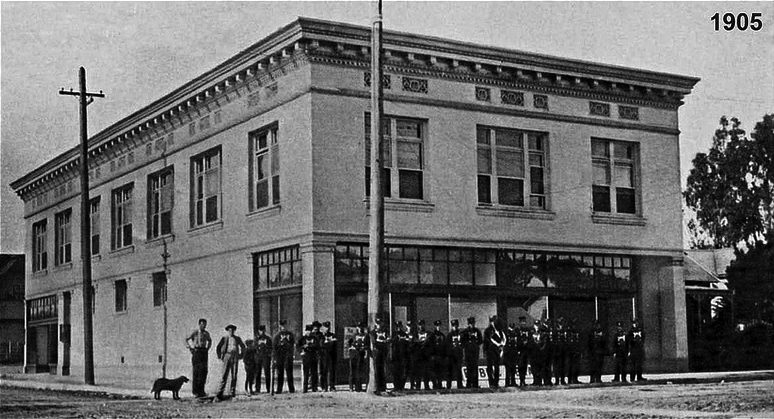 |
|
| (1905)^* - San Pedro's finest pose in front of their new City Hall with headquarters for the fire and police departments. |
Historical Notes The above building was San Pedro's City Hall from 1905 to 1908. It was built in 1905 at the northwest corner of 11th Street and Palos Verdes Street. The mayor at the time was Edward Mahar and he lived only one block south of there. The building served as San Pedro's city hall for only 3 short years when a new building was constructed on Beacon Street shortly after San Pedro was consolidated with Los Angeles in 1909. The building still stands today and is now the City Hall Market and the Alhambra Bar.^*^ |
 |
|
| (ca. 1904)#^*– Panoramic view showing Beacon Street on the left and the harbor with Tall Ships on the right. The San Pedro City Hall would be built in 1909 at the end of the park in the foreground. |
San Pedro City Hall (1909 - 1928)
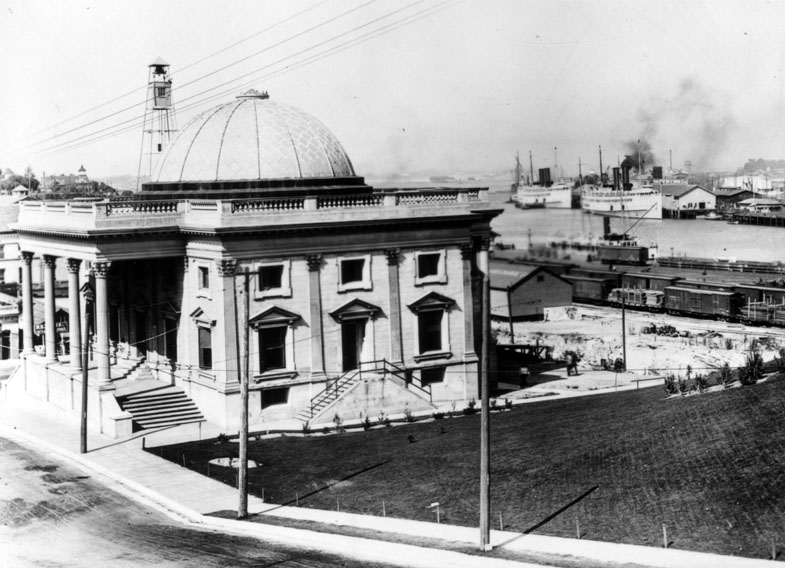 |
|
| (ca. 1909)* - View showing San Pedro City Hall located on Beacon between Wall and 5th streets. A rail yard and the Los Angeles Harbor are visible in the background on the right. |
Historical Notes The Classical Revival style City Hall building was constructed in 1909, the year San Pedro was annexed by the City of Los Angeles. It was designed by F.E. Allen of Pasadena and cost $40,000 to build.* |
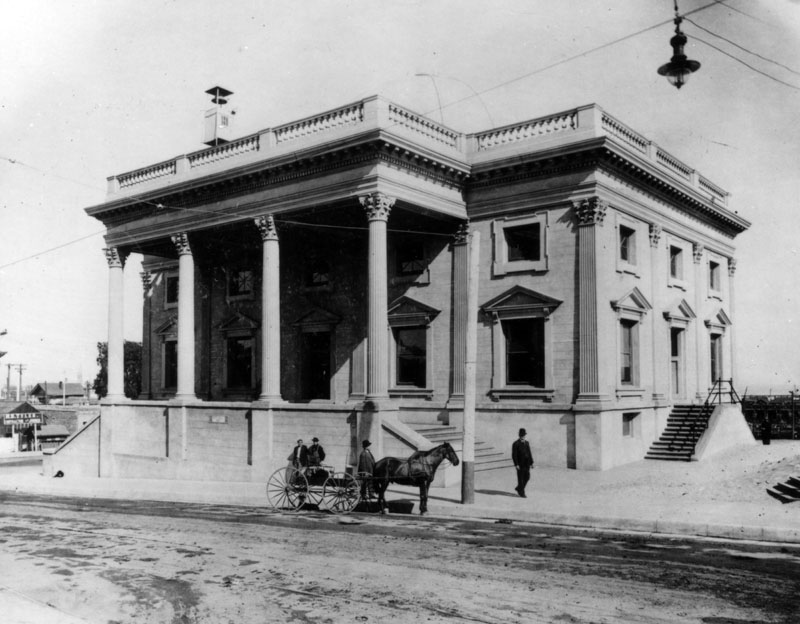 |
|
| (ca. 1909)* - Front view of the San Pedro City Hall. A horse-drawn wagon is parked in front of it on an upaved Beacon Street. |
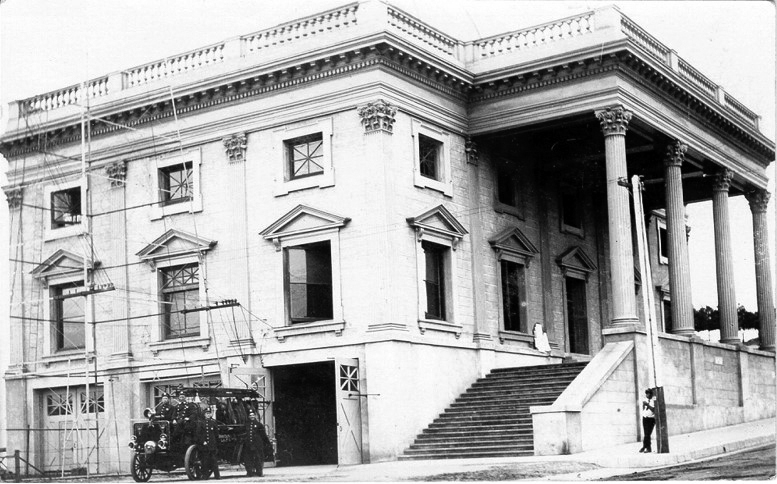 |
|
| (ca. 1909)^#* - Side view of San Pedro City Hall showing firemen posing in front of their new LAFD Engine and Station. |
Historical Notes After San Pedro was annexed by Los Angeles in 1909, LAFD Hose Co. 6 was incorporated into the new San Pedro City Hall building at 630 Beacon Street. |
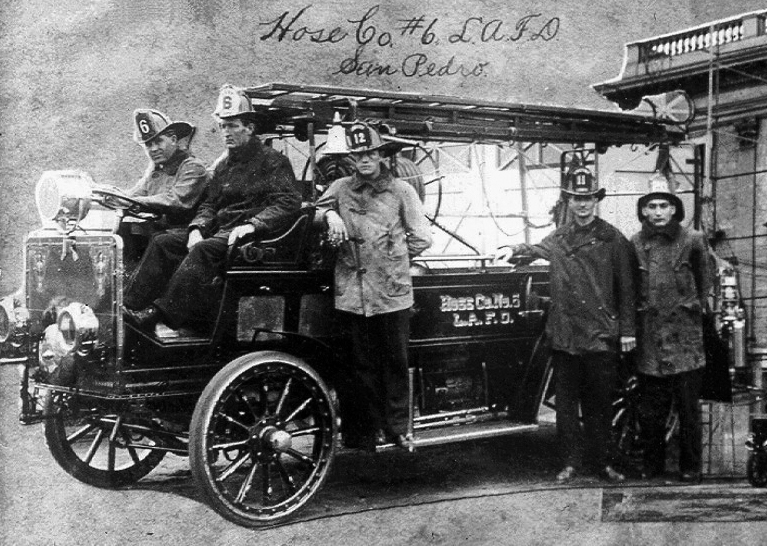 |
|
| (ca. 1909)^#* - Close-up view of Hose Co. #6, LAFD, San Pedro adjacent to their new station at San Pedro City Hall. |
Historical Notes The first San Pedro fire volunteers formed in 1889. Their fire house was located on Sixth Street, across from Crockers’ Hall. In 1905 they moved to the northwest corner 11th Street and Palos Verdes Street, into the building used, for just a brief period time, as San Pedro’s City Hall. On August 28, 1909, Hose Company No. 6 was organized. The fire house was located at 630 Beacon Street (Wall & Beacon) which was part of the new San Pedro City Hall. In 1915, Hose Company No. 6 was disbanded to organize Engine Company No. 36. Their new location was 638 Beacon Street, again site of San Pedro's City Hall.^#* |
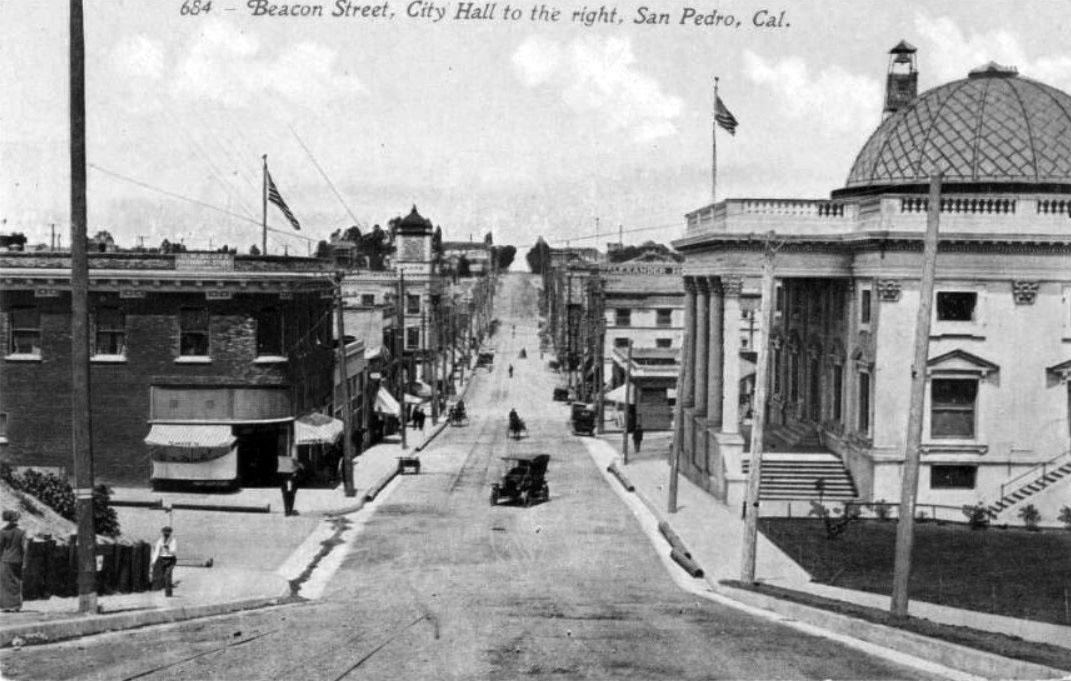 |
|
| (ca. 1910)^#^^ - Postcard view looking down Beacon Street with City Hall at right. Horse-drawn wagons and an early model car share the street. |
 |
|
| (1909)* – (Left Panel) Panoramic view of San Pedro with City Hall at left and harbor on the right. |
Historical Notes The beautiful Classical Revival style City Hall building would be demolished in 1928 to make room for the current San Pedro City Hall and Municipal Building. |
.jpg) |
|
| (1909)* – (Right Panel) Panoramic view of San Pedro Harbor with Deadman's Island at right. |
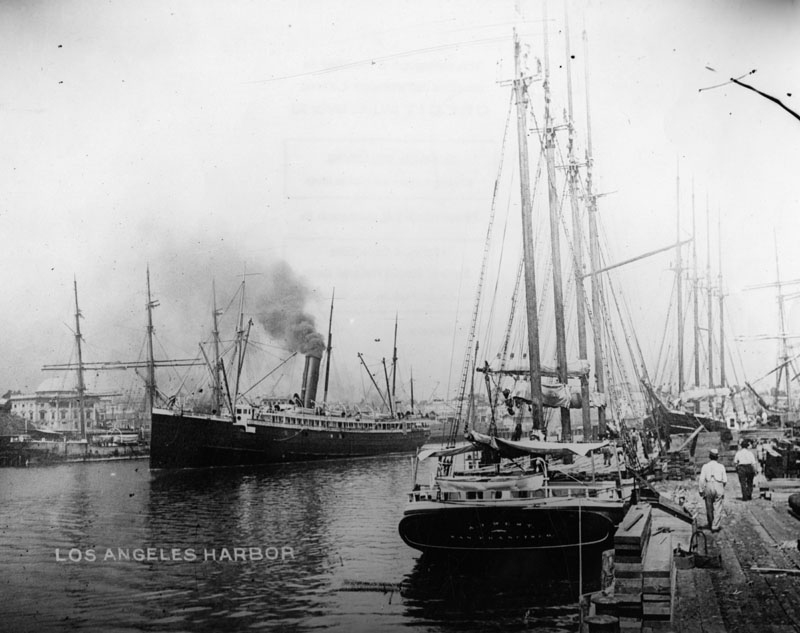 |
|
| (ca. 1909)* - A steam ferry and sailing freighters in the Los Angeles Harbor at San Pedro. The new City Hall can be seen in the background (left side of photo). |
Great White Fleet
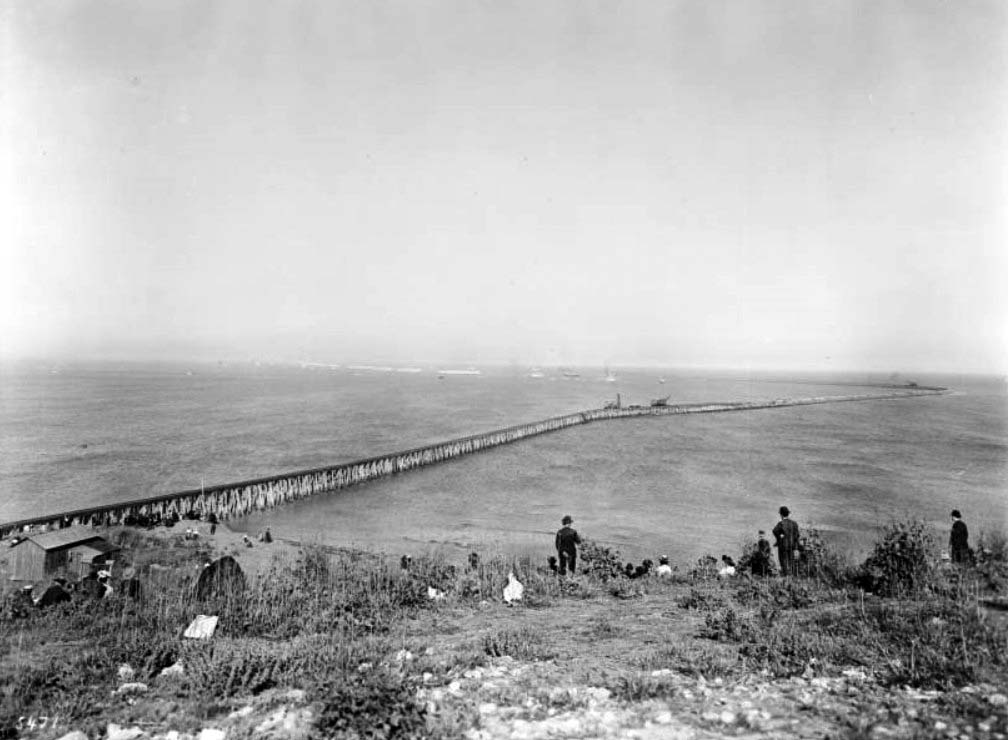 |
|
| (1908)^^ - Photograph of spectators watching the "Great White Fleet" enter the Los Angeles Harbor, April 1908. Spectators crowd the base of the breakwater to get a better view of the ships, as they will soon pass the area and head towards the piers. |
Historical Notes The U.S. Atlantic Battle Fleet, nicknamed the Great White Fleet, debuted on the world stage during the Spanish-American War and was one of the markings of President Theodore Roosevelt's "Big Stick" diplomacy.^^ |
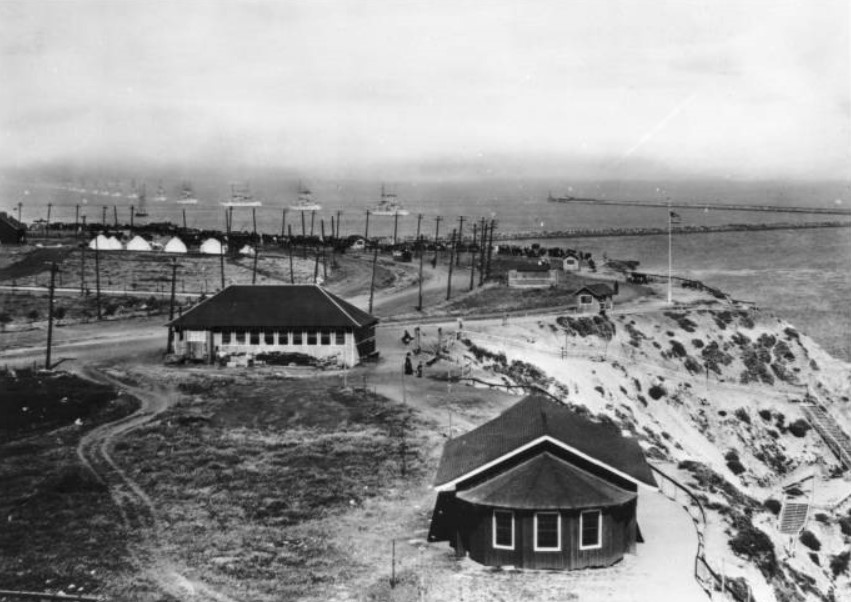 |
|
| (1908)^^ - Photograph of the America's Great White Fleet passing the San Pedro breakwater to enter Los Angeles Harbor. Beach houses are visible scattered along the side of a winding road lined by utility poles, while the United States Atlantic Battle Fleet steams across the harbor in formation. The breakwater is visible to the right, in front of some wooden steps built as a way to climb the dunes. |
Historical Notes From December, 1907 to February, 1909 the US Atlantic Fleet steamed around the world on a mission of 'Gunboat Diplomacy'. The ships, commonly known as the 'Great White Fleet' due to their white-painted hulls, called in ports the world over, impressing foreign dignitaries with the appearance of great power. The entire affair was designed to impress, and everything was done to make sure the fleet's appearance was perfect. The ships, however, were not all they appeared to be. HMS Dreadnought had been in commission for a year, effectively rendering all the US ships obsolete. Two of the ships had such severe mechanical problems that they could not complete the cruise, and two more were obsolete and unfit for battle. It was great show, but the military value of the fleet was questionable.^^ |
.jpg) |
|
| (1908)* - Groups of people on shore, watch as the "Great White Fleet" enters the L.A. Harbor. The tressle for the breakwater is in the foreground. Breakwaters can be seen in the background (right side). |
 |
|
| (1908)^x^ - Visitors line up in San Pedro to tour a US Navy battleship, one of a number of war vessels of the Great White Fleet, which circumnavigated the globe between 1907 and 1909. |
Historical Notes This was the last great hurrah for the age of white ships, buff masts and high diplomacy on the high seas. As soon as the ships returned from the cruise they were stripped of their fancywork and much of their bridgework, painted gray, and had their pole masts replaced by functional but unsightly cage masts.^^ |
* * * * * |
.jpg) |
|
| (1909)* - Local school kids stand along an unpaved Pacific Avenue waving Americal flags as President Taft and his motorcade drive by. |
Historical Notes On August 28, 1909, San Pedro and Wilmington were annexed into Los Angeles and became Los Angeles Harbor. On October 9,1909, President Taft visited San Pedro to see the harbor and to see the land which would become Fort MacArthur. His motorcade went down Pacific Avenue and the local school kids stood along the unpaved road and waved American flags. Taft was the only Sitting President to visit San Pedro. |
| (ca. 1907)^^ - Photograph of Spectators watching a bicyclist on Beacon Street, between Fifth Street and Sixth Street looking east. The lone cyclist occupies the dirt street which is lined with a sparse crowd of onlookers standing in front of the commercial facades. A man watches from a balcony. One legible sign reads "Restaurant". |
| (ca. 1905)^^ - View of Beacon Street looking north. The sign on the building on the left reads “GEO. H. PECK & CO. REAL ESTATE”. The building with the clock tower in the background is the San Pedro Bank Building. |
| (1910)^*^* – View of Beacon Street with American flags seen throughout in what appears to be 4th of July. Streetcars share the street with horse-drawn wagons. |
| (1910)^^ - Beacon Street in San Pedro looking north. Horse-drawn carriages can be seen throughout. A man crosses the street and walks towards the San Pedro Bank Building with its prominent clock tower |
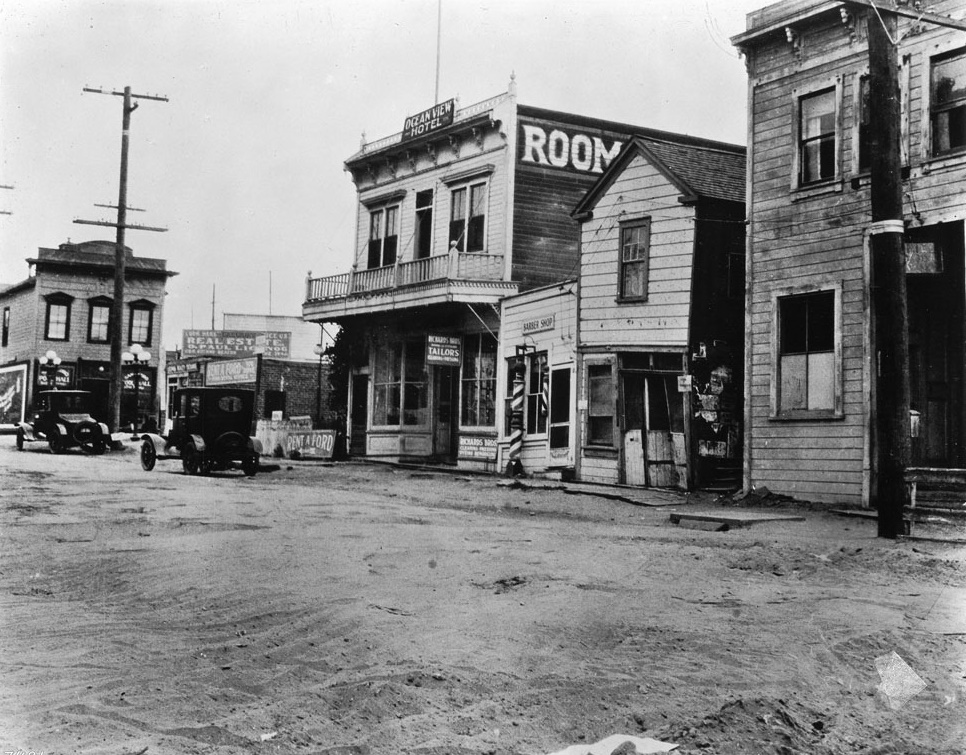 |
|
| (1910s)^^ - View of Front Street (the site of 'new' City Hall) in San Pedro, Los Angeles. |
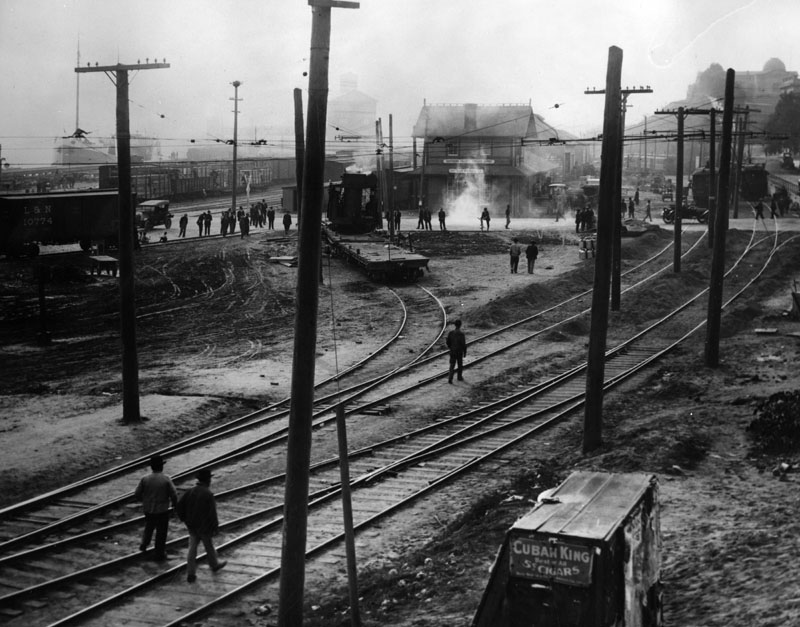 |
|
| (1910)* - View of the Southern Pacific freight yard and depot looking south from 4th Street and Harbor Boulevard in San Pedro. |
 |
|
| (ca. 1911)* - Elevated boardwalk over water runs along a street on the waterfront. Mud from dredging the harbor was used to elevate the land along the waterfront. |
Historical Notes “Wilmington streets have all been renamed. Well, not all, but almost all of them have been renamed. And Canal Street is the most obvious. Because Canal Street was literally a canal. The buildings were built up high, they were on stilts because this was a mud flat and it flooded all the time. So they ended up filling in the street so that when you look at it now, the buildings that are there, some of the old buildings, the first floors are now the basements." Canal Street is gone. It's now known as Avalon Boulevard.^*# |
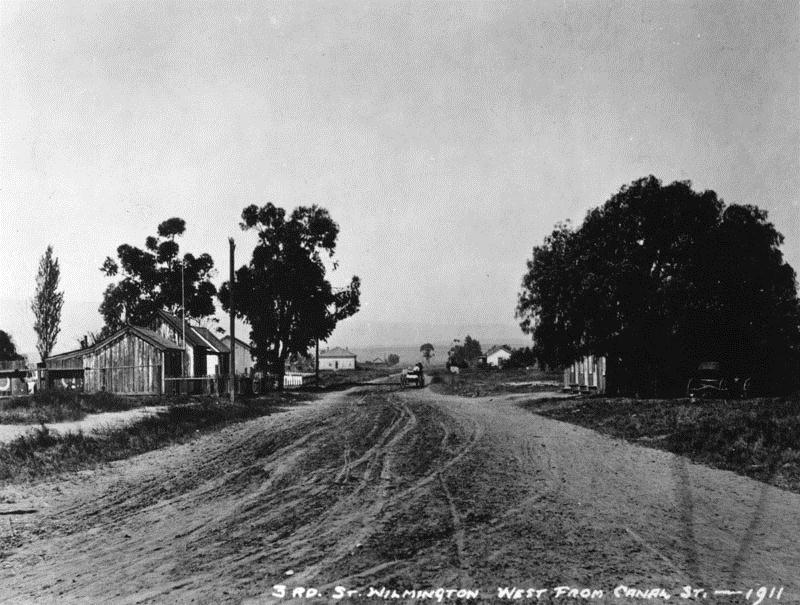 |
|
| (1911)* - View of Third Street west from Canal Street (now Avalon). A horse-drawn wagon can be seen down the unpaved road. |
.jpg) |
|
| (1911)* - View of Canal (now Avalon Blvd.) and 3rd Streets in Wilmington. St. John's Episcopal Church is seen on the right. A railroad track cuts across the foreground. |
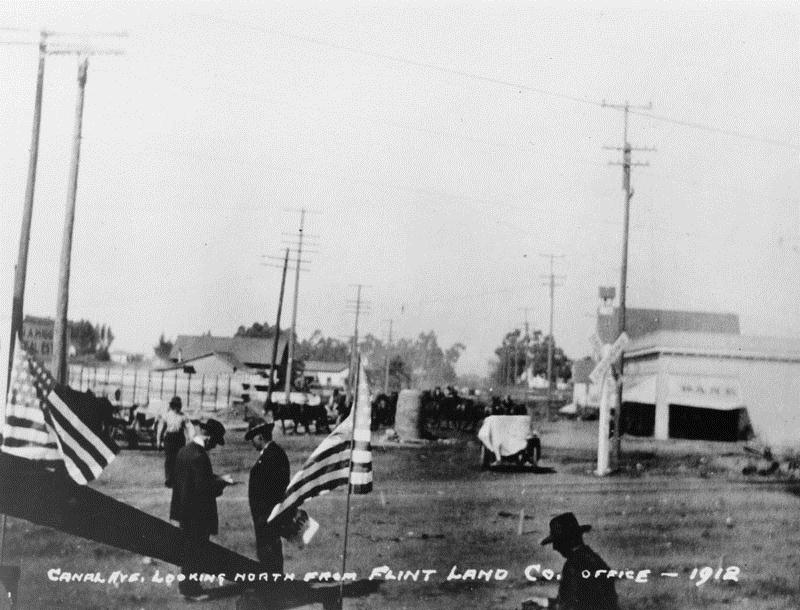 |
|
| (1912)* - Canal Ave (now Avalon Blvd), Wilmington, looking north from the Flint Land Co. office. |
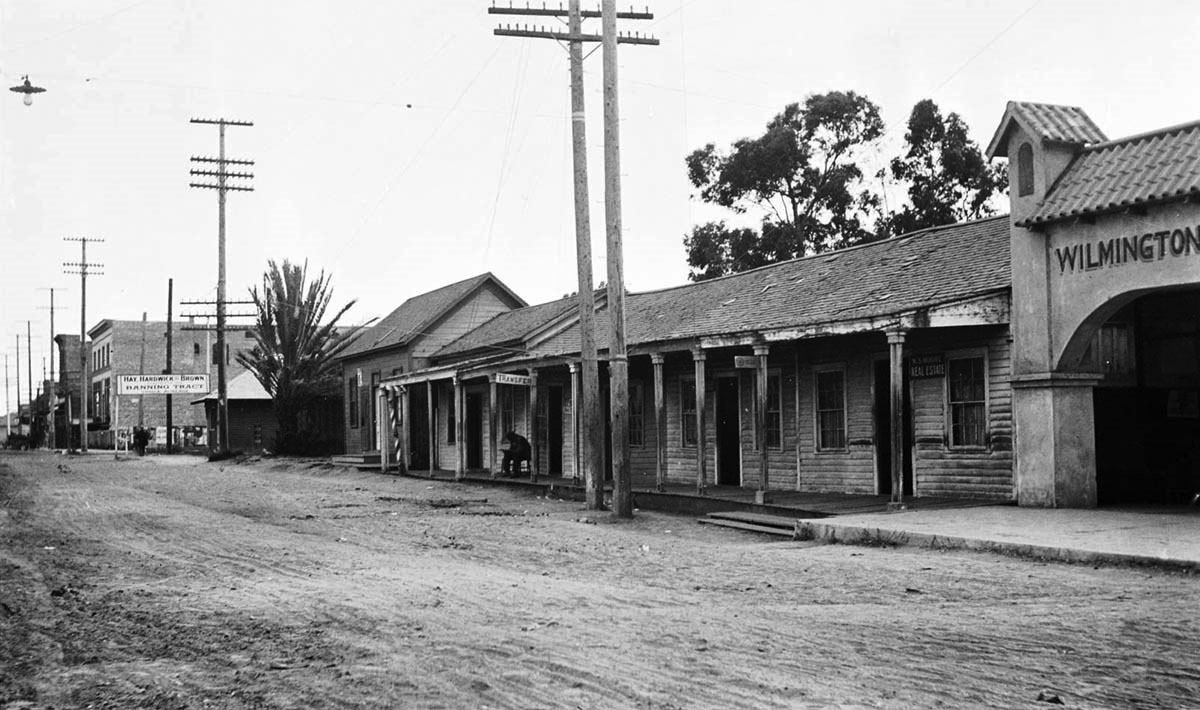 |
|
| (ca. 1900)^^ – View of Canal Street (later renamed Avalon Boulevard) looking toward C Street from south of D Street. There is a long, low wooden building at right with a covered porch held up by rectangular posts with a sign for the W. S. Moore Real Estate. To the far right is the Wilmington Chamber of Commerce. |
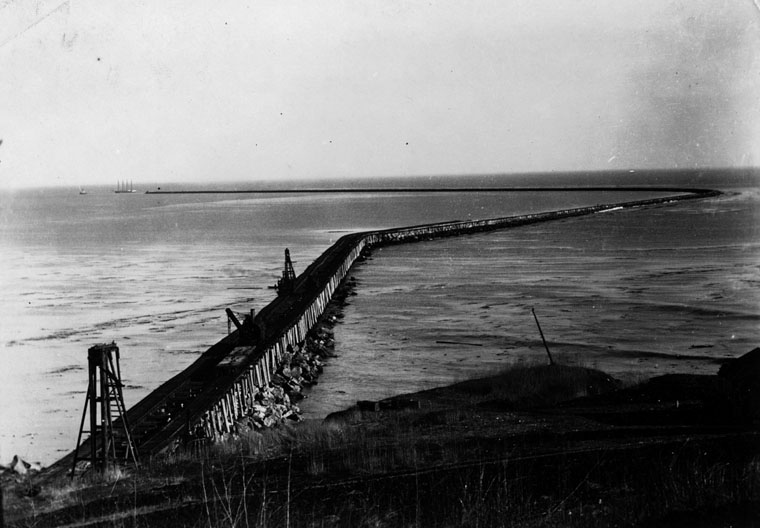 |
|
| (ca. 1910s)* - Breakwaters at San Pedro which is 9,250 feet in length. |
Historical Notes Between 1911 and 1912 the first 8,500-foot section of the breakwater was completed, and the Main Channel was widened to 800 feet and dredged to a depth of 30 feet to accommodate the largest vessels of that era.*^^ |
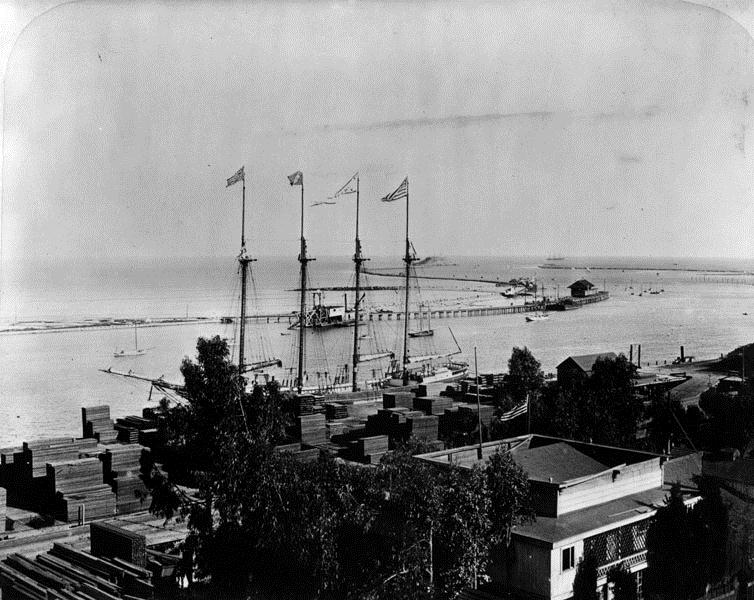 |
|
| (ca. 1910s)* - View of a large four masted ship anchored alongside a lumber dock at L.A. Harbor. Breakwaters and Deadman's Island can be seen in the background. |
Historical Notes Over the years the harbor would see additional improvements and expansions: In 1912 the Southern Pacific Railroad completed its first major wharf at the port. In 1913, the Los Angeles Angels Lighthouse was constructed at the end of the breakwater. During the 1920s, the port passed San Francisco as the west coast's busiest seaport. In the early 1930s a massive expansion of the port was taken with the construction of a breakwater three miles out that was over 2 miles in length. In addition to the construction of this outer breakwater an inner breakwater was built off of Terminal Island with docks for sea going ships and smaller docks built at Long Beach.*^ |
* * * * * |
Please Support Our CauseWater and Power Associates, Inc. is a non-profit, public service organization dedicated to preserving historical records and photos. Your generosity allows us to continue to disseminate knowledge of the rich and diverse multicultural history of the greater Los Angeles area; to serve as a resource of historical information; and to assist in the preservation of the city's historic records.
|
More Historical Early Views
Newest Additions
Early LA Buildings and City Views
History of Water and Electricity in Los Angeles
* * * * * |
References and Credits
* LA Public Library Image Archive
**DWP - LA Public Library Image Archive
*#South Bay Daily Breeze: San Pedro’s Bascule Bridge; The Free Harbor Day Jubilee
#^Flickr: History of San Pedro Harbor and Terminal Island
#* Huntington Digital Library Archive
#^^California State Library Image Archive
#^*Library of Congress Image Archive: 1909 Panorama with City Hall: 1919 U.S. Naval Fleet
#*^Facebook.com - San Pedro's Original Website, San Pedro.com
#**Flickr.com: Michael Ryerson
*#*KCET - Inventing LA: Port of Los Angeles; L.A.'s First Railroads Connected the Region to the Global Economy; Why Is SoCal's Harbor Split Between Two Cities?
*^*California Historic Landmark Listing (Los Angeles)
^^*S.S. Avalon and S.S. Catalina
**^Wilmington Historic Society
**#History of San Pedro: Maureen Megowan
*^#Avalon: cawreckdivers.org.com
^*#Avalon Boulevard: publicradio.org
*^^Port of Los Angeles: portoflosangeles.org
^**LA Times: Japanese Evicted from Terminal Island; Framwork: The Vincent Thomas Bridge
^^#SanPedro.com: Fishing Industry
^#^LA Metro Transportation Image Archive
^#*Los Angeles Fire Department Historical Archive
*#^Vincent Thomas Bridge - Facts and Figures
*^*^The Banning Compnay: socialarchive.virginia.ed
*^^*Pacific Eelecfric in San Pedro/Wilmington
^**^The Historical Society of Southern California
****Pamona Public Library’s Frasher Foto Postcard Collection
***^San Pedro and Los Angeles Harbor History
***#WPA in LA: The New Deal in Los Angeles 1933-43
**^#Archive.org: Perspective View with Landsat Overlay, Los Angeles Basin
^*^*Pinterest: Cars - Bertrand Lacheze; Beaon Street, 1910
^*^#Facebook.com - Bizzare Los Angeles
^^**Flickr.com - Floyd B. Bariscale Photostream: Dodson Residence; Fireboat No. 2 and Firehouse No. 112
*^^^Los Angeles Maritime Museum
^^^#Dominguez Rancho Adobe Museum
*##*Portoflosangeles.org: Prot History
^#^^Calisphere: University of California Image Archive
^#^#Press Reference Library, Volume 2 (Google eBook)
*#*#Benjamin Wilson
*#^#Sirensofchrome.com: Rumble Seat
*^##OAC - Online Archive of California
^^##LAist: A Park a Day: Point Fermin Park, San Pedro
#**^LA County Library Image Archive
#^*^Port of Long Beach Blogspot
#*^*Los Angeles City Historical Society
#*#^LAParks.org: Cabrillo Bath House
^* Noirish Los Angeles - forum.skyscraperpage.com; San Pedro Harbor; 1885 Harbor; 1905 City Hall; Vincent Thomas Bridge; Wilmington Storage and Towing Co.; 5th Street Landing
*^ Wikipedia: San Pedro; Wilmington; Deadman's Island (San Pedro); Phineas Banning; Daguerreotype; Drum Barracks; Los Angeles Terminal Railway; Santa Catalina Island; S.S. Catalina; Cord Automobile; Banning High School; Wilmington Oil Field; San Pedro High School; Ford Model T; Pt. Fermin Light; Padre Fermín Lasuén; San Pedro Bay; James H. Dodson Residence; Vincent Thomas Bridge; S.S. Monterey; Los Angeles Harbor Lighthouse; S.S. Yale; Juan Rodríguez Cabrillo; World Cruise Center; Volkswagon Beetle; Chichibu Maru; Wilmington Transportation Company
< Back
Menu
- Home
- Mission
- Museum
- Major Efforts
- Recent Newsletters
- Historical Op Ed Pieces
- Board Officers and Directors
- Mulholland/McCarthy Service Awards
- Positions on Owens Valley and the City of Los Angeles Issues
- Legislative Positions on
Water Issues
- Legislative Positions on
Energy Issues
- Membership
- Contact Us
- Search Index